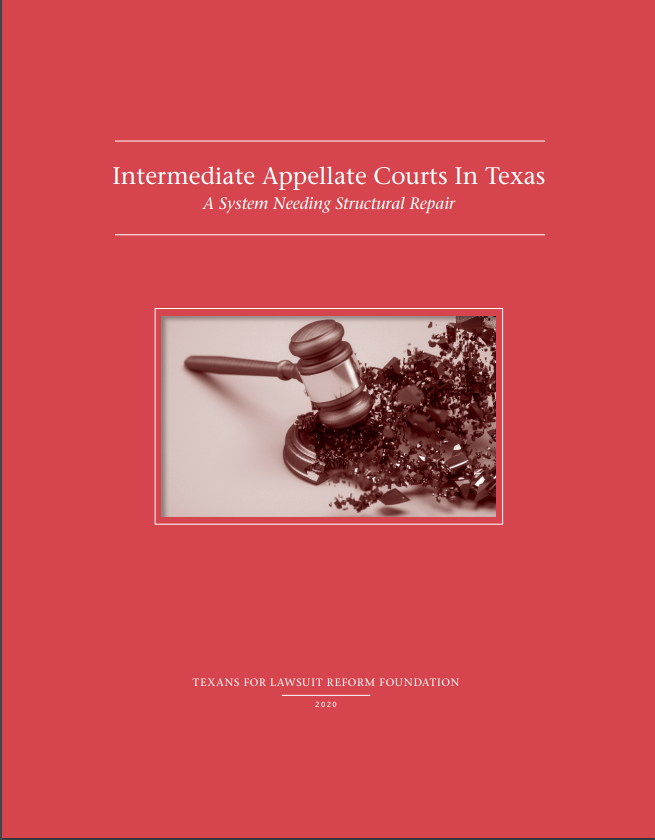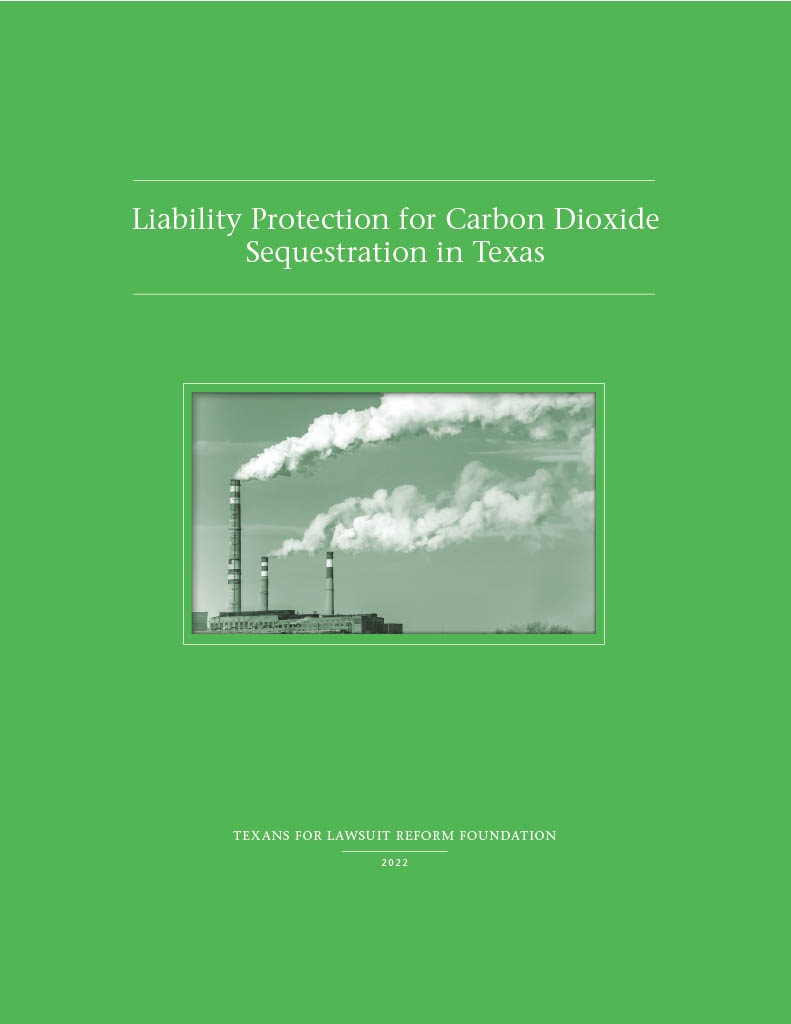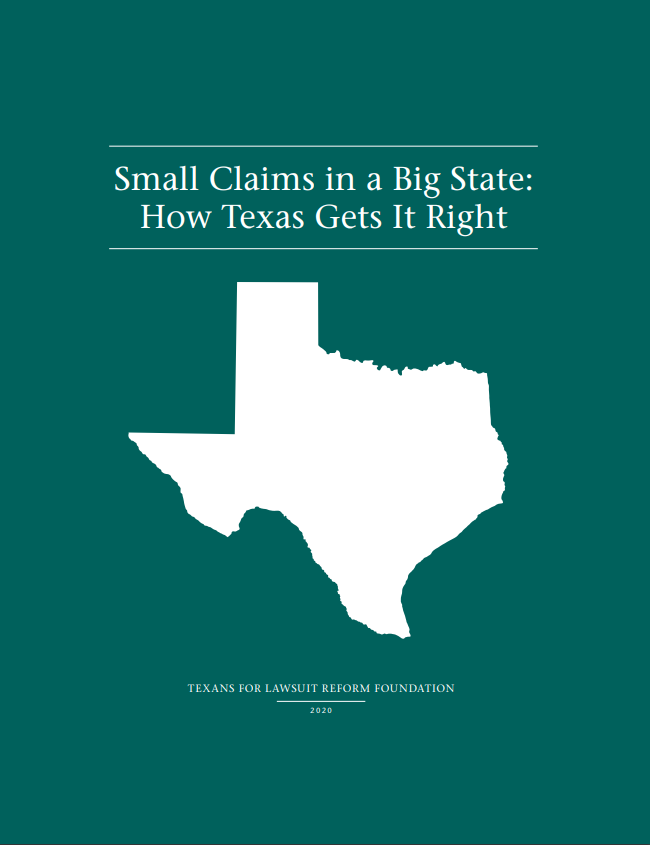Intermediate Appellate Courts in Texas: A System Needing Structural Repair
TABLE OF CONTENTS
I. INTRODUCTION
II. TEXAS’S INTERMEDIATE APPELLATE COURTS
A. History of Court Districts and Judgeships
B. Districts’ Populations and Caseloads
C. Docket Equalization
D. Operations and Productivity
- Working in Panels
- Overall Productivity
- Increases in Productivity Due to Technology
- Increases in Productivity Due to Staffing Adjustments
- Increases in Productivity Through Use of Visiting Justices
- Productivity of Clerks’ Offices
E. Court Budgets
F. Overlapping Appellate Court Districts and Bisecting Trial Court Districts
G. Uneven Distribution of Justices in Election Cycles
III. ADMINISTRATION OF THE JUDICIARY
IV. COMPARISON TO OTHER JURISDICTIONS
V. RECOMMENDATIONS
A. Commentators Have Recommended Changes for Decades
B. Merging or Redistricting the Intermediate Appellate Courts
1. Benefits of Creating New Districts
a. Reduce conflicting decisions
b. Eliminate problems from overlapping and bisecting districts
c. Reduce transfer of cases
d. Reduce “small court” problems
e. Achieve cost savings
2. Constitutional Considerations and the Voting Rights Act
3. Possible Court Districting Plans
a. Methodology
b. Criteria and assumptions underlying plans
c. Schenck’s five-district court-merger plan
d. Alternative five-district court-merger plan
e. Seven-district court-merger plan
f. Five-district plan based on administrative districts
C. Transfer Administrative Authority to Intermediate Appellate Courts
D. Reallocate Seats in Election Cycles
VI. CONCLUSION
INTRODUCTION
Texas has fourteen intermediate appellate courts. The structure of Texas’s intermediate appellate court districts is fraught with defects that create conflicts among the courts, unnecessary burdens on Texas’s two high courts, inefficiencies, and confusion.
One of the most acute defects is that the intermediate appellate courts have overlapping geographic territories. In fact, the geographic and substantive jurisdictions of each of the two Houston-based appellate courts are identical, while three other courts located in northeast Texas have overlapping boundaries. As a result, multiple Texas counties sit in two appellate court districts. No other state has appellate courts with overlapping boundaries. The trial judges in the overlapped counties answer to two different appellate courts. Consequently, in pretrial proceedings and during trial, these judges do not know which appellate court will hear an appeal of the case they are adjudicating. Therefore, they have no way to know which appellate court’s precedent to follow when ruling on motions and objections. And, because there is no system for allocating appeals between the competing appellate courts from the overlapped counties in northeast Texas, litigants in those counties often race to perfect an appeal. They do this because the first-filed notice of appeal establishes that appellate court’s “dominant jurisdiction” over the case, to the exclusion of the competing court of appeals.
Adding to the disorganization, appellate court district lines bisect multi-county trial court districts in almost every area of the state. The trial judges in these districts answer to two, three, or even four different courts of appeals. As these judges “ride their circuits,” hearing cases in the different counties located within their districts, they are required to know and correctly apply appellate court precedent that is applicable to the specific county in which trial is being held. Given the breadth of issues presented to these trial courts on a daily basis, the task is practically impossible.
Texas has the largest number of intermediate appellate courts in the nation—more than the federal system or any other state. The number of justices serving on each of the courts ranges from three to thirteen. The number of cases filed each year in these courts also varies significantly, requiring constant transfer of cases between courts to equalize their dockets. These transfers are unpopular and create their own problems. Famously, one case that was appealed three times was heard by three different intermediate appellate courts in Texas.
Another unusual aspect of Texas’s appellate court system is the allocation of justices in election cycles. Each of the eighty justices on these courts must stand for election every six years. Ideally, about one-third of the judiciary would stand for election in each cycle. Instead, forty-five of the seats appear on the ballot in one election cycle, while nineteen are on the ballot in the next cycle, and sixteen are on the ballot in the third cycle. This means that more than half the intermediate appellate court judiciary may be devoting time to campaigning for reelection the same year, thus taking away from their work on the courts. When a significant number of these justices are replaced by the voters in a single election—as happens from time to time in partisan sweeps that have nothing to do with the actual qualifications of the judicial candidates—the courts of appeals are suddenly piloted by new, often inexperienced justices who must deal with inherited caseloads that accumulated during the campaign and will continue to grow while the new justices learn the job.
There is nothing new about these problems. In 2007, Texans for Lawsuit Reform Foundation joined a chorus of voices that had been advocating for structural reform of the courts for decades. The Foundation published The Texas Judicial System, Recommendations for Reform,[1] outlining many of the problems discussed at length in this paper. This paper supplements and expands Recommendations for Reform in regard to Texas’s intermediate appellate court system, providing a detailed history of the development of Texas’s intermediate appellate courts, followed by a description of the inefficiencies and defects within the existing system and a comparison to other jurisdictions. This paper concludes with recommendations designed to repair the most obvious defects in order to achieve a more efficient and consistent structure that will benefit litigants, the judicial system, and all Texans.
II. Texas’s Intermediate Appellate Courts
A. History of Court Districts and Judgeships[2]
In 1876, Texans adopted a constitution that remains in effect today, although it has been amended hundreds of times over the fourteen decades it has been in place.[3] Article V, Section 1 of the 1876 Constitution vested judicial power in “one Supreme Court, in a Court of Appeals, in District Courts, in County Courts, in Commissioners Courts, in Courts of Justices of the Peace, and in such other courts as may be provided by law.”[4] The three-justice Supreme Court was given jurisdiction to hear appeals of judgments and interlocutory orders in civil cases emanating from the district courts.[5] A three-justice Court of Appeals was given jurisdiction of all criminal appeals and those civil appeals emanating from the county courts.[6] There was no intermediate appellate court for either civil or criminal cases.
The Texas Legislature proposed, and voters passed, an amendment to the Texas Constitution in 1891 that rewrote the judiciary article, vesting judicial power in, among others, “Courts of Appeals” and “a Court of Criminal Appeals.”[7] The revised judiciary article required the Legislature to divide the state into “not less than two nor more than three supreme judicial districts, and thereafter into such additional districts as the increase of population and business may require, and . . . establish a Court of Civil Appeals in each of said districts.”[8] The Constitution, as amended, provided that these new intermediate appellate courts were to have three justices each, with jurisdiction to hear appeals in civil cases.[9] Appeals in criminal cases were sent directly to the Court of Criminal Appeals, which had been called the “Court of Appeals” under the 1876 Constitution.[10]
Importantly, as will be discussed in the following paragraphs, the constitutional provision limiting each intermediate appellate court to three justices (which was not changed until 1978) forced the Legislature to create new appellate courts, rather than add justices to the existing courts, to meet the demands placed on the judicial system by the state’s ever-increasing population.
In 1892, the Legislature gave life to Texas’s intermediate courts of appeals, passing statutes providing that “the courts of civil appeals now or hereafter organized in this state shall consist of a chief justice and two associate justices” who were to be elected by the qualified voters of their districts.[11] The courts were given appellate jurisdiction of civil matters having more than $100 in controversy, boundary disputes, slander cases, divorce cases, and contested elections.[12] Their judgments were final as to the facts of the appealed case.[13] Because court-made rules of procedure did not yet exist, the procedures to be used by the courts to receive, hear, and decide appeals also were spelled out in the 1892 statutes.[14] The Legislature “divided [the state] into three supreme judicial districts for the purpose of constituting and organizing the courts of civil appeals therein respectively.”[15] The first court of civil appeals was to sit in Galveston, the second in Fort Worth, and the third in Austin.[16] Barely a year later, in 1893, the Legislature created the fourth and fifth courts of civil appeals, which were placed in San Antonio and Dallas.[17] Austin was the seat of government, and the other four cities in which courts were situated in 1893 were Texas’s major population centers (along with Houston).[18]
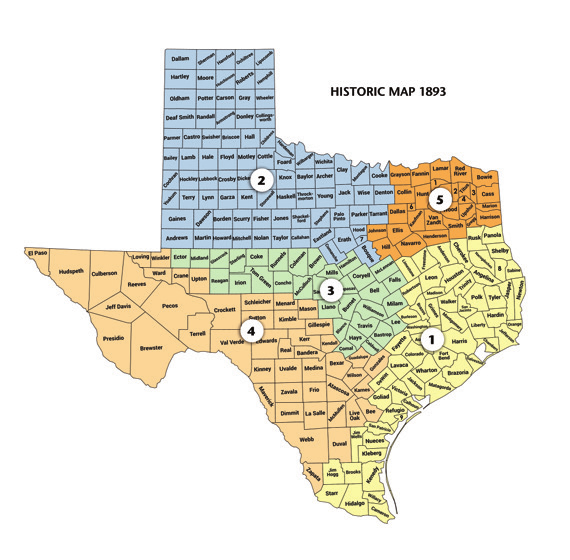
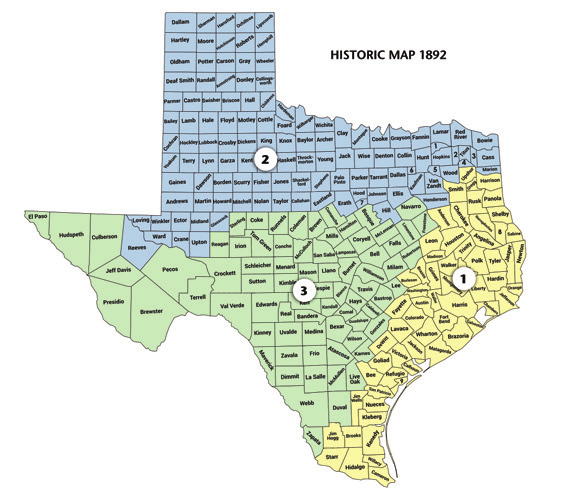
Although no legislative enactment has been found that amended the 1893 legislation allocating counties to the courts of appeals’ districts, the 1895 codification of Texas law differs in its allocation of the counties from the 1893 legislation, as shown on the preceding and following maps.[19]
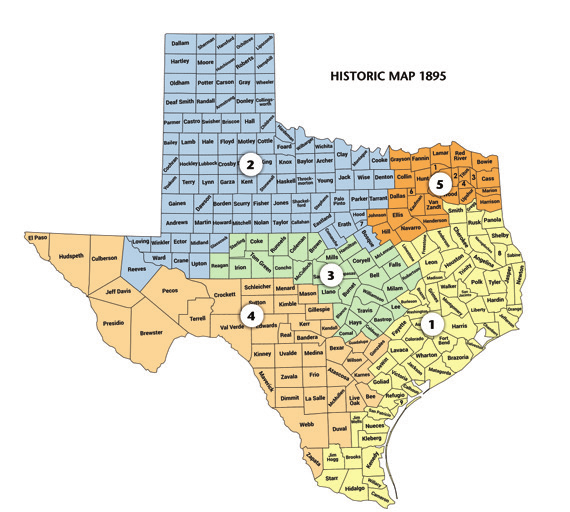
As caseloads blossomed with increases in Texas’s population, these three-justice appellate courts could not keep up with the workload, thus necessitating the creation of more and more intermediate appellate courts.[20] In 1907, the Legislature created the sixth court, which it placed in Texarkana.[21]
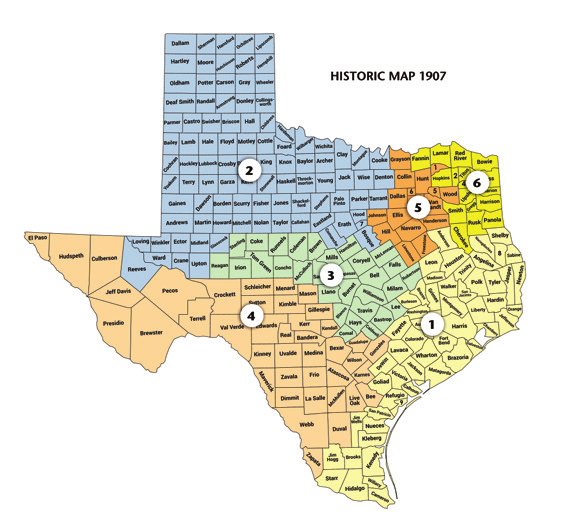
The placement of the court in Texarkana was not illogical. Texarkana (1910 population of 9,790[22]) and Tyler (1910 population of 10,400) were the largest cities in the area, and, therefore, one of the two cities would be a logical choice for locating the sixth court to serve the inhabitants of northeast Texas. Of course, it also would have been logical to increase the number of justices on the Dallas court to handle the increased caseload. Texarkana is only 180 miles from Dallas, which is a modest distance compared to the distances many lawyers would have traveled to argue cases in the appellate courts at the time. The problem with expanding the Dallas court was that the Texas Constitution allowed only three justices to serve on an intermediate appellate court,[23] and the number could not be increased by statute. The only way to relieve the Dallas court’s caseload was to create a new court.
In 1911, the seventh and eighth courts were created and placed in Amarillo and El Paso, respectively.[24] There were no courts in the western half of the state before 1911, and so the placement of a court in the Panhandle and a court in far west Texas was sensible given the great distances litigants from those areas would have been forced to travel in the pre-automobile era. Amarillo was the only city of any size in the Panhandle (1910 population of 9,957), and El Paso was one of the largest cities in the state (1910 population of 39,279).
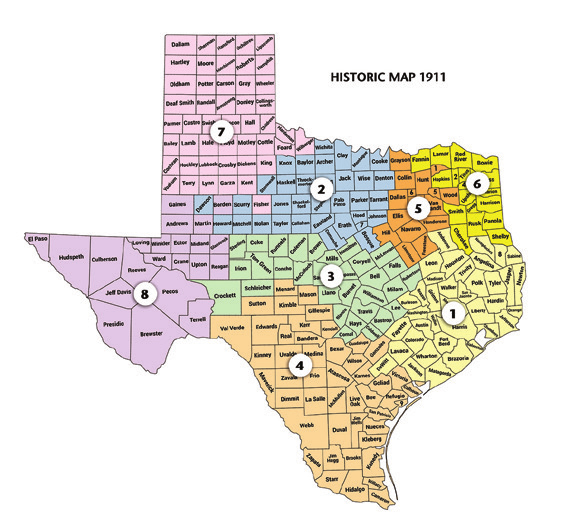
The ninth court was created in 1915 and placed in Beaumont.[25] In 1901, the famous Spindletop oil field was discovered, making Beaumont a boomtown.[26] The 1920 population of Beaumont was 40,422, having grown by 20,000 residents since 1910. Placing a court of appeals in a large and growing town would have made sense, but it also would have made sense to increase the number of justices on the Galveston court of appeals, had the Texas Constitution allowed it. Whether intentional or the result of a mistake, the 1915 legislation left Panola County in the Texarkana court’s district, but it was also included in the Beaumont court’s district.[27] This is the first instance of overlapping appellate court districts in Texas.
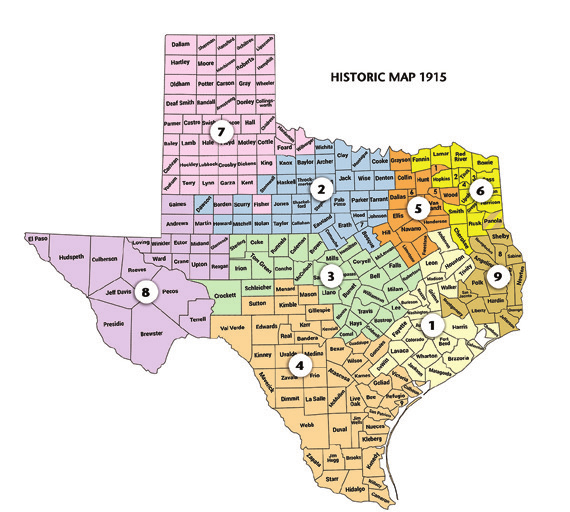
The tenth court, sited in Waco, was created in 1923.[28] Waco (1920 population of 26,425) was the largest city between Dallas/Fort Worth and Austin. If a court was needed in central Texas, Waco was perhaps the logical place to put it; but, again, increasing the size of the Austin court (about 100 miles south) or the Fort Worth court (about 90 miles north) would have addressed the caseload problem just as well. The 1923 distribution of counties resolved the first instance of overlapping districts, removing Panola County from the Beaumont court’s district and leaving it in the Texarkana court’s district.
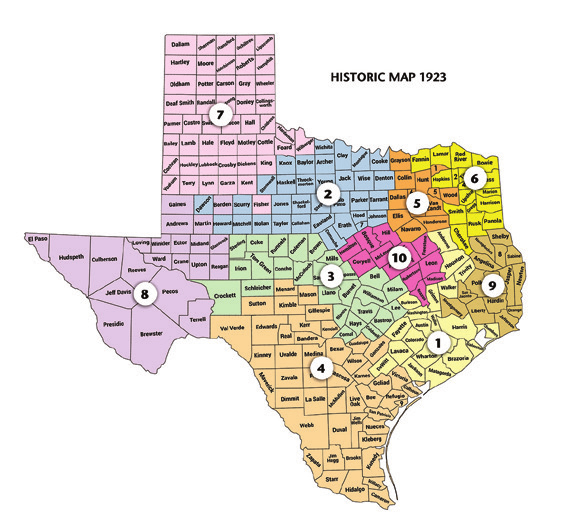
The eleventh court was placed in Eastland in 1925.[29] Location of a court in Eastland is not easily explained. Eastland’s population in 1910 was 855. It enjoyed a brief oil boom between 1910 and 1920, growing to 9,368 residents in 1920. But its population fell back to 4,648 by 1930, and the population has remained approximately the same ever since. Eastland was not far from either Fort Worth or Waco (about 95 and 130 miles, respectively), both of which already were hosting intermediate appellate courts. Abilene would appear to have been a better site for a new central-west court, if one was needed. Abilene was a larger city at the time (1920 population of 10,274 and 1930 population of 23,175), closer to the other population centers in the region (Midland and San Angelo). But for reasons that are not apparent on the face of old legislative documents, Eastland was awarded a court of appeals in 1925. It is still there today, in a county that has twenty residents per square mile.[30]
The 1925 allocation of counties created the second instance of overlapping appellate court districts. Palo Pinto County—whether intentionally or inadvertently—was put in both the Fort Worth and Eastland courts’ districts.
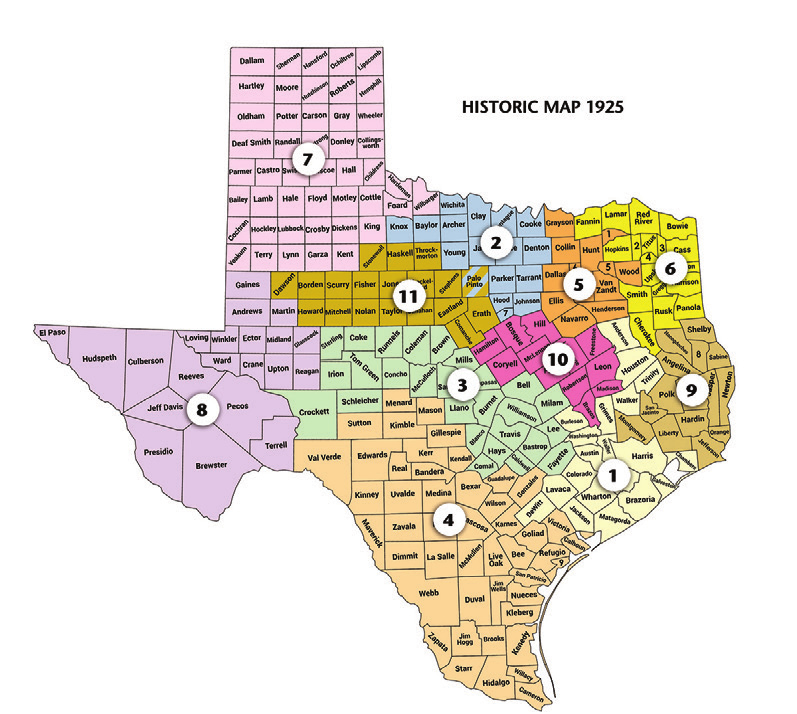
From 1927 to 1941, the Legislature altered the distribution of counties in the eleven appellate court districts several times.
- In 1927, the Legislature fixed the Palo Pinto County overlap by removing the county from the Fort Worth court’s district. It also moved fourteen other counties between appellate court districts.[31]
- In 1929, the Legislature moved Borden, Dawson, and Howard Counties from the El Paso court’s district into the Eastland court’s district, and Hood County was relocated to the Waco court’s district from the Fort Worth court’s district.[32]
- In 1932, Ellis County was removed from the Dallas court’s district and put into the Waco court’s district.[33]
- In 1934, the Legislature returned Hunt County to the Dallas court’s district, but did not remove it from the Texarkana court’s district. Instead, it included a proviso that Hunt County judgments signed in the first half of the calendar year should be taken to the Texarkana court, while judgments signed in the second half of the year should be taken to the Dallas court.[34] This created the third instance of overlapping districts, which was clearly intentional.
- In 1939, the Legislature moved DeWitt County from the Galveston court’s district to the San Antonio court’s district.[35]
- In 1941, Coleman and Brown Counties were moved from the Austin court’s district to the Eastland court’s district.[36]
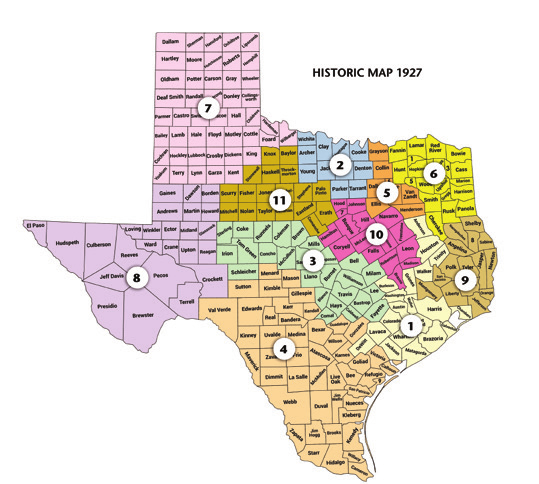
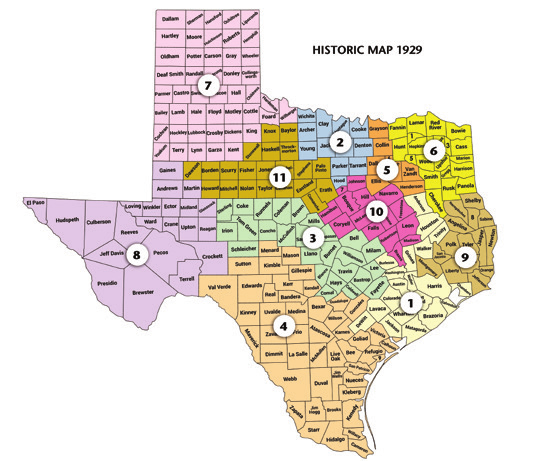
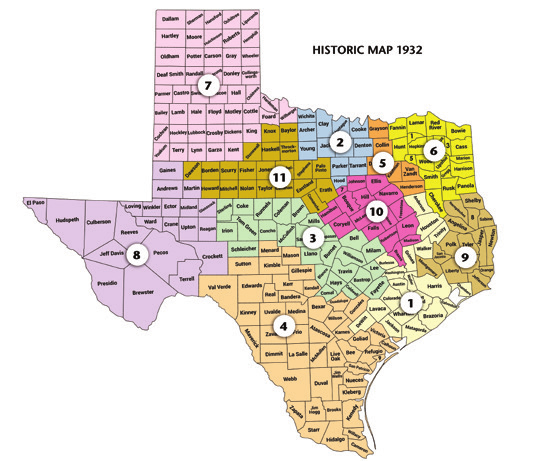
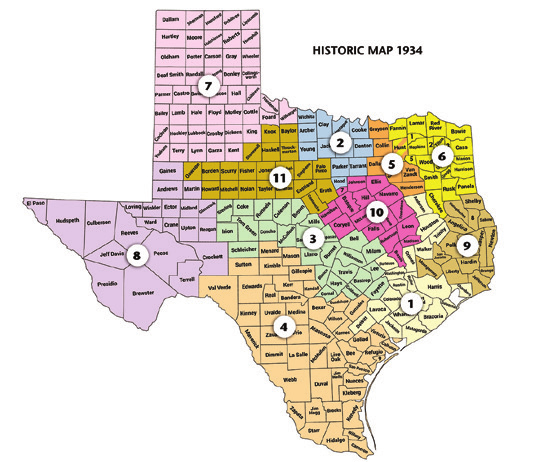
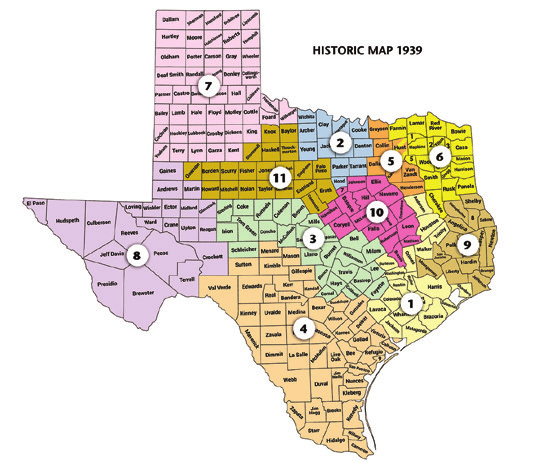
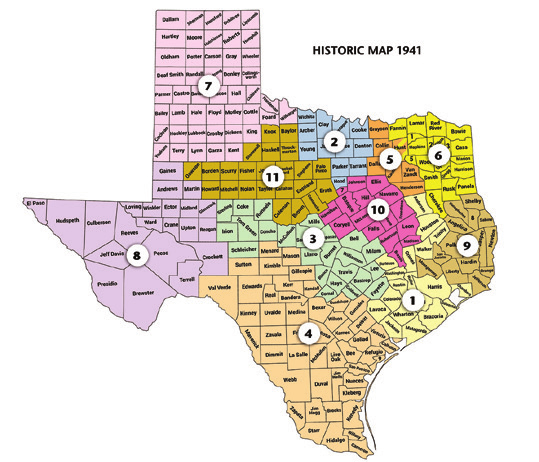
In 1957, following Hurricane Audrey, which severely damaged the Galveston County courthouse, the Legislature authorized the Galveston court (the First Court of Appeals) to sit in either Galveston or Houston.[37] It has been located in Houston ever since (along with the Fourteenth Court of Appeals, which the Legislature established in 1967, as discussed below).
In 1963, the Legislature created the twelfth and thirteenth intermediate appellate courts, locating them in Tyler and Corpus Christi.[38] The Legislature explained that the creation of the new courts was necessary because of “[t]he excessive number of cases on the dockets of the First, Fourth and Fifth Supreme Judicial Districts of Texas and the tremendous increase in litigation in these three (3) Districts [was] causing an impossible workload on the judges thereof.”[39] In a separate bill, the Legislature put Colorado County—which it had included in the new Corpus Christi court’s district only a few weeks before—into the Houston court’s district.[40] Thus, the Corpus Christi court ended up with a twenty-county district running along the Gulf Coast, from southwest of Houston to the Rio Grande Valley. The new Tyler court’s district comprised eighteen counties, ten of which were removed from nearby districts, but eight of which remained in their previous districts. When added to the Hunt County overlap created in 1934, Texas then had a total of nine counties in northeast Texas in overlapping appellate court districts.[41] As to the newest eight counties in overlapping districts, the Legislature did not devise a mechanism for allocating cases between the competing courts as it had done with Hunt County in 1934.
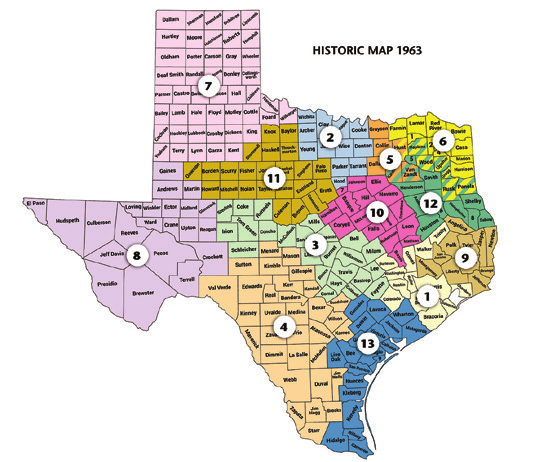
Placing a court in Tyler—which is reasonably close geographically to Dallas (100 miles), Texarkana (130 miles), and Waco (130 miles)—is difficult to understand, except for the fact that the Legislature could not increase the number of justices on the nearby courts because of the constitutional restriction of three justices per appellate court. Situating a court in Corpus Christi to serve south Texas was not illogical at the time, given (again) the fact that the number of justices on the San Antonio court could not be increased. Corpus Christi had a population of 167,690 in 1960. The Rio Grande Valley, which is served by the Corpus Christi court, had three cities with significant populations in 1960—Brownsville (48,040), Harlingen (41,207), and McAllen (32,728)—but collectively they were not as large as Corpus Christi. And Laredo, with a population of 60,678 in 1960, which was included in the district, was slightly closer to Corpus Christi than the Rio Grande Valley (the other possible site for the court).
Finally, still faced with the constitutional restriction on the number of justices who could serve on an intermediate appellate court and an increased caseload in the Houston area, the Legislature created the last of Texas’s three-justice intermediate appellate courts in 1967.[42] The fourteenth court was a mirror of the first court, having the same geographic and substantive jurisdiction. The Legislature also added Brazos County, which was in the Waco court’s district, to both Houston courts’ districts, but did not remove it from the Waco court’s district.[43] In this instance, the Legislature did not dictate the court in which an appeal from overlapping counties was to be filed, as it had with Hunt County in 1934. The Legislature, however, required the clerks of the two Houston courts to “from time to time equalize by lot or chance the dockets of the two courts.”[44]
And so, by the end of 1967, six of Texas’s fourteen intermediate appellate courts (Dallas, Texarkana, Tyler, Waco, and both Houston courts) had districts that overlapped with some other appellate court’s district.
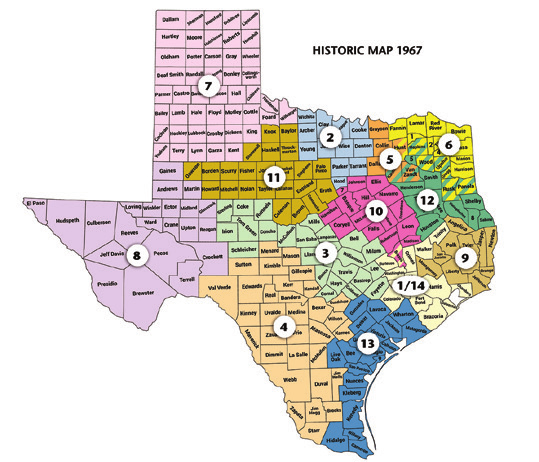
In 1975, a law was enacted allowing the Corpus Christi court to “transact its business at the county seat of any of the counties within its district, as the Court shall determine it necessary and convenient . . . .”[45] The provision was added because “the Thirteenth Supreme Judicial District encompasses a broad geographic area necessitating extensive travel on the part of litigants and attorneys.”[46] A branch of the court was subsequently created in Edinburg, and the court continues to operate today as a single court sitting in two locations.
A significant improvement to the intermediate appellate court system finally occurred in 1977, when the Legislature adopted a resolution to ask Texas voters to amend the Constitution to allow more than three justices to sit on each intermediate appellate court, and to allow the justices to hear and decide cases in three-justice “panels,” rather than having the entire court’s membership participate in all cases.[47] This change to the Constitution, which was approved by the voters in November 1978, would allow the Legislature to address the increased workload of the intermediate appellate courts without further increasing the number of courts. In the same legislative session, the Legislature passed a bill adding three justices to both Houston courts, the Dallas court, and the Fort Worth court. The expansion of these courts was contingent on the voters approving the constitutional amendment. The Houston and Dallas courts were to be expanded immediately upon approval of the amendment by the voters, and the Fort Worth court was to be expanded on January 1, 1983.[48]
By 1979, the Court of Criminal Appeals was overwhelmed with cases.[49] Consequently, the Legislature passed a resolution to ask the voters of Texas to vest the intermediate appellate courts with criminal jurisdiction (to accompany the civil jurisdiction they had possessed for eighty-eight years) and to change the name of the courts from “Courts of Civil Appeals” to “Courts of Appeals.”[50] The voters approved the constitutional amendment in November 1980. The Legislature implemented the constitutional amendment in 1981,[51] giving the intermediate appellate courts jurisdiction over criminal matters, except death penalty cases.[52] The Legislature also added twenty-five appellate justices to the courts, effective September 1981, and added three additional justices to the Austin court, effective September 1982.[53] These additions brought the total number of intermediate appellate court justices in Texas to seventy-nine. During its next legislative session, the Legislature added another justice to the Fort Worth court,[54] bringing the total number of justices on these courts to eighty, where it remains today. Texas’s estimated population in 1984 was 16,007,088,[55] meaning Texas had one intermediate appellate court justice for every 200,088 residents of the state.
In the early 2000s, the Legislature began some modest reapportionment of the intermediate appellate courts, partly to address the overlapping districts.[56] In 2003, the Legislature moved Ector, Gaines, Glasscock, Martin, and Midland Counties out of the El Paso district and into the Eastland district, which was chronically underutilized.[57] The El Paso court then was reduced from four justices to three, and the Beaumont court was increased from three justices to four.[58] The Legislature also removed Brazos County from the two Houston districts, leaving it only in the Waco district, eliminating one instance of overlapping districts.[59]
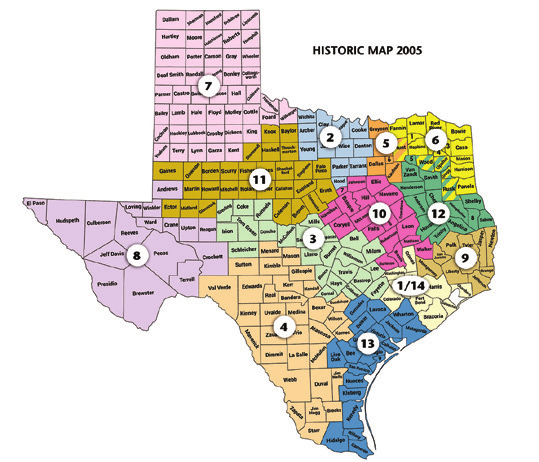
In 2005, the Legislature removed Burleson, Trinity, and Walker Counties from the two Houston districts.[60] Burleson and Walker Counties were added to the Waco district, and Trinity County was added to the Tyler district.[61] Van Zandt County was removed from the Dallas district but remained in the Tyler district.[62] Angelina County was moved from the Beaumont district to the Tyler district.[63] Hopkins, Kaufman, and Panola Counties were removed from the Tyler district, leaving Hopkins and Panola in the Texarkana district and Kaufman in the Dallas district.[64]
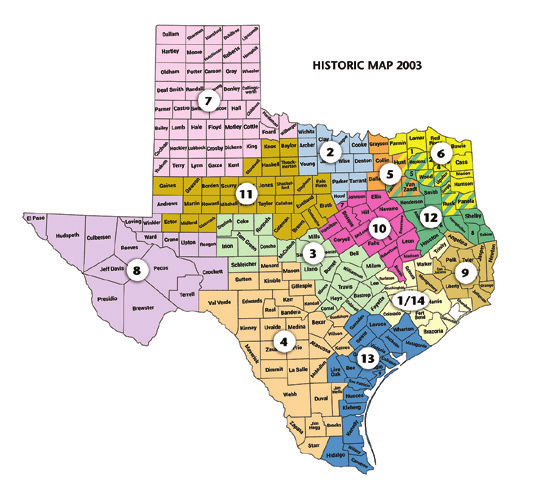
The structure of the intermediate appellate court system in Texas has remained unchanged since 2005. A total of eighty justices sit on these courts, a number that has not changed since 1984. Appellate court justices have not been reallocated since 2003, and counties have not been moved between districts since 2005. Texas’s estimated population in 2019 was 28,995,881, yielding an average population per justice of 362,449—an eighty percent increase since 1984.
There are three broad conclusions to be drawn from reviewing the structural history of the intermediate appellate courts:
- First, Texas has such a large number of intermediate courts of appeals because an artificial limit on the number of justices who could serve on an appellate court was included in the 1891 constitutional amendment. One cannot imagine the structure of this court system developing as it did in the absence of this constitutional limitation. Instead, if the number of justices on existing courts could have been increased before 1977, Texas would have fewer than fourteen intermediate appellate courts today.
- Second, the boundaries of the intermediate appellate courts have consistently changed over time. The courts’ boundaries have been altered seventeen times since the first three courts were created in 1892. Even after reaching the final number of fourteen courts, the Legislature has continued to change the courts’ boundaries.
- Third, there is no impediment to an appellate court officially sitting in more than one county, while its justices are elected by voters of the whole district. For decades, the Corpus Christi court has had branches in both Corpus Christi and Edinburg.
B. Districts’ Populations and Caseloads
Because the Texas Constitution initially permitted only three justices to serve on each of Texas’s intermediate appellate courts, the Legislature addressed the problem of increasing caseloads by creating additional courts over approximately seventy years.[65] From 1892 to 1967, the number of intermediate appellate courts increased from three to fourteen, with many of the newer courts being established in smaller metropolitan areas with lower populations and fewer cases.[66] Today, Texas’s largest intermediate appellate court (by number of justices) is located in Dallas. It has thirteen justices serving a six-county area, with one of those counties being shared with another appellate court. The two Houston courts, taken together, have eighteen justices serving a ten-county area. The five smallest courts—Texarkana, El Paso, Waco, Eastland, and Tyler—have three justices each, but larger geographic districts.[67] The Tyler court serves seventeen counties, four of which are shared with Texarkana. The Waco court serves eighteen counties. The Texarkana court hears appeals from nineteen counties, five of which are shared with either the Tyler or Dallas court. And the Eastland district covers twenty-eight counties. In terms of the number of counties served, the four-justice Amarillo court is the largest, having a district containing forty-six counties. As shown on Table 1, the population served by each court varies greatly, even on a per-justice basis.

As Table 1 shows, the Texarkana, Amarillo, Eastland, and Tyler districts are significantly underpopulated on a per-justice basis, and the Beaumont, Dallas, and El Paso districts are somewhat underpopulated. The Austin, Fort Worth, and San Antonio districts, on the other hand, are significantly overpopulated.
During the fiscal year that ended August 31, 2019,[68] 5,681 civil cases and 4,714 criminal cases were filed in Texas’s intermediate appellate courts, for a total of 10,395 filings.[69] The number of filings in 2019 is not significantly different from the ten-year average of 5,465 civil filings and 5,516 criminal filings, for a total of 10,981 new case filings per year, on average.[70] These courts’ workloads are not evenly distributed when viewed on a per-justice basis, as reflected in Table 2—at least not before docket equalization transfers are completed.

The highlighting in Table 2 shows instances when there is more than a ten percent differential between civil and criminal filings in a court (i.e., more than fifty-five percent of the appeals are of one type or the other). Five of the six “large” courts (those having six or more justices)—Austin, Corpus Christi, Dallas, Houston, and San Antonio—received more civil than criminal appeals, in many instances by large margins. Among the large courts, only Fort Worth received more criminal than civil appeals in 2019, although the difference was modest. Among the smallest courts (those having only three justices), four out of five received more criminal than civil appeals. Of the three-justice courts, only El Paso received more civil than criminal appeals.
Table 2 also shows the wide disparity in the natural caseload of the courts of appeals, at least for FY 2019. The El Paso, Amarillo, Beaumont, Texarkana, and Corpus Christi courts received too few appeals on a per-justice basis compared to their sister courts. But, as shown in Table 1, all of these courts—except Corpus Christi—sit in significantly underpopulated districts, which would naturally result in the courts receiving fewer appeals. Corpus Christi fits the pattern, but not as clearly. It sits in a district that is marginally underpopulated, yet it received meaningfully fewer appeals.
The Austin, Waco, and Tyler courts, on the other hand, received too many appeals, as did the Fort Worth and Eastland courts, to a lesser extent. Austin, Fort Worth, and Waco sit in districts that are significantly overpopulated, which accounts for these courts receiving relatively more appeals than other courts. Oddly, Eastland and Tyler sit in districts that are significantly underpopulated, yet they received relatively more appeals than other courts. Eastland’s district includes Ector and Midland Counties, in the heart of the Permian Basin, and so oil and gas-related prosecutions and litigation may have accounted for Eastland’s disproportionate caseload. The Tyler court shares four counties with the Texarkana court, and so it is possible some litigants chose to file their appeals in Tyler rather than Texarkana, thus inflating Tyler’s numbers. But the four shared counties have relatively small populations and relatively few appeals, and so even if this hypothesis is true, it cannot account for all of the increased caseload Tyler experienced in 2019.
Despite the anomalies presented in Eastland and Tyler, when Tables 1 and 2 are read together, they show that population is a sound, but not perfect, predictor of caseloads. When all of the districts having excessive population (on a per-justice basis) are aggregated, overpopulated districts have thirty-one percent more residents and receive thirteen percent more cases, while underpopulated districts have eighteen percent fewer residents and see six percent fewer cases.[71] The two Houston courts tend to prove the general point that caseloads follow population counts. The Houston district is barely underpopulated and the Houston courts’ combined caseloads are only slightly below the average.
C. Docket Equalization
Any multi-court system will have variances in caseloads. Because the 1891 amendment to the Texas Constitution limited each intermediate appellate court to three justices, the only options for docket equalization were to create more courts, temporarily assign justices to the over-worked courts, redistribute counties between existing courts, or allow the transfer of cases between the courts to equalize their dockets.
Between 1892 and 1967, the Legislature repeatedly created new appellate courts to address burgeoning caseload, and it repeatedly reconfigured the appellate courts’ districts. In addition, in 1895—only two years after creating the first five intermediate appellate courts—the Legislature passed a law compelling the Texas Supreme Court to “equalize as nearly as practicable the amount of business upon the dockets of the different courts of appeals by directing the transfer of cases from such of said courts as may have the great number of cases upon their dockets to those having a less amount of business upon their dockets.”[72]
The statutory provision requiring the Supreme Court to transfer cases to equalize the intermediate appellate court dockets remained law until 1984.[73] In 1985, when court-related provisions of the Texas Revised Civil Statutes were recodified into the new Texas Government Code, the old provision for transferring cases between courts of appeals to equalize dockets was generalized to provide: “The supreme court may order cases transferred from one court of appeals to another at any time that, in the opinion of the supreme court, there is good cause for the transfer.”[74]
In 1999, however, the Legislature returned to explicitly requiring the Supreme Court to transfer cases among the courts of appeals for docket equalization, stating in the general appropriations act, “It is the intent of the Legislature that the Supreme Court equalize the dockets of the fourteen courts of appeals. Equalization shall be considered achieved if the new cases filed each year per justice are equalized by ten percent or less among all the courts of appeals.”[75] The shortcoming of this legislative mandate is that it treats all appeals—civil, criminal, family, administrative, and others—equally. Nonetheless, the ten percent equalization mandate remained in each general appropriations act through the 85th Legislature in 2017,[76] effectively preventing the Supreme Court from equalizing workloads based on any factors other than the number of justices and the number of cases. The mandate, however, was not included in the general appropriations act passed by the 86th Legislature in 2019.[77] Presumably, then, the Supreme Court once again has discretion in transferring cases between the intermediate appellate courts.
For decades, the Texas Supreme Court has transferred cases among the courts of appeals to equalize these courts’ dockets[78] without choosing specific cases, or types of cases, to transfer. Instead, it orders the transfer of the first number of cases filed in a court of appeals on or after a specified date, but excludes original proceedings, appeals in cases involving termination of parental rights, and “those cases that, in the opinion of the Chief Justice of the transferring court, contain extraordinary circumstances or circumstances indicating that emergency action may be required.”[79]
As shown on Table 3, over the thirty-five-year period since the creation of the eightieth intermediate appellate court judgeship in 1983, the courts in Texarkana, Amarillo, El Paso, Eastland, and Corpus Christi have tended to have lighter caseloads relative to other courts, and are therefore the recipients of transferred cases. For a great majority of years, the Dallas court was overburdened and sending cases to other courts. Beyond that, it is difficult to discern any trends that have lasted through the entire period from 1984 to 2019.

In FY 2019, the Supreme Court transferred 442 cases—about 4.3 percent of the appeals filed in that fiscal year—between the courts of appeals to help equalize dockets.[80] The Fort Worth, Austin, San Antonio, Waco, Eastland, and Tyler courts were transferor courts. The remaining courts were transferee courts. After these transfers, the caseload variance was under ten percent for all courts, except El Paso and Beaumont, as shown in Table 4.

After the equalization transfers were made, all of the courts having six or more justices handled more civil appeals than criminal appeals, while all of the courts having four or fewer justices, except the Beaumont and El Paso courts, handled more criminal appeals than civil appeals. The dockets of the Beaumont and El Paso courts were almost evenly divided between civil and criminal cases.
Today, the Texas Government Code provides a number of rules governing transferred cases, several of which are designed to ease the burden on the parties and their attorneys. The justices of the court of appeals to which a case is transferred must hear oral argument at the place from which the case was transferred, with two exceptions:[81] First, the parties may collectively request the case be heard by the transferee court in its own courtroom.[82] Second, if the transferor court regularly sits in a place that is thirty-five or fewer miles from a place where the transferor court regularly sits, then the transferee court can choose to hear the case in the place where it regularly sits.[83] In addition, at the discretion of the chief justice of the transferee court, the court may hear oral argument in a transferred case through the use of teleconferencing technology.[84]
Docket equalization, and the resulting transfer of cases, is generally unpopular with litigants, lawyers, and justices. In one instance, for example, three appeals in the same case were heard by three different courts of appeals. In Harris County v. Walsweer, the plaintiff was shot by law enforcement officers while outside his estranged wife’s house.[85] Later, he sued the officers and their employer, Harris County, for the injuries he suffered in the confrontation.[86] Trial resulted in an instructed verdict against Harris County and a multimillion-dollar judgment against the officers.[87] An appeal was taken and the case transferred to the Eastland Court of Appeals to equalize dockets.[88] The Eastland court affirmed the judgment against the officers and reversed the judgment in favor of Harris County.[89] On remand, the Harris County trial court entered a summary judgment, holding that Harris County was liable to pay the judgment rendered against the officers because they acted in their official capacities.[90] Harris County appealed, and this appeal was transferred to the Texarkana Court of Appeals to equalize dockets.[91] The Texarkana court reversed the judgment because the summary judgment record was deficient, and remanded the case to the trial court for further proceedings.[92] On remand from the second appeal, the trial court entered another summary judgment against Harris County for the plaintiff’s damages.[93] A third appeal was taken.[94] This time, the case was not transferred, but, instead, it was decided by Houston’s First Court of Appeals. The Houston court affirmed the judgment against Harris County.[95] Thus, one case yielded three appeals to three different courts.
In addition to the prospect of having serial appeals decided by different courts, the transferring of cases, according to a State Bar of Texas task force, causes “significant inefficiencies for parties, courts and clerks [and] diminish[es] the electorate’s ability to hold elected judicial officials accountable, requires citizens to bear the cost of deciding excess appeals from outside the region, and undermines a justice’s ethical obligation to handle cases filed in that court.”[96]
This Foundation stated in a 2007 report:
Docket-equalization transfers are disliked . . . . Some commentators argue that different local rules or the unfamiliarity of arguing in a transferee court may affect litigants, and some attorneys believe that a transferee court is more apt to reverse a transferred case than a case arising in its own district. The uncertainty caused by the transfer of cases may well affect judges as well. One appellate judge noted that it is “fundamentally unfair for the trial judge[’s] conduct to be determined by standards subject to the whims of the transfer system.” [97]
Additionally, in at least one instance, docket equalization did not work as intended. In April 2018, the Texas Supreme Court issued five administrative orders on a single day, transferring back a total of eighty-two cases previously sent to the El Paso court and returning those cases to the five different transferor courts from which they originated.[98] Many of those cases had been pending for more than three years.[99] This means that the parties and attorneys involved in the cases filed appeals, then had the cases transferred to the El Paso court from their local appellate court districts where the lower court proceedings had occurred, and watched as the cases languished in the El Paso court for several years, only to have the cases then transferred back to the originating appellate court for disposition. The years of delay doubtless added untold costs and anguish to the litigants. The cases involved matters such as property disputes, divorce disputes, administrative law matters, taxation cases, and business cases, among others, which can be negatively impacted by the passage of time.
One of the major criticisms of docket equalization transfers[100] was remedied by the Texas Supreme Court in 2008, when the Court promulgated a rule to deal with the use of precedent in transferred cases. The problem was that transferred cases were tried under precedent established by the court of appeals for the district in which the trial court was located, but reviewed by a different court of appeals applying its own precedent, which might be inconsistent or conflicting. The Supreme Court promulgated an appellate procedure rule providing that in cases transferred from one court of appeals to another, the transferee court must decide the case in accordance with the precedent of the transferor court.[101] “The rule requires the transferee court to ‘stand in the shoes’ of the transferor court so that an appellate transfer will not produce a different outcome, based on application of substantive law, than would have resulted had the case not been transferred.”[102] The transferee court’s opinion may state whether the outcome would have been different had the transferee court not been required to decide the case in accordance with the transferor court’s precedent.[103] The transferee court is not, however, required to follow the transferor court’s local rules or otherwise supplant its own local procedures with those of the transferor court.[104]
D. Operations and Productivity
- Working in Panels
Texas’s intermediate appellate courts had three justices each until a constitutional amendment passed in 1978 allowing the Legislature to add justices to the courts. Thus, until the number of justices began to increase in the late 1970s, the justices on the courts sat en banc to decide cases, meaning each case was heard by all the justices on the court. Upon passage of the constitutional amendment in 1978, an additional three justices were added to both Houston courts and the Dallas court, and the statute was amended to provide that these courts had to “sit in panels of not less than three Justices.”[105] As justices were added to the courts (largely in 1981), the requirement that courts having more than three justices sit in panels of “not less than three” remained in effect.[106] Today, Texas’s intermediate appellate courts are required to sit in three-justice panels.[107] The method used to assign justices to panels with more than three justices is not dictated by statute or rule and is not uniform.[108] But the panels must rotate, at least to some extent.[109] All of the courts rotate panel assignments in some way to avoid “doctrinal disharmony” on the court, as described by one appellate court justice:
With a fixed panel, the risk of the court’s doctrinal disharmony rises. For example, a court of nine justices working as three-justice, non-rotating panels could tend to become, in effect, three separate tribunals and lose doctrinal coherence. It would defeat the purpose of adding justices to a court to have decisions of a fixed tribunal be reviewed by the entire court sitting en banc. Appellate justices are fully occupied with hearings on their three-justice panels, and sitting en banc interferes with their normal work and draws time and energy away from their regular duties. As a result, appellate justices on larger courts disfavor having many en banc hearings.
This concern of maintaining doctrinal coherence is reduced when the court sits in rotating three-justice panels. The justices are few enough so that each can frequently sit with the others, and they are apt to develop a measure of collegiality. This allows justices to be aware of all panel opinions and be familiar with the entire range of the court’s jurisprudence. All of the courts of appeals in Texas that have expanded beyond three justices have adopted the panel rotation model. However, each has developed its own internal procedures for how these panels are constituted and their time duration.[110]
- Overall Productivity
Texas’s intermediate appellate courts reached their full complement of eighty justices on September 1, 1983. Texas’s estimated population the following year was 16,007,088,[111] meaning Texas had one intermediate appellate court justice for every 200,088 residents of the state. These 16 million Texans generated 7,386 appeals in the fiscal year that ended August 31, 1984—3,120 civil cases and 4,266 criminal cases—or about 4.6 appeals per 100,000 residents.[112] The courts disposed of 8,274 cases (a 112 percent clearance rate) during that fiscal year, ending the year with 5,717 pending cases, down from 6,605 at the end of the prior fiscal year.[113] The justices wrote 7,841 opinions—an average of ninety-eight opinions per justice.[114] Sixty-four percent of the opinions were original opinions on the merits and twenty-seven percent were per curiam opinions.[115] The average time between submission (the date the case is argued or the date the case is officially under review by the court when argument is not held) and disposition was 2.3 months for civil cases and 1.5 months for criminal cases.
Thirty-five years later—during the fiscal year ending August 31, 2019—the intermediate appellate courts received 10,395 cases—5,681 civil and 4,714 criminal cases. They disposed of 10,294 cases during the year (a ninety-nine percent clearance rate) and issued 9,897 opinions, an average of 124 per justice. Sixty-three percent of the opinions were original opinions on the merits, and twenty-five percent were per curiam opinions.[116] There were 6,509 cases pending at the end of the fiscal year. On average, the time between submission and disposition was 1.5 months for civil cases and 1.4 months for criminal cases in FY 2019.[117]
Texas’s estimated population in 2019 was 28,995,881, yielding an average population per appellate court justice of 362,449—an eighty percent increase since 1984. Even though Texas’s population increased by eighty percent over the thirty-five-year period, the number of appeals filed in the courts increased only forty-one percent over the same time period. In FY 1984, about forty-two percent of the appeals were civil cases and fifty-eight percent were criminal cases. In FY 2019, civil case filings significantly outpaced criminal case filings by about a fifty-five percent to forty-five percent margin.[118] The reason for the transformation from mostly criminal to mostly civil cases is not apparent from the historical documents. The number of dispositions and opinions increased over the thirty-five-year period, but only twenty-five and twenty-six percent, respectively. The number of cases that remained pending at the end of the fiscal year increased about fourteen percent, from 5,717 to 6,509. The number of appeals per 10,000 population decreased to 3.6 in FY 2019 from 4.6 in FY 1984.
Chart 1 shows the number of cases filed in, and disposed of by, the courts of appeals for each fiscal year since 1984.
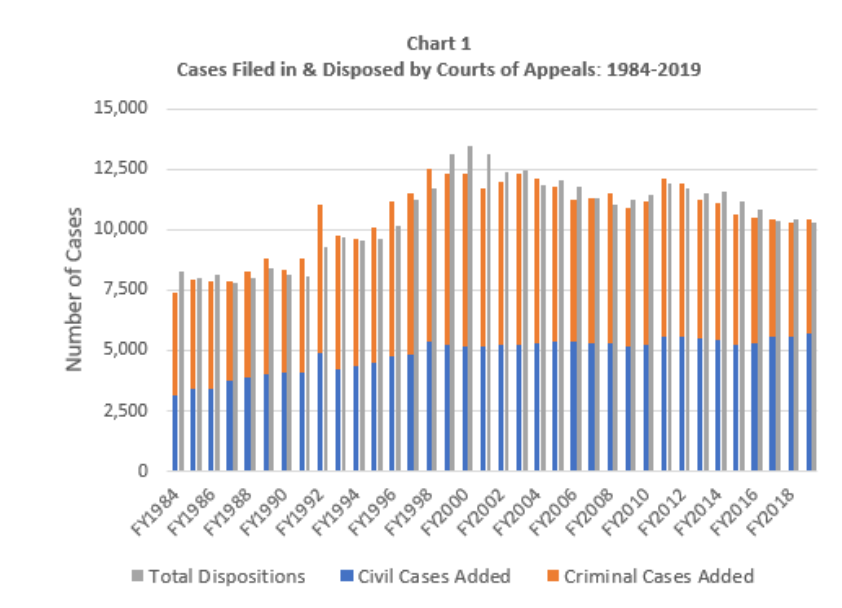
The data shows that, while Texas’s appellate courts are busier in 2019 than they were thirty-five years earlier, the increased population is not generating the number of appeals that might have been expected. In other words, the courts are not as busy as an eighty percent increase in population would suggest they should be.
A large number of cases were transferred from the Court of Criminal Appeals to the intermediate appellate courts when they were given criminal jurisdiction in 1981,[119] thus increasing these courts’ backlogs. As Chart 2 shows, Texas’s intermediate appellate courts began falling farther behind each year, beginning in FY 1987. By FY 1998, the backlog exceeded 11,500 cases—a number exceeding a full year of new case filings. The courts began to chip away at the backlog in FY 1999, largely through the use of visiting justices.[120] In most years since FY 1999, the courts’ collective clearance rate—the number of disposed cases as a percentage of the number of new cases—has exceeded 100 percent, as shown in Chart 1. As a result, the courts have reduced the backlog by forty-four percent since FY 1998. Chart 2 shows the number of cases still pending in the courts at the end of each fiscal year.[121]
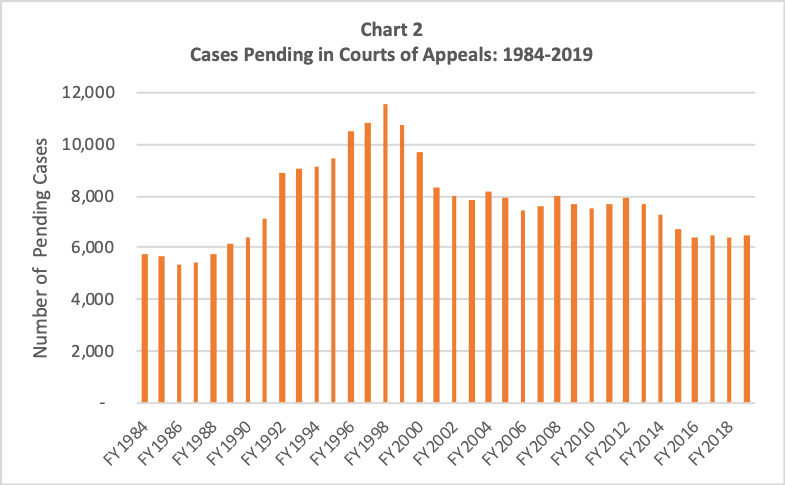
The reduction of the backlog means the courts are able to dispose of cases fairly expeditiously. Over the most recent ten years, the average time from submission to disposition of criminal cases is 1.6 months, while the average time for civil cases is 1.8 months. It takes 7.8 months, on average, from the date a civil appeal is filed to the date it is resolved. The average for criminal cases is 8.9 months from filing to disposition. Thus, whether it is a civil or criminal case, Texans can expect a resolution of their appeals, on average, within nine months after the appellate process is commenced.
Unquestionably, the eighty justices serving on Texas’s appellate courts are more productive today than they were thirty-five years ago. They are handling more appeals and writing more opinions every year than they did in 1984. These courts’ increase in productivity appears to be attributable to three major factors—technology, staffing, and visiting justices—which are discussed in the following sections.
- Increases in Productivity Due to Technology
On December 11, 2012, the Texas Supreme Court handed down an order requiring the electronic filing of all documents in civil cases in the Supreme Court, courts of appeals, district courts, statutory county courts, constitutional county courts, and statutory probate courts.[122] The Court’s introduction to its order explained:
Disputes in court require the exchange of information. The primary medium of that exchange has been paper. Texas courts have struggled for over a century to process, manage, and store court documents. With the information age, it is now possible to receive and store those documents digitally. Texas courts first experimented with this new medium in the 1990s when two district courts urged lawyers to file documents electronically. The benefits were immediate. With electronic filing, storage expenses decreased dramatically. Clerks that formerly spent time sorting and file-stamping documents could be assigned to more productive activities. Documents were no longer damaged or lost. The public, lawyers, and judges could instantly access vital pleadings, accelerating the progress of litigation. These efficiencies prompted the judiciary to initiate a pilot project in January 2003 to test and refine the e-filing model. That model was instituted statewide in 2004 . . . .[123]
The Court ordered that “E-filing will be mandatory in civil cases . . . [and] attorneys must e-file all documents in civil cases, except documents exempted by rules adopted by this Court . . . .”[124] Electronic filing in civil cases in the courts of appeals was to begin on January 1, 2014.[125] Electronic filing in civil cases was phased in for trial courts, with courts in small-population counties having until July 1, 2016, to implement electronic filing.[126]
On June 30, 2016, the Court of Criminal Appeals followed the Supreme Court’s lead.[127] “Having observed the transition to electronic filing in the Court and in civil cases in other appellate courts and district and county courts . . . , this Court has concluded that mandatory electronic filing in criminal cases will promote the efficient and uniform administration of justice in Texas courts.”[128] The appellate courts were to begin immediately. Electronic filing in the trial courts was phased in, with the smallest counties having until January 1, 2020.[129]
At this point, electronic filing is mandatory for all attorneys filing civil, family, probate, or criminal cases in the Supreme Court, Court of Criminal Appeals, courts of appeals, district courts, and county courts in Texas. Non-attorneys are encouraged to file electronically as well, although not required to do so. Thus, all trial courts that send appeals to Texas’s intermediate appellate courts receive pleadings, motions, and other documents through an internet-based electronic-filing system. The courts of appeals have been receiving appellate briefs in electronic form, almost exclusively, for several years.
Broadly speaking, the appellate process follows these steps:
- A party who is unhappy with a trial court’s judgment files a notice of appeal to begin an appeal.[130] This person (the appellant) also requests that the appellate record be prepared and filed with the court of appeals.[131]
- The appellate record consists of two parts: the clerk’s record and the reporter’s record.[132] The clerk’s record includes the items (mostly documents) filed with the trial court clerk while the case is proceeding.[133] The reporter’s record is the transcript of pre-trial hearings and trial. It includes the exhibits offered into evidence at trial.[134]
- After the two parts of the record are sent to the court of appeals, the parties must file their briefs.[135] The appellant files a brief to which the other party (the appellee) responds.[136] The appellant may file a second brief, replying to the appellee’s response.[137] In their briefs, the parties may request the opportunity to present oral arguments to the court of appeals.[138]
- After the briefing is completed, the court of appeals may order oral argument (whether requested or not), or the court may inform the parties that it will decide the appeal on the papers.[139] For cases in which oral argument is allowed, the case is considered submitted at the conclusion of the argument. For cases in which oral argument is not allowed, the case is considered submitted after briefing is complete.[140]
- After submission, the court of appeals writes an opinion, and the appellate court clerk issues a judgment in accordance with the opinion.[141] The judgment will either affirm or reverse the trial court’s judgment.[142] The time between submission and decision averages less than two months for Texas’s intermediate courts of appeals.[143] That is to say, the justices review the appellate record, study the parties’ briefs, conduct legal research, and write an opinion, all in less than sixty days, on average.
Before electronic filing rules were implemented, the trial court clerk prepared the clerk’s record by gathering the documents, hand-numbering the pages from beginning to end, preparing an index and a cover, and binding everything together with an official certificate. Then the clerk’s record was sent to the court of appeals. In complex cases, the clerk’s record might consist of several thousand pages gathered into multiple volumes.
To create the reporter’s record, the court reporter transcribed the notes taken at hearings and trial, printed the transcript on paper, and prepared an index and cover. The court reporter also gathered, organized, and indexed the exhibits offered into evidence at trial. Everything was bound together with an official certificate and sent to the court of appeals. In cases in which trial took weeks or months, the reporter’s record could consist of thousands of pages bound into multiple volumes.
Each volume of the appellate record was bound and sealed so that it would be obvious if someone tampered with it, which made it difficult to copy and use. The appellate court clerk was (and remains today) tasked with prodding the trial court clerk and reporter to ensure the record was timely filed.[144]
Lawyers having financial resources often paid for a copy of the clerk’s and reporter’s records, which they received when the record was filed. Lawyers lacking sufficient resources to obtain a copy of the appellate record would withdraw it from the appellate clerk’s office to prepare the necessary brief. Because briefing is a back-and-forth activity, the record would be withdrawn and returned by the appellant, then withdrawn and returned by the appellee, and withdrawn and returned again by the appellant. All of this activity required the appellate court clerk’s direct involvement and supervision. Handling and organizing appellate records took a substantial amount of time for appellate court clerks, and storing paper records required substantial amounts of space.
Until the 1980s, legal research was conducted in a library full of books. Many of the books were indexes of other books, used to locate statutes, opinions, and other authorities within the vast number of books in the library. Most briefs were typewritten until the early 1980s, with the final version being copied, covered, and bound for filing. Even after computers replaced typewriters, briefs were printed, copied, covered, and bound for filing, until electronic filing was implemented. Again, the appellate court clerk was required to organize and manage all of these paper briefs.
Obviously, lawyers were required to travel to the court of appeals to present oral argument, and still must. But before the advent of overnight delivery services largely negated the need for this travel, a lawyer or the lawyer’s staff often traveled to the court of appeals to file briefs and motions, and to pick up and return the appellate record.
Today, the appellate process bears little resemblance to the one just described. Virtually all items included in the clerk’s record will have been filed with the trial court in electronic form via the internet. The trial court clerk does not gather, number, index, or bind paper documents to create a clerk’s record. Instead, the clerk’s record consists of an accumulation of electronic files sent to the court of appeals and the parties’ lawyers via the internet. The same is largely true for the reporter’s record, although it is not uncommon for trial court exhibits to exist in physical form that must be organized and shipped to the appellate court. But, broadly speaking, the process of preparing a reporter’s record is orders of magnitude easier than it was fifty or even twenty-five years ago. Appellate court clerks are no longer burdened with paper records or paper briefs.
The lawyers conduct legal research using computers that access and sift through massive databases containing every imaginable opinion, statute, or other authority. Briefs are written on computers and filed electronically. The briefs are internally hyperlinked, so that the reader—a justice writing an opinion—can “jump” to specific sections of the brief and instantly see statutes, opinions, and other authorities relied upon in the brief. A lawyer must travel to an appellate court only to present oral argument in those cases in which oral argument is requested and granted.
The court’s opinions, too, are written on computer and released to the parties and public by electronic means. Like the outside lawyers, justices and the lawyers working with the justices to draft opinions conduct research through internet-based databases. They can look at the appellate record on their computer screen and search it electronically. They can write opinions—the fundamental aspect of an appellate justice’s job—from any location where internet access is available. For the most part, the justices must appear in the courthouse only for oral arguments and court conferences.
Unquestionably, technology has helped both the justices and clerks working in Texas’s intermediate appellate courts become more efficient, which partly explains how the courts of appeals have been able to handle an increased workload generated by an increased population without the creation of new judgeships.
- Increases in Productivity Due to Staffing Adjustments
Increases in productivity also are attributable to an enhanced professional staff at the intermediate appellate courts. Of course, appellate court justices do not work alone, and have not worked alone for decades. But the number of lawyers and other professionals employed by these courts to help the justices digest appellate records, conduct legal research, and write opinions has increased over time.
In the beginning, the justices on the courts of appeals conducted research, reviewed the record, and wrote opinions on their own.[145] In 1942–1943, each of the courts had a clerk, two deputy clerks/stenographers, and a porter, in addition to three justices.[146] By the mid-1970s, most of the courts had begun using law clerks (recent law school graduates who worked for the court for a fixed period of time) to assist the justices in opinion writing. The two Houston courts and the Amarillo court had three law clerks each; the Dallas, Corpus Christi, El Paso, San Antonio, and Tyler courts had two law clerks each; the Austin, Beaumont, Fort Worth, and Texarkana courts had a single law clerk each; and the justices on the courts in Eastland and Waco continued to work without attorney assistance.[147] The permanent position of “legal counselor”—now called a “staff attorney”—was created in 1978, when the Dallas and Houston courts were expanded to six justices each.[148]
It was not until September 1, 1979, that each justice on all fourteen courts had his or her own law clerk.[149] The intermediate appellate courts were given criminal jurisdiction in 1981, which essentially doubled their workloads.[150] The number of justices on the courts increased from fifty-one to eighty by September 1, 1983. In 1983, the Legislature also dramatically increased the professional staff of the courts of appeals.[151] The Legislature appropriated funds so each justice would have a briefing attorney (formerly called a law clerk), and each court would have at least one permanent staff attorney, although all the large courts had many more than one. The total number of employees, excluding the justices themselves, was 279 in 1984, categorized as shown in Table 5.

In FY 2019, the courts of appeals employed 330 attorneys, clerks, and others (as shown in Table 6), not including the justices themselves. This is an eighteen percent increase from FY 1984—but a substantially smaller increase than the growth in population (eighty percent) or the rise in caseload (forty-one percent). The number of attorneys (including law clerks), however, has increased from 135 to 203, a fifty percent increase. Sixty-two percent of the courts’ employees were attorneys in FY 2019, compared to forty-eight percent in 1984. There were sixty-four secretaries in 1984, but only nine secretaries/administrative assistants in FY 2019. No court had a person with the title of legal assistant in FY 1984. In 2019, 26.5 legal assistants (non-lawyer having some legal training) were employed by the courts. The number of court clerks (the clerk of the court and all deputy clerks) has increased insignificantly—from sixty-seven to seventy—in the thirty-five years between 1984 and 2019.

The trends are obvious: the courts are relying on staff attorneys and legal assistants (but not temporary briefing attorneys/law clerks) to handle the ever-increasing caseloads, while the need for personnel to actually hammer out opinions on a typewriter or computer keyboard has fallen dramatically, and technological innovations have allowed the clerks’ offices to become substantially more efficient.
- Increases in Productivity Through Use of Visiting Justices
Before the intermediate appellate courts were given criminal jurisdiction in 1981, visiting justices (judges sitting temporarily through an assignment made by the Texas Supreme Court) were seldom used to help the courts manage their caseloads.[154] That began to change in FY 1985, when 215 opinions were authored by “assigned justices.”[155] The number dropped to seventy-four in FY 1987, but then began a sharp rise, reaching a high of 1,474 opinions by assigned justices in FY 2000. Graphically, the spike in the use of visiting justices as depicted in Chart 3 corresponds to the arch in the number of pending cases in Chart 2, thus showing that the use of visiting justices was a key to reducing the courts’ backlog in the early 2000s.
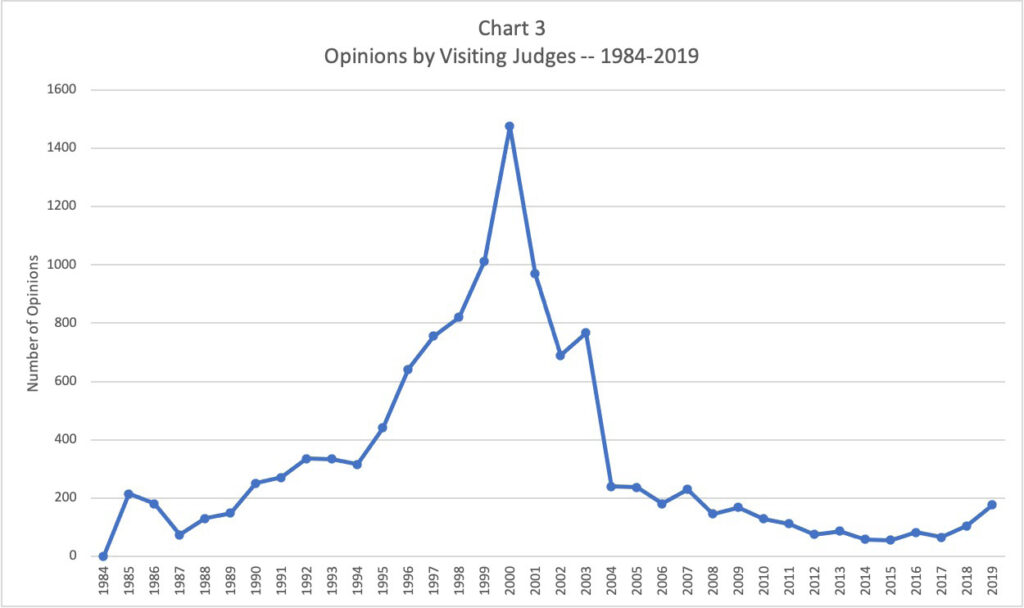
The number of opinions written by visiting justices fell precipitously in FY 2004, to 240, and trended downward from FY 2004 to FY 2017, when sixty-six opinions were authored by visiting justices. The number of opinions by visiting justices increased in FY 2018 and FY 2019 because a regular justice on the Eastland court was not writing opinions due to illness. Presumably, this increase is temporary and the status quo ante will return in FY 2020. The courts will, it is assumed, keep pace with filings without the extensive use of visiting justices going forward.
In sum, the courts of appeals can and do use visiting justices to handle their caseloads. The use of visiting justices has been relatively modest over the past decade, but if caseloads were to increase significantly for a particular court, or for the system as a whole, the assignment of visiting justices remains an avenue for ensuring caseloads do not become unmanageable.
- Productivity of Clerks’ Offices
The productivity of the clerks’ offices appears to vary greatly between the courts of appeals. The Constitution provides that each court must appoint a clerk of the court.[156] In addition to the official clerk of the court, all of the clerks’ offices have at least one deputy clerk, and most have more than one deputy, as reflected in Table 7. The Amarillo, Beaumont, and Tyler courts each have a clerk and one deputy clerk. Based solely on the number of new cases handled by the offices, these clerks’ offices are the three busiest in the state. The Dallas court’s clerk’s office also is quite busy. On the other end of the spectrum are the Waco, El Paso, and Eastland clerks’ offices, which—based solely on the number of new cases handled by the offices—appear to be overstaffed.

Each person in the Waco court’s clerk’s office handled only sixty-nine new appellate files in 2019, while each person in the Amarillo court’s clerk’s office handled 253 new appellate files that year—almost four times more. There may, however, be aspects of the clerks’ work being done by other court personnel in busier offices that is not apparent from the public record. Similarly, clerks in what appear to be less productive offices may have responsibilities not shared by clerks on other courts.
E. Court Budgets
Although subject to the appropriations process that is applicable to all governmental entities, Texas’s intermediate appellate courts decide for themselves how they will spend funds allocated to them by the Legislature. The Legislature simply appropriates an amount of money to be provided to each appellate court each biennium and leaves it to each court to make spending decisions.[157] Some courts—like the two Houston courts—use a combination of staff attorneys assigned to a pool and staff attorneys assigned to specific justices to help with opinion writing. On other courts, all staff attorneys are assigned to a specific justice. Some courts—including Austin and San Antonio—have a staff attorney who handles nothing but original proceedings for the court, along with two or three attorneys assigned to each justice. Legal assistants, briefing attorneys/law clerks, and administrative assistants are employed by some courts but not others.
The Legislature, however, dictates performance standards for these courts, typically requiring that the courts resolve at least as many cases as they receive each year (i.e., maintain a 100 percent clearance rate).[158] By dictating performance standards, it is implied that future appropriations can be affected by a court’s failure to meet the standards.
The grand total of all funds budgeted for expenditure by the State of Texas for all purposes during FY 2019 was almost $108 billion.[159] The amount of money appropriated in FY 2019 to operate the entire judicial system in Texas was under $410 million.[160] That is, less than four-tenths of one percent of funds expended by the State of Texas are used to support the judicial system.[161] The amount appropriated to the intermediate appellate courts for FY 2019 was under $42 million, about ten percent of the total budget for the judiciary.
The FY 2019 budget for each of the courts of appeals is shown in Table 8.

About ninety-five percent of the money spent by the courts of appeals is allocated to pay wages and other personnel costs. The amount specifically appropriated to each court, however, does not include funds allocated to the Office of Court Administration that are used to support the intermediate appellate courts, contributions to the judicial retirement system by the Comptroller of Public Accounts for appellate court justices, or amounts paid for health care for appellate court personnel. Legislatively appropriated funds also do not include amounts spent by local governments to provide facilities and other services to support the appellate courts.
F. Overlapping Appellate Court Districts and Bisecting Trial Court Districts
Texas’s trial courts of general jurisdiction are its district courts. There are 477 district courts in Texas, ninety-seven of which have a multi-county district. Five of Texas’s fourteen intermediate appellate courts (Dallas, Texarkana, Tyler, and both Houston courts) have districts that overlap with other appellate court districts. Fifteen counties sit in the overlapping areas of two appellate court districts,[163] and those fifteen counties contain ninety-six district courts. Texas is the only state in the nation with overlapping appellate court districts.[164]
In the overlapping Houston courts’ districts, the cases are randomly assigned to a court of appeals when the notice of appeal is filed.[165] In the overlapping counties in northeast Texas, on the other hand, a party filing a notice of appeal designates the court of appeals that will hear the appeal.[166] If two parties perfect appeals to different courts, the first to perfect appeal establishes the court that will hear the appeal.[167] This can result in a form of venue shopping—a “race to the courthouse.” For example, in Miles v. Ford Motor Co., both parties to a judgment rendered by a Rusk County trial court filed notices of appeal.[168] The plaintiffs won the race to the courthouse, perfecting an appeal to the Texarkana court, while the defendant subsequently perfected an appeal from the same judgment to the Tyler court.[169] The plaintiffs moved to dismiss the defendant’s appeal to the Tyler court on the ground that the Texarkana court had acquired dominant jurisdiction of the case.[170] The Supreme Court agreed, even in the face of the defendant’s argument that the issues it would raise in the appeal were far weightier than those the plaintiffs would raise.[171] The Texas Supreme Court addressed the existence of overlapping jurisdictions in Miles:
[W]e note that this question arises only because the Legislature has chosen to create overlaps in the State’s appellate districts. We have been unable to find any other state in the union which has created geographically overlapping appellate districts. Most of the reasons which explain such overlaps, such as political expediency, local dissatisfaction with the existing judiciary, or an expanded base of potential judicial candidates, would at most justify the temporary creation of such districts, not permanent alignments.On the other hand, the problems created by overlapping districts are manifest. Both the bench and bar in counties served by multiple courts are subjected to uncertainty from conflicting legal authority. Overlapping districts also create the potential for unfair forum shopping, allow voters of some counties to select a disproportionate number of justices, and create occasional jurisdictional conflicts like this one. The Court thus adheres to its view that overlaps in appellate districts are disfavored.[172]
It is tempting to assume that having two overlapping courts in Houston is inconsequential, but that assumption is incorrect.[173] The two Houston courts are not required and sometimes choose not to follow each other’s precedent. For example, the two Houston courts reached opposite outcomes on the same facts in opinions handed down in 1999 and 2000. In an opinion by the First Court of Appeals, the City of Houston’s assertion of immunity was rejected and three passengers in a car accident allegedly caused by a City employee were allowed to sue the City.[174] A fourth passenger in the same car, however, was barred by the Fourteenth Court of Appeals from suing the City because the court determined the City, in fact, was immune.[175] The outcomes of the two cases—decided by two appellate courts occupying the same courthouse—are plainly inconsistent.
In 2002, the Texas Supreme Court renewed its call for the Legislature to resolve overlapping appellate court districts, saying, “[n]o county should be in more than one appellate district.”[176] The Legislature eliminated some overlapping areas by legislation passed in 2003 and 2005,[177] but overlapping districts remain, as do the problems arising from having overlapping jurisdictions.
In addition to having overlapping appellate court districts, the appellate courts’ boundaries cut through multi-county trial court districts, as depicted on the following map. Every court of appeals, except the Dallas court, has a boundary that bisects at least one trial court district.
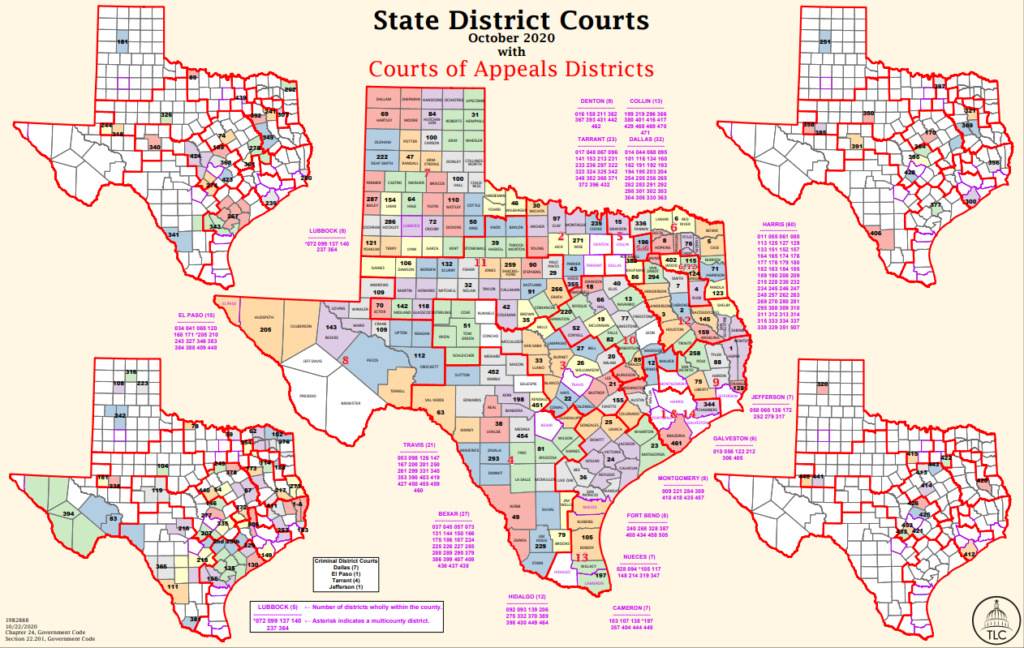
As detailed in Table 9 and shown in the map above, twenty-nine multi-county district courts (thirty percent of the multi-county trial courts in Texas) straddle appellate court district boundaries. Twenty-two judges in these multi-county courts answer to two courts of appeals, three judges answer to three courts of appeals,[178] and four answer to four courts of appeals.[179]

For example, when sitting in Kent County, the judge of the 39th District Court must know and apply the Amarillo court’s precedent; but when he crosses the county line into Stonewall County, he must know and apply the Eastland court’s precedent. Of course, it is possible to know the differences in the precedent of the two courts, and so an argument can be made that this judge—and twenty-eight others like him—are not particularly disadvantaged by having a multi-county district that is bisected by the courts of appeals’ boundary. They can, it may be argued, simply apply the law applicable in the county in which they happen to be sitting on a given day. But saying it is possible for a judge to know, and instantly call to mind, all of the nuanced differences in the precedent of two, three, or four appellate courts in civil, criminal, family, juvenile, and probate law vastly understates the difficulty of the task.
When the ninety-six district courts in overlapping appellate court districts are combined with the twenty-nine district courts whose districts are bisected by an appellate court boundary, a total of 116 of Texas’s 477 district courts—twenty-four percent of the district court judges in Texas—answer to two or more courts of appeals.
G. Uneven Distribution of Judges in Election Cycles
Another less-than-ideal feature of Texas’s intermediate appellate court system is the uneven distribution of justices in the election cycles. These justices are elected by the voters of their districts for six-year terms.[180] When all of the courts were comprised of three justices, one justice on each court was on the ballot each election cycle. In 1977, the Legislature proposed a constitutional amendment to allow the courts to have more than three justices each, which the voters adopted in 1978.[181] The Legislature also passed statutory amendments to implement the constitutional amendment if it passed.[182] Three justices were added to both Houston courts and the Dallas court. At the time, Article V, section 6 of the Texas Constitution provided:
At the first session of . . . the Courts of Civil Appeals which may be hereafter created under this article after the first election of the Judges of said courts . . . [t]he terms of office of the Judges of each court shall be divided into three classes and the Justices thereof shall draw for the different classes. Those who shall draw class No. 1 shall hold their offices two years, those drawing class No. 2 shall hold their offices for four years and those who may draw class No. 3 shall hold their offices for six years, from the date of their election and until their successors are elected and qualified, and thereafter each of the said Judges shall hold his office for six years, as provided in this Constitution.[183]
Similarly, the enabling statute provided that when justices were added to courts, the new justices would “draw lots for their terms of office” after being elected.[184] These provisions ensured that new justices added to the Houston and Dallas courts would be evenly distributed over three election cycles.
In 1979, the Legislature passed a resolution to ask the voters of Texas to vest the intermediate appellate courts with criminal jurisdiction.[185] The voters approved the constitutional amendment in 1980, and the Legislature implemented it in 1981.[186] But in addition to giving the intermediate appellate courts criminal jurisdiction, the Constitution also was amended to delete the provision regarding drawing for classes on the appellate courts. The Legislature added twenty-five justices to the courts effective in September 1981, and added three additional justices to the Austin court effective in September 1982.[187]
Two justices elected in November 1982 to new positions on the First and Fourteenth Courts of Appeals in Houston were informed that lots would be drawn to determine whether their terms of office would be for two, four, or six years, as required by law. [188] They filed a lawsuit seeking a writ of mandamus preventing the drawing of lots for positions on the courts, arguing that the statute was in conflict with the new version of Article V, section 6 of the Constitution, providing that justices on the courts of appeals be elected for six-year terms.[189] The Texas Supreme Court agreed.[190] Thus, all of the justices elected in 1982 to fill newly created positions served six-year terms. As a result, forty-five of the eighty intermediate appellate court justices in Texas are elected in the same election cycle (election years 2018, 2024, etc.), while nineteen are elected in the next cycle (2020, 2026, etc.), and sixteen are elected in the third cycle (2022, 2028, etc.), as shown in Table 10. In contrast, if election of the justices were evenly distributed, twenty-six or twenty-seven justices would be elected in each election cycle.
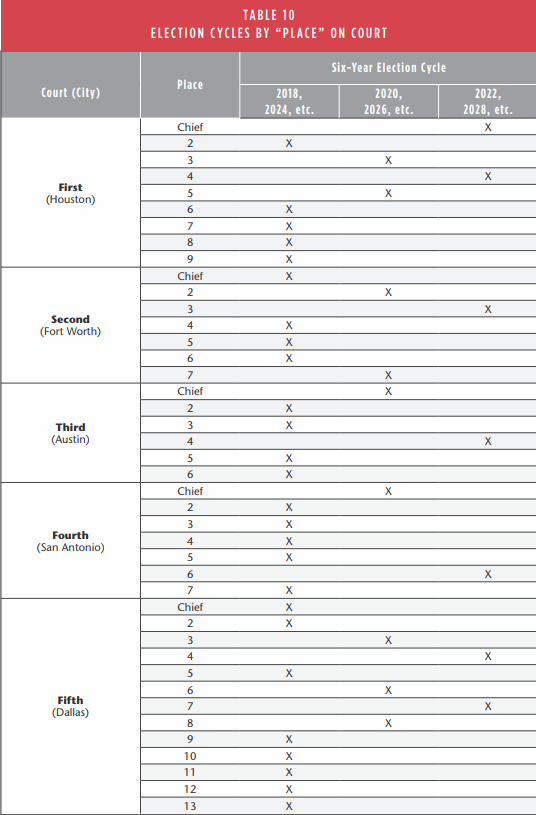
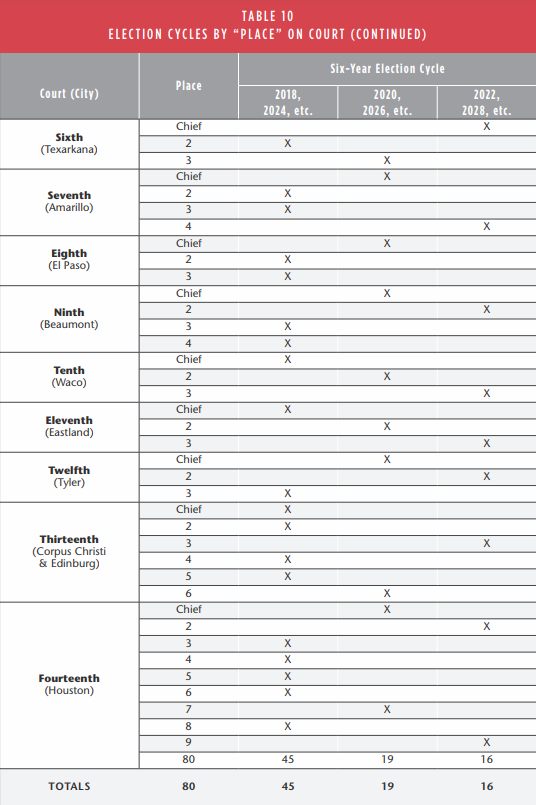
Having more than half of the intermediate appellate court justices on the ballot during the same election cycle can have significant consequences. Every six years, a majority of the judgeships on each court having more than three justices are on the ballot. On three of these courts—Fort Worth, Dallas, and Corpus Christi—the chief justice is one of the seats to be elected. This can result in a court having to assimilate a majority of new, inexperienced justices at the same time, including a new chief justice. Additionally, incumbent justices, if opposed, must conduct political campaigns, which can distract from their work on the courts. Having a majority of the entire intermediate appellate court judiciary elected in the same year is far from ideal, but reparable only through a constitutional amendment.
III. ADMINISTRATION OF THE JUDICIARY
The Texas Supreme Court has administrative and supervisory control over the judicial branch,[191] and the Court of Criminal Appeals has administrative duties predominantly related to judicial training.[192] The intermediate appellate courts, on the other hand, have no specific administrative or supervisory duties.
To facilitate the work of the intermediate appellate courts, the Chief Justice of the Supreme Court may temporarily assign a justice of a court of appeals to another court of appeals and may assign a qualified retired justice to a court of appeals, regardless of whether a vacancy exists.[193] The Court also may order cases transferred from one court of appeals to another at any time that, in the opinion of the Court, there is good cause for the transfer.[194] Additionally, the Chief Justice of the Supreme Court, the Presiding Judge of the Court of Criminal Appeals, or the Chair of the Council of Chief Justices is authorized to transfer funds between appellate courts—subject to prior approval of any transfer of funds by the Legislative Budget Board and the Governor—for the purpose of efficient and effective appellate court operations and management of court caseloads.[195]
Even though the Supreme Court is given administrative and supervisory control over the judicial branch, much of the management of the judicial branch is conducted by the judges who are appointed to preside over Texas’s eleven judicial administrative regions (called “regional presiding judges”).[196] A presiding judge must be a regularly elected or retired district judge, a former judge with at least twelve years of service as a district judge, or a retired appellate judge with judicial experience on a district court.[197] Today, five of the eleven regional presiding judges are active trial court judges; the other six are retired judges.[198]
A regional presiding judge is required to:
- ensure the promulgation of regional rules of administration;
- advise local judges on case flow management and auxiliary court services;
- recommend to the Chief Justice of the Supreme Court any needs for judicial assignments from outside the region;
- recommend to the Supreme Court any changes in the organization, jurisdiction, operation, or procedures of the region necessary or desirable for the improvement of the administration of justice;
- act for a local administrative judge when the local administrative judge does not perform the duties required of him or her;
- implement rules adopted by the Supreme Court pursuant to its authority under the Court Administration Act;
- provide requested statistical information to the Supreme Court or the Office of Court Administration; and
- perform duties assigned by the Chief Justice of the Supreme Court.[199]
The regional presiding judges also are responsible for publishing lists of attorneys qualified to represent indigent defendants in death penalty trials and in habeas corpus proceedings in death penalty cases.[200] And these judges must call a yearly meeting of the district and statutory county court judges in the administrative region for the purpose of consulting with those judges “concerning the state of the civil and criminal business in the courts of the administrative region and arranging for the disposition of the business pending on the court dockets.”[201] The presiding judge of an administrative region can request the presiding judge of another administrative region to furnish judges to aid in the disposition of litigation pending in a county within the administrative region of the judge who makes the request.[202]
One of the primary responsibilities of the regional presiding judge is to assign judges of the administrative region to other counties in the region “to try cases and dispose of accumulated business.”[203] As part of the authority to assign judges, the regional presiding judges may assign judges to hear recusal motions.[204] Texas Rule of Civil Procedure 18a provides that when a recusal motion is filed, the judge subject to the motion must either voluntarily recuse or request the regional presiding judge assign a judge to hear the motion.[205] The regional presiding judge must “immediately set a hearing before himself or some other judge designated by him, cause notice of such hearing to be given to all parties or their counsel, and make such other orders including orders on interim or ancillary relief in the pending cause as justice may require.”[206]
The regional administrative judges disposed of 404 motions to recuse or disqualify in FY 2019, with 224 (fifty-five percent) being resolved after a hearing and the remainder being decided on the papers (largely because the movant failed to comply with the requirements of the applicable rule).[207] Only twenty motions to recuse or disqualify (five percent) were granted.[208] The regional presiding judges heard sixty-two percent of the motions to recuse or disqualify. The remaining thirty-eight percent were heard by an appointed retired or former judge or an active judge.[209]
The Chief Justice of the Supreme Court may make assignments within an administrative region and perform the other duties of a presiding judge if a presiding judge dies or resigns, if an absence, illness, or other incapacity prevents the presiding judge from performing his or her duties for a period of time, or if the presiding judge disqualifies himself or herself in a particular matter.[210]
The Chief Justice of the Supreme Court also must call and preside over an annual meeting of the presiding judges of the administrative judicial regions and may call meetings of the regional presiding judges that he or she considers necessary for the promotion of the orderly and efficient administration of justice.[211] Neither the Chief Justice nor the Court as a whole, however, appoint the regional presiding judges. Instead, they are appointed by the Governor.[212]
In FY 2019, the regional presiding judges made 7,085 assignments of judges to temporarily serve on Texas’s trial courts.[213] Thirty-five percent of the assignments were to replace judges who voluntarily stepped aside on a particular case (recusal or disqualification), twenty-nine percent to provide a substitute for a judge who was on vacation, ill, attending training, or involved in a personal emergency, and nineteen percent to assist with heavy caseloads.[214]
In another example of the odd structure of Texas’s judicial system, the eleven administrative regions do not align or coincide with the thirteen geographically distinct districts that comprise the intermediate appellate court system. The following map shows the current judicial administrative regions in Texas.
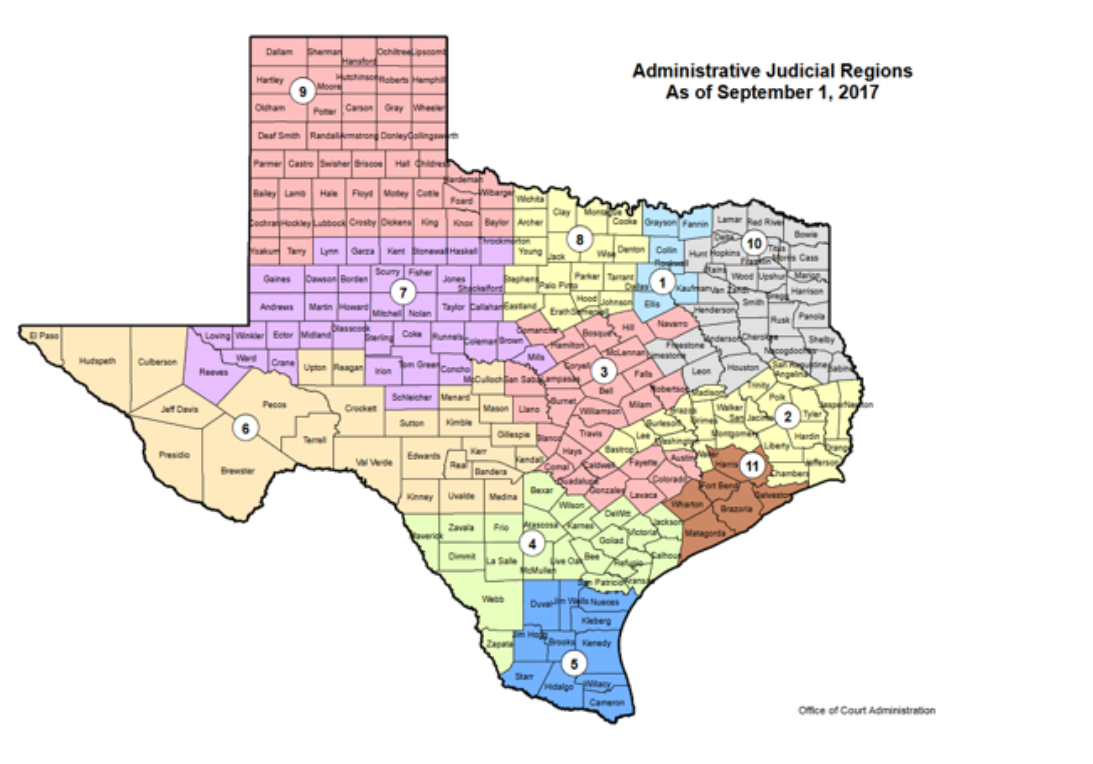
Unlike the court of appeals’ districts, the administrative regions do not bisect trial court districts to a great degree. Only three trial court districts are bisected by administrative regions: the 1st district in southeast Texas,[215] the 278th district in central-east Texas,[216] and the 452nd district in central Texas.[217]
IV. Comparison to Other Jurisdictions
Texas has more intermediate courts of appeals (fourteen)[218] than the federal judicial system (thirteen) and the judicial system of any other state, including the other nine largest states in the nation, as shown in Table 11. Of the ten most populous states, only Ohio, with twelve intermediate appellate courts, comes close to Texas in its number of intermediate appellate courts. California, which is the most populous state, has only six intermediate appellate courts sitting in nine cities. Florida, which is the closest state to Texas in population, has five intermediate appellate courts.
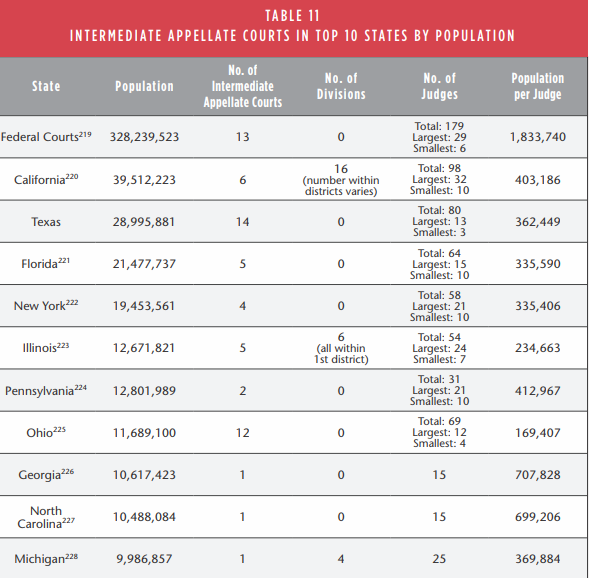
With a population of almost 29 million, and eighty justices serving on its intermediate appellate courts, Texas has one justice for every 362,449 residents. That ratio is sixth among the top ten states and reasonably typical for the large states.
The largest court in the federal system has twenty-nine judges. The largest court among the top ten states is in California, where the Second District Court of Appeals has thirty-two judges serving on eight panels of four judges each. Michigan’s single court of appeals has twenty-five judges. Illinois has a twenty-four-judge court, and New York and Pennsylvania both have twenty-one-judge courts. By comparison, Texas’s largest court, the Dallas Court of Appeals, has thirteen judges. If the two Houston courts were merged, the combined court would have only eighteen judges.
The smallest intermediate appellate courts in the top ten states sit in Ohio and Texas. Ohio has three four-judge courts and Texas has five. Ohio, however, should not serve as the standard by which the Texas appellate court system is judged. Ohio’s population is only forty percent of Texas’s population, yet it has twelve mostly small intermediate appellate courts and sixty-nine appellate judges. If anything, Ohio’s intermediate appellate court system is more fractured than Texas’s. The other major states have from seven to ten judges on their smallest courts.
In sum, Texas is within the mainstream for the number of judges serving on its intermediate appellate courts, but it is outside the mainstream in terms of the number of courts and the number of judges serving on each court.
V. RECOMMENDATIONS
A. Commentators Have Recommended Changes for Decades
Almost a decade ago, then-Supreme Court Justice Don Willett wrote about the organization of Texas’s judiciary:
The convoluted make-up of the Texas judiciary—“one of the most complex in the United States, if not the world”—does not lack for critics, from the litigants who endure it, the lawyers who navigate it, and the judges who lead it. In 1991, this Court’s appointed Citizens’ Commission on the Texas Judicial System reached a stark but unsurprising conclusion: “Texas has no uniform judicial framework to guarantee the just, prompt and efficient disposition of a litigant’s complaint. . . . With the passage of time, the organization of the courts has become more, not less cumbersome.” That critique mirrors one that same year from the Texas Research League (“TRL”), which former Chief Justice Phillips had asked to scrutinize our judicial structure and suggest concrete improvements. The system’s mind-numbing complexity led TRL to lament in May 1991 that the Texas judiciary was in “disarray” and “ill-equipped to meet the needs of the 21st century,” adding, “Texas does not have a court system in the real sense of the word.” Indeed, “assigning the appellation ‘system’ to our state courts might require a long stretch of the imagination.” Nothing has improved, and interestingly, the most strenuous critics, it seems, are those who know the system best: the judges.[229]
Two years earlier, David Schenck, now a Justice on the Dallas Court of Appeals, asked if Texas was finally ready to reshape its appellate courts.[230] “No state of like population has such a heavily fractured intermediate court structure,” according to Justice Schenck.[231] He discussed the problems inherent in having so many intermediate appellate courts (as compared to other jurisdictions) and argued for merging them into five larger courts with more-equal dockets.[232]
In 2007, Texans for Lawsuit Reform Foundation published a paper discussing the many peculiarities and inefficiencies in Texas’s judicial structure.[233] The Foundation argued for reducing the number of intermediate appellate courts (without specifying a plan or number), for elimination of overlapping districts, and for an end to case transfers among the courts.[234] This paper supplements that paper.
In 2003, Scott Brister, then-Chief Justice of the Fourteenth Court of Appeals in Houston and later a Justice on the Supreme Court of Texas, asked: “Is it time to reform our courts of appeals?”[235] He discussed the problems inherent in constant equalization of dockets, reviewed the Supreme Court’s 2002 plan for redrawing the courts of appeals’ boundaries, discussed reducing the number of courts of appeals, and addressed the problems created by having two courts with the same substantive and geographic jurisdiction.[236]
In 2002, the Supreme Court of Texas made a series of recommendations to the Legislature regarding the intermediate appellate courts, including:[237]
- Overlapping districts should be resolved. No county should be in more than one appellate court district.
- The number of judges on the intermediate appellate courts (eighty) was reasonable at the time.
- The two Houston courts should be merged.
- The two offices of the Corpus Christi court should be separated, creating two separate three-judge courts.
- Any judicial redistricting should so nearly equalize the burden on each justice that transfer of cases between courts of appeals should not be routinely necessary. The Court proposed a “per justice index” that accounted for population and caseload.
The Court, however, did not believe recommending a reduction of the number of appellate courts was within its purview, but did recommend redistribution of counties within a fourteen-court structure.[238]
These represent only a fraction of the writings over the past decades on the subject of modernizing the courts.[239] But, even in the face of near-unanimous agreement that restructuring the judicial system—including the intermediate appellate courts—would advance the administration of justice, there have been no meaningful changes since 1967.
The following sections of this paper will discuss the redrawing of appellate court districts to create fewer courts of appeals and enhance efficiency (Part B), giving the appellate courts the administrative authority now held by the regional presiding judges (Part C), and redistributing the appellate court judgeships across the election cycles (Part D).
B. Merging or Redistricting the Intermediate Appellate Courts
- Benefits of Creating New Districts
a. Reduce conflicting decisions
Texas’s “heavily fractured intermediate court structure” has created a system “more primed for generating conflicts than any other state in the nation.”[240] The unsystematic way in which Texas’s intermediate appellate court system has evolved generates needless and excessive conflicts of law between the courts of appeals. While Texas’s judicial structure has gone largely unchanged since 1967, the number of filings in the intermediate appellate courts has increased dramatically, and so have the number of conflicting decisions. Numerous examples of these inconsistencies and conflicts of law between Texas’s intermediate appellate courts exist.[241] As discussed above, in Montes v. City of Houston,[242] four passengers in an automobile that was involved in an accident were injured, but only three of the four were allowed to pursue a lawsuit because of differing applications of the same law by two appellate courts.[243]
The propensity for generating conflicting decisions is a function of having more, rather than fewer, intermediate appellate courts.[244] As a matter of math, more courts create more opportunities for conflicting decisions on questions of law, and more conflicting decisions create more work for the state’s two high courts, which have an obligation to settle the law for the benefit of the courts, litigants, and society. Reducing the number of intermediate appellate courts, on the other hand, will reduce the number of conflicting decisions and lessen the burden on the two high courts.
b. Eliminate problems from overlapping and bisecting districts
Texas is the only state in the nation in which trial judges answer to more than one intermediate appellate court.[245] As then-Justice Willett stated in a 2011 opinion, the Texas Supreme Court “has lamented the ‘manifest’ problems inherent in overlapping districts: ‘uncertainty from conflicting legal authority,’ ‘the potential for unfair forum shopping,’ and ‘jurisdictional conflicts.’”[246]
Trial courts in Austin, Brazoria, Chambers, Colorado, Fort Bend, Galveston, Grimes, Harris, Waller, and Washington Counties are served by the two Houston appellate courts.[247] These appellate courts are not only located in the same city, they share the same building. Appeals from these ten counties are randomly assigned between the two appellate courts.[248] Accordingly, no legal issue is truly resolved in the lower courts in these ten counties until it has been addressed by both of Houston’s appellate courts.[249] If any issue arises in the trial court that has not been finally and consistently resolved by both appellate courts, the judges and lawyers in these cases have no concrete guidance on how to conduct lower court proceedings relating to that issue. In situations where the two Houston courts have reached different conclusions on the same questions of law or procedure, litigants and trial courts must arbitrarily choose one precedent to follow, with the outcome of a future appeal dependent on the random assignment of the case to a court of appeals. Obviously, this is not an efficient or fair method for administering justice.
The Texarkana Court of Appeals shares Gregg, Rusk, Upshur, and Wood Counties with the Tyler Court of Appeals. The Texarkana court also shares Hunt County with the Dallas Court of Appeals.[250] Because there is no system for assigning appeals from these counties to the two available courts of appeals, the appellant chooses the court after the trial court signs a judgment.[251] This creates the potential for a “race to the courthouse” for opposing parties who want to appeal from the same judgment.[252] Additionally, the same uncertainty applies to cases tried in these counties as applies to cases tried in the overlapping Houston courts’ district. Because the court to which the appeal will be taken cannot be known at the time of trial, the judge and litigants must guess about the precedent to apply at trial when the appellate courts have a conflict on a question of law presented by the case.
The trial courts sitting in districts that are bisected by court of appeals boundaries have a different problem. These judges must know, recall, and apply the precedent of two, three, or four appellate courts on an almost limitless range of legal issues. The task is both burdensome and practically impossible.
If starting anew, it is impossible to imagine that any legislative body would create a system with overlapping appellate court districts that bisect trial court districts. Depending on the plan adopted, redrawing the courts of appeals’ districts can resolve the overlapping districts and largely resolve the bisected districts. Even if new districts are not adopted, the Legislature can and should resolve the overlapping districts. As the Texas Supreme Court said in 2002, “Texas is the only state in the nation with overlapping appellate districts, an historical anomaly which creates real and recurring problems to the bench and bar.”[253] “No county should be in more than one appellate district.”[254]
c. Reduce transfers of cases
When some courts are busier than others (on a per-justice basis), as is inherent in a multi-court system, the options to resolve the disparity are to (1) create new courts, (2) add permanent justices to busier courts, (3) move justices from underutilized courts to busier courts, (4) temporarily assign visiting justices to busier courts, or (5) routinely transfer cases between the courts to equalize dockets. In regard to these options:
- Texas ceased creating new intermediate appellate courts in 1967 and should not restart.[255]
- Texas currently has eighty intermediate appellate court justices who are successfully managing the caseload, and so adding permanent justices is not necessary.[256]
- Temporary reassignment of appellate court justices to other courts is not feasible when the underutilized court has only three justices because it leaves that court with an insufficient number of judges to conduct business. Additionally, temporary reassignment conflicts with the idea that justices are serving the residents of the district in which the justice was elected. The Legislature, however, has permanently reallocated judgeships in recent times, and permanent reallocation remains possible.[257]
- The intermediate appellate courts have relied on the temporary assignment of visiting justices in the past, and funds continue to be provided by the Legislature for that purpose. While these assignments have decreased substantially over the past decade as the courts have increased the use of in-house staff attorneys, the use of visiting justices remains possible.[258]
- The transferring of cases is the method most often employed in Texas to resolve the courts of appeals’ disparity in caseloads. Indeed, the Legislature, until 2007, required docket equalization transfers.[259]
Docket equalization, and the resulting transfer of cases, is unpopular with litigants, lawyers, and judges. It can lead to multiple appeals of a single case being heard by different courts, with potentially inconsistent outcomes.[260] And it does not always work as intended, as shown by the return of transferred cases from the El Paso court to their originating courts in 2018.[261]
Any multi-court system is going to have unequal dockets to some degree. But Texas’s current structure—with large and small courts sitting in major metropolitan areas, medium-size cities, and small farming communities—creates too much disparity and requires too many docket-equalization transfers. The inequality can be ameliorated by having larger courts sitting in districts with evenly apportioned populations and caseloads, as proposed in this paper.
d. Reduce “small court” problems
Half of Texas’s intermediate appellate courts are “small courts.” Five have only three justices and two others have four justices. Texas’s constitution and statutes require that the justices sit in panels of three and that two of the three agree on a decision in a case.[262] Consequently, if a three-judge court has a vacancy or is missing one of its members because of a sickness, recusal, or another reason, it does not have a sufficient number to constitutionally function. A visiting judge must be temporarily appointed, or a judge temporarily transferred from another court, to fill the void. Recusals and absences thus create a need to fill temporary vacancies on three-justice courts, which adds an administrative burden to the Texas Supreme Court.
Additionally, because Texas’s appellate court justices are elected, a seat on a three-justice court will be on the ballot—and an incumbent seeking reelection must campaign for office—in every election cycle. For the four-justice courts, half the members of the court may be campaigning for office every third election cycle.
Furthermore, litigants in cases heard in appellate courts having four or more judges effectively enjoy an additional opportunity for review in the appellate process that is not available to litigants in cases before a three-justice court—they can ask for an en banc review of a panel’s decision. There is no ability for en banc review of the court’s decision when the court has only three members. And the justices themselves do not have the benefit of en banc consideration to resolve internal conflicts.[263]
Small courts also can produce personality and decisional conflicts among the judges, and can create a lack of collegiality.
The cost of recurring hostility . . . is particularly high on a small court. The hostility can leave the third or fourth justice in a very awkward position and can affect the court’s work product, which can delay or hinder the publication of its opinions. . . . While these tensions are surely present on larger courts as well, they are less likely to be as intense or disruptive when justices have the breathing room that comes with naturally rotating panels.[264]
All of the problems of having smaller courts are resolved by creating fewer, larger intermediate appellate courts.
e. Achieve cost savings
Creating fewer, larger intermediate appellate courts should save money for the State of Texas and some of the localities currently hosting the courts. It is difficult, however, to ascertain the extent of the savings because the courts are appropriated lump sums of money by the Texas Legislature.[265] In the plans proposed in this paper, the number of justices serving on the intermediate appellate courts is not changed, and so savings are not obtained by a reduction in the number of justices. With ever-increasing caseloads, it is challenging to see a reduction in the number of attorneys employed by the courts. Consequently, savings will not result from a reduction in staff attorneys or law clerks, either. Merging the clerks’ offices and the facilities occupied by the courts, however, should result in savings.[266]
- Constitutional Considerations and the Voting Rights Act
The Fifteenth Amendment to the United States Constitution, ratified in 1870, provides that “[t]he right of citizens of the United States to vote shall not be denied or abridged by the United States or by any State on account of race, color, or previous condition of servitude.”[267] The Fourteenth Amendment, ratified two years before the Fifteenth Amendment but ineffective at the time in preventing the denial of Black citizens’ right to vote, provides that “[n]o State shall make or enforce any law which shall abridge the privileges or immunities of citizens of the United States; nor shall any State deprive any person of life, liberty, or property, without due process of law; nor deny to any person within its jurisdiction the equal protection of the laws.”[268]
In the 1962 U.S. Supreme Court case Baker v. Carr, the Court held that, under the Fourteenth Amendment, redistricting issues are not purely political questions committed solely to the legislative branch for resolution, but, instead, they may be reviewed by a court.[269] Two years later, the U.S. Supreme Court handed down two opinions requiring that the U.S. House of Representatives (Wesberry v. Sanders[270]) and state legislatures (Reynolds v. Sims[271]) be based on districts of equal population, under the principle of “one person, one vote.” The Court, however, in Wells v. Edwards, affirmed the lower court’s decision that the one person, one vote requirement is inapplicable to judicial elections.[272] But that decision does not negate the possibility of litigation regarding appellate court districts under the Fourteenth or Fifteenth Amendments.[273] The limitation on lawsuits under either the Fourteenth or Fifteenth Amendments, however, is that the plaintiff must prove intentional discrimination.[274]
The Fourteenth and Fifteenth Amendments both give Congress the power to enforce them by appropriate legislation.[275] Almost a century after the two amendments were ratified, Congress responded to the ongoing pattern of discrimination against Black citizens in regard to voting—largely being perpetrated in southern states—by passing the Voting Rights Act of 1965. The preamble to the Act provides that it is intended to enforce the Fifteenth Amendment “and for other purposes.”[276] Section 2 of the Act, applicable to all fifty states, forbids “any voting qualification or prerequisite to voting or standard, practice, or procedure . . . imposed or applied by any State or political subdivision in a matter that results in a denial or abridgement of the right of any citizen of the United States to vote on account of race or color.”[277]
A violation of Section 2 is established “if, based on the totality of circumstances, it is shown that the political processes leading to nomination or election in the State or political subdivision are not equally open to participation by members of a class of citizens protected by [Section 2] in that its members have less opportunity than other members of the electorate to participate in the political process and to elect representatives of their choice.”[278] “The extent to which members of a protected class have been elected to office in the State or political subdivision is one circumstance which may be considered: Provided, That nothing in this section establishes a right to have members of a protected class elected in numbers equal to their proportion in the population.”[279] This is a “results test,” which is to say that practices and procedures resulting in the denial or abridgement of the right to vote are forbidden by Section 2, even if there is an absence of proof of discriminatory intent that would be required to sustain a constitutional challenge.[280] Both the federal government and individuals have sued to enforce Section 2,[281] and injunctive relief is available to block voting laws from going into effect.[282]
While Section 2 appears to provide two distinct types of protection for minority voters—protection of their opportunity to participate in the political process and protection of their opportunity to elect representatives of their choice—this reading of the statute “is foreclosed by the statutory text.”[283] “[T]he opportunity to participate and the opportunity to elect [are] inextricably linked.”[284]
Any abridgment of the opportunity of members of a protected class to participate in the political process inevitably impairs their ability to influence the outcome of an election. As the statute is written, however, the inability to elect representatives of their choice is not sufficient to establish a violation unless, under the totality of the circumstances, it can also be said that the members of the protected class have less opportunity to participate in the political process. The statute does not create two separate and distinct rights. Subsection (a) covers every application of a qualification, standard, practice, or procedure that results in a denial or abridgment of “the right” to vote. The singular form is also used in subsection (b) when referring to an injury to members of the protected class who have less “opportunity” than others “to participate in the political process and to elect representatives of their choice.” 42 U.S.C. § 1973 (emphasis added). It would distort the plain meaning of the sentence to substitute the word “or” for the word “and.” Such radical surgery would be required to separate the opportunity to participate from the opportunity to elect.[285]
Thus, a violation of Section 2 is established if the political processes leading to an official’s election are not equally open to participation by members of a protected class because its members have less opportunity than other members of the electorate to participate in the political process and to elect representatives of their choice. In the 1980s, there was litigation about whether—because of the reference to “representatives”—Section 2 was applied to the election of judicial officers. That question was settled in 1991 by the U.S. Supreme Court in opinions stemming from cases filed in Louisiana and Texas.[286]
Before 1991, the Louisiana Supreme Court was comprised of seven members, five elected from single-member districts and two elected from a large two-member district.[287] The two-member district included Orleans Parish (the City of New Orleans), which provided more than half the district’s voters.[288] More than half the registered voters in Orleans Parish were Black, while the outlying parishes had majority white populations.[289] Consequently, the district as a whole was majority white. No Black person had ever been elected to the Louisiana Supreme Court.[290]
In Chisom v. Roemer, the plaintiffs asserted that the state’s refusal to break the two-member district into two single-member districts, one comprised of the Orleans Parish and the other containing the outlying parishes, was a violation of Section 2 of the Voting Rights Act.[291] The result, the plaintiffs argued, would be two districts of approximately equal population, with the Orleans-only parish providing Black voters a meaningful opportunity to elect a person of their choice.[292]
The trial court concluded that the plaintiffs failed to establish a violation of Section 2.[293] On appeal, the U.S. Fifth Circuit Court of Appeals ordered the case be dismissed based on its decision in League of United Latin American Citizens v. Clements[294] (LULAC) that Section 2 of the Voting Rights Act did not reach judicial elections.[295] The Fifth Circuit had concluded in LULAC that it was “factually false” to characterize judges as “representatives” because public opinion is “irrelevant to the judge’s role.”[296] “[T]he judiciary serves no representative function whatever: the judge represents no one.”[297] Consequently, judicial offices “are not ‘representative’ ones, and their occupants are not representatives.”[298] Consequently, a Section 2 violation could not be sustained in regard to judicial offices.
The U.S. Supreme Court reversed the Fifth Circuit Court of Appeals’ decision in Chisom, holding that despite its use of the word “representative,” Section 2 applies to judicial offices as well as legislative offices.[299] Justice Antonin Scalia, joined by Chief Justice William Rehnquist and Justice Anthony Kennedy (none of whom are on the Court today), dissented because the majority did not rely on the plain words of the statute but, instead, concluded that Congress could not have intended to exclude judicial offices from the Act when it amended the Act in 1982 to include the “results test.”[300]
The Louisiana Chisom case, as noted, involved a multi-member district. The Texas case Houston Lawyers’ Association v. Attorney General of Texas involved a challenge to the election of judges to Texas’s district courts, which are single-judge districts.[301] The U.S. Supreme Court held, again, that Section 2 of the Voting Rights Act applies to elected judicial offices, and the Act applies whether the office sought is a single- or multi-member district.[302] But the Court did not hold that single-member districts automatically violate the Voting Rights Act. Instead, the Court stated, “[W]e believe that the State’s interest in maintaining an electoral system—in these cases, Texas’[s] interest in maintaining the link between a district judge’s jurisdiction and the area of residency of his or her voters—is a legitimate factor to be considered by courts among the ‘totality of circumstances’ in determining whether a [Section] 2 violation has occurred.”[303]
Thus, Section 2, along with the Fourteenth and Fifteenth Amendments, provides a basis for litigation regarding any plan to re-draw Texas’s appellate court districts. Stating the rules broadly, a Section 2 violation is proven if the plaintiff shows that a state’s or political subdivision’s actions result in the denial or abridgement of a protected class’s opportunity to elect a person of their choice, without regard to intent, while constitutional violations require proof of an intent to deny or abridge a citizen’s right to vote or to otherwise discriminate against someone in a protected class in regard to that person exercising the right to vote.
Most court decisions dealing with the drawing of district lines relate to legislative districts, not judicial districts. In regard to single-member legislative districts, according to the U.S. Supreme Court in Thornburg v. Gingles, a majority-minority district must be drawn if (1) the racial or language minority group is sufficiently numerous and compact to form a majority single-member district, (2) the minority group is politically cohesive, and (3) the majority votes sufficiently as a bloc to enable it to usually defeat the minority’s preferred candidate.[304]
One commentator describes the Gingles test as follows:
The first [Gingles condition] asks whether it is possible to draw a district so that a majority of voters belong to a geographically “compact” racial, ethnic, or language minority community. Compactness has never been precisely defined in this context, but generally refers to populations that are not particularly “far-flung,” and where the boundaries are fairly regular, without extensive tendrils. This first Gingles condition basically tests whether a sufficiently large minority population is geographically distributed so that they could control a reasonable district.
The second Gingles condition tests whether the minority population usually votes as a bloc, for the same type of candidate. This is a nuanced test: not whether the community usually votes for Democrats or Republicans (or others), but whether they would, given a fair mix of candidates, vote for the same type of Democrats or Republicans (or others).
The third Gingles condition tests the potential competition: whether the rest of the population in the area usually votes as a bloc for different candidates than those preferred by the minority community. If so, this would mean that the minority’s preferred candidate would almost always lose—if the minority community’s voting power were not specifically protected. Together, the second and third conditions are known generally as “racially polarized” voting.
If the three threshold conditions above have been met, courts then look to the “totality of the circumstances” to determine whether the minority vote has been diluted . . . . Most of these circumstances relate to the extent of historical or contextual discrimination. One factor that has been singled out as particularly important is rough proportionality: whether minorities have the opportunity to elect representatives of their choice in a number of districts roughly proportional to the percentage of minority voters in the population as a whole. Section 2 does not guarantee proportionality. But if a minority group with 20% of a state’s eligible population could already elect representatives in 20% of the state’s districts, courts will be more hesitant to find a violation of [S]ection 2 even if the three Gingles conditions are met. And if the minority group does not have such an opportunity, courts will often be more prone to find a violation.[305]
The Gingles considerations in determining if a Section 2 violation has occurred do not easily translate to large, multi-judge appellate court districts,[306] but other limitations on district drawing may be applied. The U.S. Supreme Court has held that legislative districts will be found to violate the Voting Rights Act if they cannot be explained on grounds other than race.[307] “Bizarrely shaped” districts are strongly indicative of a racially discriminatory intent.[308] A district becomes unconstitutionally racially gerrymandered if race was the predominant factor in drawing its lines.[309] And to avoid being struck down under the Equal Protection Clause of the Fourteenth Amendment as a racially gerrymandered district, a district must be reasonably compact.[310] These decisions largely apply the traditional factors that are considered when drawing district lines: contiguity, compactness, community of interest, natural boundaries, and preservation of existing precinct lines. It is possible to apply these rules to large, multi-judge appellate court districts.
As to partisanship in drawing districts, it cannot be used to justify racial gerrymandering,[311] but an otherwise acceptable reapportionment plan is not constitutionally vulnerable when its purpose is to provide districts that would achieve “political fairness” between political parties.[312] A state’s attempt, within tolerable population limits, to fairly allocate political power to the parties in accordance with their voting strength is constitutional.[313] At the same time, gerrymandering for purely partisan reasons has been found to present purely political questions beyond the reach of the federal courts.[314] “There are no legal standards discernible in the Constitution for making such judgments, let alone limited and precise standards that are clear, manageable and politically neutral.”[315] “Federal judges have no license to reallocate political power between the two major political parties, with no plausible grant of authority in the Constitution and no legal standards to limit and direct their decisions.”[316] Thus, drawing districts in an attempt to achieve political fairness is constitutional, and drawing purposefully partisan districts is unlikely to be declared unconstitutional because it is not something the courts are suited to referee.
In a 2016 paper, New York attorney Alec Webley found that only two of thirty-two challenges to judicial districting under the Voting Rights Act had been successful.[317] His analysis and conclusions are summarized in the following paragraphs.
One of the successful cases was the Chisom line of decisions, discussed above, having to do with the two-member district used to elect judges to the Louisiana Supreme Court. The second was Martin v. Allain.[318] The court in Martin found violations of Section 2 in regard to some trial court districts in Mississippi on the basis of evidence showing that state officials deliberately prevented Black candidates from succeeding in judicial elections by using multi-member districts designed to guarantee that only white candidates would be elected.[319] The federal district court remedied the violation by requiring subdistricts of approximately equal population (fifteen percent deviation was allowed), and using the most permanent boundaries possible, which included preserving whole counties. Notably, subdistricts were used because the Mississippi Constitution already provided for subdistricted judgeships (including the Mississippi Supreme Court) having jurisdiction over the whole district.
The thirty unsuccessful attempts to use Section 2 to invalidate appellate court districts fall into two categories: failures because the plaintiffs could not prove liability and failures because an acceptable remedy could not be fashioned. In the first category, attempts failed because the plaintiffs could not show that race was the principal factor in the election, that racial bloc voting was sufficiently present, or that race explained minority electoral success. It is, concludes Webley, “extremely difficult to satisfy the Gingles districting criteria” in judicial districting cases.[320]
In regard to the second category, the possible remedies, according to Webley, include the creation of subdistricts, implementation of limited voting, or ending judicial elections.321 Attempts to create subdistricts have been rejected because the plaintiffs could not draw a map with the requisite minority majorities to satisfy the first Gingles prong, because of the administrative problems implicit in crafting entirely separate court districts with elected judges, and because creating subdistricts fails to satisfy a state’s “linkage interest” of ensuring the entire electorate of a district can hold a judge accountable through an election.322
Limited, or cumulative, voting has not found favor with courts, either. As the Eleventh Circuit explained:
Requiring judges to run for unnumbered seats on the court, meaning that all of the judges seeking reelection would be forced to oppose each other, would have a detrimental effect on the collegiality of the court’s judges in administrative matters…. In addition to dampening lawyer interest in a judicial career, requiring judges to face opposition every time their terms expire would adversely affect the independence of the judiciary: Judges would begin running for reelection from the moment they took office…. Finally, a cumulative voting system, like a subdistricting system, would encourage racial bloc voting. That, in turn, would necessarily fuel the notion that judges were influenced by race when administering justice.323
Finally, no court has ordered that a state change from electing its judiciary to appointing its judiciary. While forcing such a change may be theoretically possible under the Voting Rights Act, there is no precedent for it. For all of these reasons, the Eleventh Circuit has concluded that “Section Two of the Voting Rights Act frankly cannot be said to apply, in any meaningful way, to at-large judicial elections.”324
Possible Court Districting Plans:
Methodology. There are many variations in the number and composition of geographic territories to serve as districts for Texas’s intermediate appellate courts. For purposes of illustration, this paper discusses three five-district plans in the following sections, but no attempt is made to determine the impact of any districting plan on protected groups or political parties. The plans are evaluated based on two neutral criteria: population and caseloads. The U.S. Census Bureau’s population estimates for 2019 were used. County-by-county appellate data for fiscal years 2014 to 2020, obtained from the Texas Office of Court Administration, were also used.
In 2002, the Texas Supreme Court made suggestions for addressing problems with the functioning and structure of the intermediate appellate courts.325 The Court proposed a formula for redrawing court districts that considered population and caseloads, as follows:
Judicial appellate workload should be measured by a combination of population and case filings. The Supreme Court has calculated a Judicial Index number
for each county, comprised of the sum of new cases filed during the past five years and the 2000 population of the county in thousands. In plain language, this means:
a. The 2000 census population of Texas is 20,851,820, or 20,852 in thousands
b. The total number of regular cases filed in the 14 courts of appeals in the past five fiscal years 1998-2002 (September 1, 1997 to August 31, 2002) was 57,588.
c. Adding 20,852 and 57,588 produces a statewide index number of 78,440. (This weights the value of case filings at approximately 2.3 times the value of population.)
d. Dividing the 78,440 by 80 justices yields a per justice index of 980.5.
e. Use the statewide index numbers to determine the index number for a proposed court district. Thus, the ideal index for a court with three justices would [be] 2,942, for four justices 3,922, and so forth.[326]
The Court did not believe its proper role allowed it to suggest a reduction in the number of appellate courts, and thus the methodology it developed was intended to allow the Court to determine how fourteen appellate court districts could be created that would have substantially equivalent workloads on a per-judge basis. The Court’s order states that, under the proposed formula, the value awarded to case filings is approximately 2.3 times the value awarded to the population in each district.[327] In other words, the Court was saying that both population and case filings are relevant, but the number of cases filed in a proposed district is 2.3 times more important than the district’s population. In fact, the Court’s order contained a mathematical error. In actuality, case filings were valued at 2.76 times population under the Court’s 2002 formula (57,588 cases ÷ 20,852 population = 2.76).
The formula’s shortcoming is that it treats all cases equally. Routine criminal cases, which make up a significant part of any appellate court’s docket, are treated as equal to complex civil or administrative cases. A better formula should give more weight to the types of cases that are more complex than others, but the exact amount of additional weight to assign to broad categories of cases is difficult to ascertain.
For the purpose of evaluating appellate districts, this paper creates an Evaluation Index similar to the one used in 2002 by the Texas Supreme Court. This paper used seven years of case-filing data and presumed that, on the whole, civil appeals take more of a court’s time and resources than do criminal appeals. The steps used to compute the Evaluation Index, as shown in Table 12, were:
Step 1: The total number of civil appeals generated by all 254 Texas counties over the seven-year period (2014 to 2020) was multiplied by 1.5 (34,443 x 1.5 = 51,665) to implement the presumption that civil appeals consume more of an appellate court’s time and resources than criminal appeals.
Step 2: The total number of criminal appeals generated by all 254 Texas counties over the seven-year period (29,161) was added to the adjusted number of civil appeals from Step 1 (51,665), yielding 80,826.
Step 3: The state’s population (28,995,881) was divided by 1,000, as the Supreme Court had done when creating its formula in 2002.
Step 4: The adjusted population from Step 3 (28,996) was added to the case-filing data from Step 2 (80,826) to yield 109,822.
Step 5: 109,822 was divided by 80 intermediate appellate court justices, yielding an Evaluation Index of 1,373.
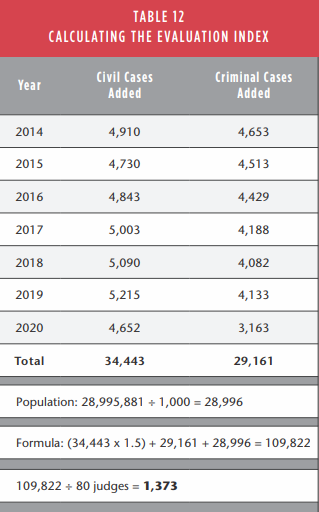
The same series of calculations was used for each of Texas’s 254 counties, yielding an Evaluation Index for each county. For example, the Evaluation Index for Lubbock County is 934, while the Evaluation Index for Harris County is 18,726.
The purpose of the Evaluation Index is to determine the appropriate number of judges for a specified district. When counties are assigned in a districting plan, the Indexes for all counties in a particular district are added together and divided by 1,373 to yield the number of judges who should serve in that district.
Of course, the elements and weighting of a proper Evaluation Index are subject to debate. An argument can be made that caseloads alone should be considered, or that population and caseloads should be equally weighted. Similarly, an argument can be made that civil and criminal cases should be equally weighed, or that five or ten years of case-filing data are better than the seven years of case-filing data used here. But some method must be employed to determine the number of judges who should serve in a specified district.
b. Criteria and assumptions underlying plans
In evaluating various plans, the state’s “linkage interest”—that all voters in a district should be allowed to choose all judges on a court—is assumed because it is embedded in the Constitution.[328] The plans discussed below, therefore, maintain whole counties and do not propose subdistricts.
Even though all justices on one of Texas’s intermediate appellate court are elected by all voters in the court’s district, to prevent population centers within a district from dominating the election of justices, it is possible for the Legislature to require that one or more reside in one or more specified counties within the court’s district. Requiring a justice to live in a specified region within the appellate court district may, however, present a constitutional challenge. The Constitution provides that all civil officers in Texas reside within the state ” and within their districts.”329 It is undecided in Texas law whether the legislative edict that a judge reside in a region of a district complies or violates this constitutional provision.
All of the districting plans discussed below end the practice of having overlapping boundaries. Three of the plans simply merge existing courts and, in so doing, eliminate overlapping boundaries. These merger plans do not address the bisecting of trial court districts, except to the extent the merging of appellate court districts happens to eliminate bisected trial court districts. A fourth plan uses existing regional administrative districts as a basis for appellate court districts. It eliminates overlapping appellate court boundaries and almost eliminates bisecting of trial court districts (only one trial court district would be bisected).
c. Schenck’s five-district court-merger plan
In his 2009 law review article, David Schenck (now a justice on the Dallas Court of Appeals) proposed a five-court plan constructed by merging existing districts. Two compelling reasons to merge existing courts of appeals rather than draw new boundaries are that the justices currently serving on the courts can remain in place and the courts can continue to use the existing courtrooms and other facilities. Of course, if seats on the courts are not reassigned as part of a merger of courts to account for population and caseload disparities, docket equalization transfers will continue to be required.
Justice Schenck’s five-district court-merger plan is detailed below and shown on the following map.[331]
First District: Created by merging the First and Fourteenth districts (the two Houston districts), having eighteen justices.
Second District: Created by merging the Third, Fourth, and Thirteenth districts (Austin, San Antonio, and Corpus Christi), having nineteen justices.
Third District: Created by merging the Fifth and Sixth districts (Dallas and Texarkana), but removing Gregg, Rusk, Upshur, and Wood Counties, having sixteen justices.
Fourth District: Created by merging the Second, Seventh, Eighth, and Eleventh districts (Fort Worth, Amarillo, El Paso, and Eastland), having sixteen justices.
Fifth District: Created by merging the Ninth, Tenth, and Twelfth districts (Beaumont, Waco, and Tyler), having eleven justices.
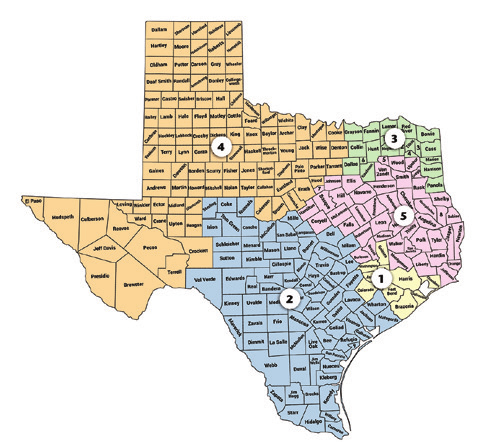
Justice Schenck’s plan resolves all overlapping districts but does not deal with bisected districts, except to the extent they are resolved by merging appellate court districts. As a result, thirteen trial court districts would continue to be bisected by appellate court boundaries.[332]
Justice Schenck suggested that, at the time he created his plan, dockets would be reasonably equal if a single justice moved from the new Fourth District (Forth Worth and West Texas) to the new Fifth District (Waco/Beaumont/Tyler). Using the Evaluation Index, a somewhat larger number of seat reassignments would be required. As shown in Table 13, two judgeships would be added to the new Second District (Austin/San Antonio/Corpus Christi), and two would be removed from the new Fourth District. One judgeship would be added to the new Fifth District, while a single judgeship would be removed from the new Third District (Dallas/Texarkana).
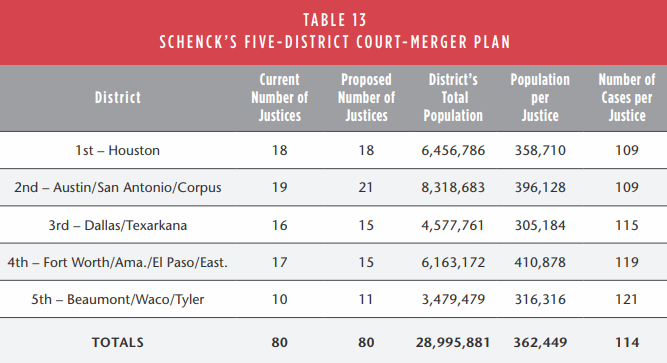
The total population range for the new districts would be from about 3.5 million to 8.3 million, making the most-populous district 2.4 times larger than the least-populous district. The disparity in total population is important in the context of an elected judiciary. A person seeking a seat on the court in the Second District, for example, would be required to communicate with a significantly larger number of voters than a person seeking a seat on the court in the Fifth District.
On a per-justice basis, the population disparity is not as significant, with the Fourth District having thirty percent more residents per justice than the Fifth District. Despite the per-justice population disparity between the two districts, justices serving on the two courts would have essentially equivalent workloads if this plan were to be implemented. It appears that residents of West Texas (the Fourth District) simply generate less work for the courts than do residents of other parts of the state.
Based on the number of justices assigned to the courts, the “largest” court would be almost twice the size of the “smallest” court, but none of the courts would have the small number of justices that currently sit on many of Texas’s intermediate appellate courts. A judge on the busiest court would handle about eleven percent more cases than would a judge on the least busy court, making the workloads roughly equivalent across the entire system.
d. Alternative five-district court-merger plan
As an alternative, Texas’s fourteen courts of appeals could be merged to create five courts, as detailed below and shown on the following map.
First District: Created by merging the First, Ninth, and Fourteenth districts (Beaumont and the two in Houston).
Second District: Created by merging the Second, Seventh, and Eleventh districts (Fort Worth, Amarillo, and Eastland).
Third District: Created by merging the Third and Tenth districts (Austin and Waco).
Fourth District: Created by merging the Fourth, Eighth, and Thirteenth districts (San Antonio, El Paso, and Corpus Christi).
Fifth District: Created by merging the Fifth, Sixth, and Twelfth districts (Dallas, Texarkana, and Tyler).
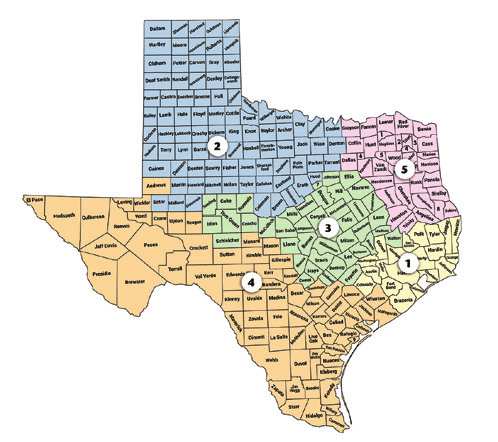
Overlapping districts are eliminated in this plan, just as they are in the Schenck plan. Again, however, the bisecting of trial court districts is not addressed, except to the extent it naturally occurs through the merger of the existing districts. As a consequence, twelve trial court districts would be bisected under this alternative plan.[333]
Even though reassignment of seats on the courts to equalize workloads would be advisable, reassignment of seats would not be required in this plan or any other plan that merely merges existing courts. Using the Evaluation Index to ascertain the number of justices to assign to each district, two seats would need to be added to the new Third District, while the new Fourth and Fifth Districts would lose one seat each, as compared to the current number of seats on the existing courts. Thus, this plan would disturb the existing judiciary less than the Schenck plan.
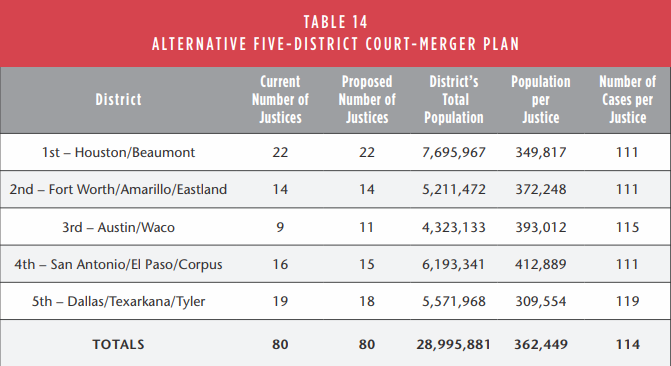
Under this alternative plan, the state’s population is distributed somewhat more evenly among the courts than under the Schenck plan. Here, the most-populous district has 1.8 times the number of residents than does the least-populous district. A person campaigning in the First District, for example, will have to communicate with more voters than a person campaigning in the Third District, but the difference is not nearly as significant as that which candidates would experience under the Schenck plan.
Computing the population variance on a per-justice basis shows that the new Fourth District would be overpopulated by about fourteen percent, while the new Fifth District would be underpopulated by about fifteen percent, yielding a per-justice population disparity of about thirty-three percent. Again, this per-justice population disparity is not reflected in a per-justice caseload disparity. Indeed, the courts’ caseloads would be remarkably equal under this alternative plan, with a justice on the busiest court handling only about seven percent more cases than a justice on the least busy courts. The “largest” court (based on the number of justices) would have twice the number of justices as would the “smallest” court, which is essentially the same as the Schenck plan.
e. Seven-district court-merger plan
Another alternative would be to create seven courts of appeals by merging existing courts, as detailed below and shown on the following map.
First District: Created by merging the First, Ninth, and Fourteenth districts (Beaumont and the two in Houston).
Second District: Leaving the current Second district (Fort Worth) untouched.
Third District: Created by merging the Third and Tenth districts (Austin and Waco).
Fourth District: Created by merging the Fourth and Eighth districts (San Antonio and El Paso).
Fifth District: Created by merging the Fifth, Sixth, and Twelfth districts (Dallas, Texarkana, and Tyler).
Sixth District: Leaving the current Thirteenth district (Corpus Christi) untouched.
Seventh District: Created by merging the Seventh and Eleventh districts (Amarillo and Eastland).
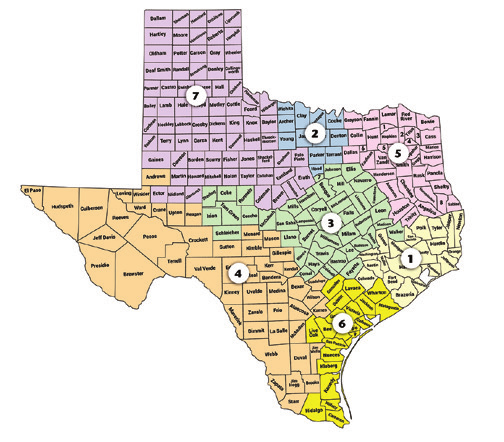
As with any court-merger plan, no reassignment of seats on the courts would be required, although reassignment of seats would be warranted. Overlapping districts are eliminated, but bisecting of trial court districts is not addressed, except to the extent it naturally occurs through the merger of the existing court districts. Eighteen trial court districts would continue to be bisected under this plan.[334]
Using the Evaluation Index, the courts would have from five justices in the Seventh District to twenty-two justices in the First District, which is a larger disparity than any of the other plans discussed in this paper. To address caseloads, the new Third District (Austin/Waco) would need two additional judgeships, while the new Seventh District (Amarillo/Eastland) would need two fewer judgeships. The Second District (Fort Worth) would gain a single judgeship, obtained from the new Fifth District (Dallas/Texarkana/Tyler).
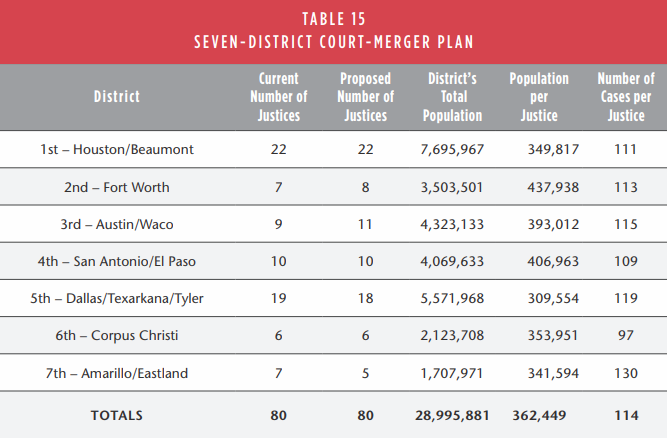
Under this plan, the population of districts ranges from 1.7 million to 7.7 million, meaning the most-populous district would have 4.5 times the population of the least-populous district—the greatest disparity among the plans discussed in this paper. Computing the population variance on a per-justice basis shows that the Second District would be overpopulated by about twenty-one percent, while the new Fifth District would be underpopulated by about fifteen percent. Again, while that disparity seems dramatic, it is the result of the fact that some areas simply generate more work for the courts than other areas.
Based on the number of justices assigned to the courts, the “largest” court would have more than four times the number of justices as would the “smallest” court. The per-justice caseloads also vary significantly under this plan, which is a function of having courts with relatively fewer justices than other plans.
f. Five-district plan based on administrative districts
As an alternative to using the existing appellate court districts, new districts could be modeled on the regional administrative districts. The regional administrative districts minimize the instances when an appellate boundary bisects a trial court district, and all overlapping districts are resolved in the administrative regions, as well. On the other hand, there are eleven administrative regions, which is hardly better than the thirteen[335] intermediate appellate court districts that currently exist in Texas. Consequently, a plan that is based on the administrative districts, but combines some of them, would be a viable alternative. The following is an example of a five-district plan that generally uses the administrative district boundaries but makes a few adjustments to eliminate tendrils:
First District: Created by merging administrative districts 2 and 11. Harris County (Houston) would be the most populous county in the district.
Second District: Created by merging administrative districts 7, 8, and 9, except Brown and Mills Counties would be removed. Tarrant County (Fort Worth) would be the most populous county in the district.
Third District: Created by using administrative district 3, with Bastrop, Brown, Burleson, Lee, Mills, and Washington Counties added, and Navarro County removed. Travis County (Austin) would be the most populous county in the district.
Fourth District: Created by merging administrative districts 4, 5, and 6. Bexar County (San Antonio) would be the most populous county in the district.
Fifth District: Created by merging administrative districts 1 and 10, except Navarro County would be added, and Bastrop, Burleson, Lee, and Washington Counties would be removed. Dallas County would be the most populous county in the district.
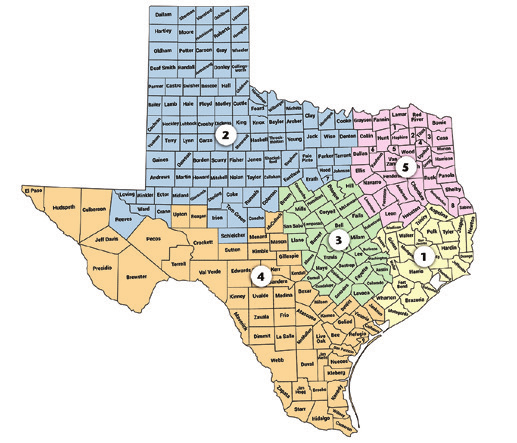
The result is five districts that are reasonably compact and devoid of tendrils. Overlapping districts are eliminated under this plan, and only one district court is bisected.[336] Using the Evaluation Index, the “largest” district (based on the number of justices) would have twenty-two justices, while the “smallest” would have ten. The population would vary from 3.7 million to 8.1 million residents, making the most-populous district 2.2 times larger than the least-populous district. The Fifth District would have the lowest population per-justice but the highest caseload per justice. The per-justice caseload disparity is greater than the other two five-district plans, with justices on the busiest court handling sixteen percent more cases than the judges on the least busy court.
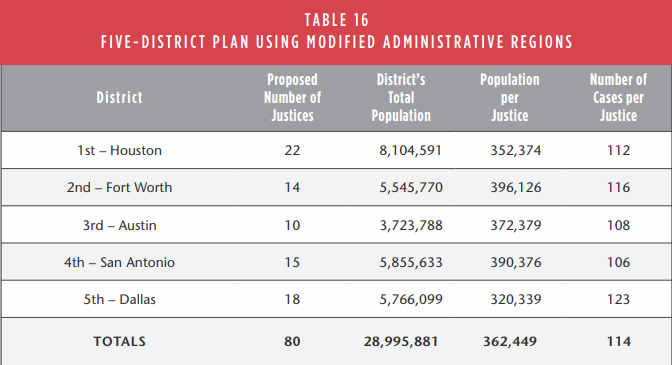
C. Transfer Administrative Authority to Intermediate Appellate Courts
Almost half of the currently serving regional presiding judges also are sitting judges; the others are retired judges. This suggests that the regional presiding judgeships do not require full-time attention.
Among the duties of regional presiding judges are the temporary assignment of trial court judges and the handling of recusal and disqualification motions. They make numerous temporary assignments to trial courts, but the vast majority of the assignments are routine, like temporarily filling a judgeship while the regular judge vacations or attends a conference. The activity that requires a more meaningful commitment of time is participating in in-person hearings of recusal/disqualification motions. There was a statewide total of 224 such hearings in 2019, and the regional presiding judges personally conducted around 140 of these hearings, or an average of thirteen such hearings per year for each regional presiding judge. Importantly, the regional presiding judges are not compelled to hear these motions; they can and do appoint other judges to hear many of the recusal and disqualification motions.
If the administrative districts were made to match the intermediate appellate court districts, the chief justice of each court of appeals arguably could serve as the regional administrative judge. It is unclear from public records the amount of money being expended to support the existing network of regional presiding judges, but some cost savings doubtless could be achieved by merging these functions into a single judicial officer. Merging the functions and eliminating two sets of unmatched districts also creates a more rational structure for Texas’s court system.
D. Reallocate Seats in Election Cycles
It is problematic to have a majority of Texas’s intermediate appellate court justices chosen by voters in the same election cycle. The Constitution was amended in 1981 to remove the mechanism for staggering the election cycles for new justices.[337] The statutes creating the various courts of appeals, and the judgeships on the courts of appeals, were not amended and thus continued to provide for staggered terms. Presumably, the Legislature did not realize that deleting the constitutional provision would result in the statute being declared unconstitutional. In other words, the Legislature likely intended for the election of intermediate appellate court justices to be staggered so that about a third of the justices would be elected each cycle, not malapportioned over time.
Remedying this anomaly will require an amendment to the Constitution. A provision in the Constitution could provide that when a disproportionate number of justices are chosen in a single election cycle, the Texas Secretary of State will draw lots to determine which of the seats in the overloaded election cycle will have a four-, six-, or eight-year term, as necessary, when the seat next appears on the ballot.
For example, on the First Court of Appeals (Houston), five of the nine seats on the court (the chief justice’s seat and places six, seven, eight, and nine) are elected in 2024, while two seats are filled in 2026 and two others are filled in 2028. As a nine-member court, a uniform distribution would require that three seats be filled in each election cycle. Consequently, one seat in the 2024 election cycle needs be on the ballot again in 2028 (a four-year term), and one seat in the 2024 election cycle needs to be on the ballot again in 2032 (an eight-year term). The other three 2024 seats would continue with six-year terms. This can be accomplished by having the Secretary of State draw lots to assign the four-, six-, and eight-year terms to the five seats on the ballot in 2024. Importantly, once a justice who is assigned a four- or eight-year term completes that term, that seat on the court reverts to a six-year term.
In order to balance the elections for the other courts:
- One of the four 2024 seats on the Fort Worth court would be assigned a four-year term, to move that seat to the 2028 election cycle, which currently elects only one of the seven judges to that court. The other three 2024 seats would continue with six-year terms.
- One of the four 2024 seats on the Austin court would be assigned a four-year term, and another would be assigned an eight-year term. The other two 2024 seats would continue with six-year terms.
- One of the five 2024 seats on the San Antonio court would be assigned a four-year term, and another would be assigned an eight-year term. The other three 2024 seats would continue with six-year terms.
- Two of the eight 2024 seats on the Dallas court would be assigned four-year terms, and one of the eight 2024 seats would be assigned an eight-year term. The other five 2024 seats would continue with six-year terms.
- One of the four 2024 seats on the Corpus Christi court would be assigned a four-year term, and another would be assigned an eight-year term. The other two 2024 seats would continue with six-year terms.
- One of the five 2024 seats on Houston’s Fourteenth Court of Appeals would be assigned a four-year term, and another would be assigned an eight-year term. The other three 2024 seats would continue with six-year terms.
Making these relatively minor adjustments will smooth the distribution of elections for seats on these important courts. The election cycles would be balanced again, as they historically were, and as they are for seats on the Supreme Court and Court of Criminal Appeals.
VI. CONCLUSION
The Texas judicial system is unnecessarily complex. Its defects serve to punish its users—parties, attorneys, judges, and court staff—by creating confusion and inconsistency, and by overburdening some aspects of the system. It also punishes Texas’s taxpayers, who fund these inefficiencies. It is time for the system to be reformed and repaired, and a good place to start is with the structure of Texas’s intermediate appellate courts. Correction of geographic and jurisdictional overlaps, along with reducing the number of courts, would decrease conflicts and increase the efficiency of our intermediate appellate court system. The changes recommended in this paper would also evenly and fairly distribute the workload between the intermediate appellate courts, streamline their administration, and aide litigants, attorneys, and citizens in understanding and navigating the Texas judicial system.
ENDNOTES
[1] See The Texas Judicial System, Recommendations for Reform, Texans for Lawsuit Reform Found. (2007), http://www.tlrfoundation.com/wp-content/uploads/2019/07/tlrf_courtadmin2007_ƒ_web.pdf [hereinafter TLR Recommendations for Reform].
[2] A 2004 law review article by James T. Worthen, Chief Justice of the Twelfth Court of Appeals (Tyler), provides a good overview of the development of Texas’s intermediate courts of appeals, including insights into the decision-making process for several changes to the state’s appellate court structure. See generally James T. Worthen, The Organizational & Structural Development of Intermediate Appellate Courts in Texas, 1892-2003, 46 S. Tex. L. Rev. 33 (2004).
[3] See Tex. Const. (1876, amended 1891) (available at https://tarlton.law.utexas.edu/c.php?g=813324). Five constitutions preceded the 1876 Constitution. See Constitutions of Texas 1824-1876, Tarlton L. Libr., https://tarlton.law.utexas.edu/constitutions/ (last updated Feb. 11, 2020).
[4] Tex. Const. art. V, § 1.
[5] Id. § 3.
[6] Id. §§ 5, 6. “Our dual high courts are largely meant to be co-equals—constitutional twins. This is anomalous among court systems, even in the only other two-court state, Oklahoma. Like Texas, Oklahoma has a Supreme Court that hears civil appeals and a Court of Criminal Appeals that hears criminal appeals. But there are two key differences. First, the Oklahoma Court of Criminal Appeals is subject to the power of the Legislature to change or abolish. Second, the Oklahoma Supreme Court is truly supreme; if there is a jurisdictional clash, the Supreme Court shall determine which court has jurisdiction and such determination shall be final. In other words, there are two states in the nation with two courts of last resort. But only one state—the Lone Star State—has a non-supreme Supreme Court.” In re Reece, 341 S.W.3d 360, 380-81 (Tex. 2011) (Willett, J., dissenting) (citations and internal quotations omitted).
[7] See Tex. S.J. Res. 16, 22d Leg., R.S., 1891 Tex. Gen. Laws 197 (available at https://lrl.texas.gov/scanned/sessionLaws/22-0/SJR_16.pdf), reprinted in 10 H.P.N. Gammel, The Laws of Texas 1822-1897, at 199 (Austin, Gammel Book Co. 1898) (available at https://texashistory.unt.edu/ark:/67531/metapth6733/m1/201/) [hereinafter Gammel’s Laws of Texas].
[8] Tex. Const. art. V, § 6 (1891) (amended 1980 and 1985).
[9] Id.
[10] Id. §§ 4, 5; see also Clarence Guittard, The Expanded Texas Courts of Appeals, 14 Tex. Tech. L. Rev. 549, 550 (1983) (noting that “the old court of appeals [was converted] into the court of criminal appeals”).
[11]Act of Apr. 13, 1892, 22d Leg., 1st C.S., J.C.S.S.B. 32 & H.B. 11, ch. 15, §§ 1-2, 1892 Tex. Gen. Laws 25 (available at https://www.lrl.texas.gov/scanned/sessionLaws/22-1/SB_32,_HB_11_CH_15.pdf), codified at Tex. Rev. Civ. Stat. arts. 987-1043 (1895) (available at http://www.sll.texas.gov/assets/pdf/historical-statutes/1895/1895-2-revised-civil-statutes-of-the-state-of-texas.pdf at 233), reprinted in 10 Gammel’s Laws of Texas, supra note 7, at 389 (available at https://texashistory.unt.edu/ark:/67531/metapth6733/m1/391/).
[12] Id. § 5.
[13] Id.
[14] See generally id. §§ 20-48. Texas’s court-made procedural rules were first promulgated in 1941. See Roy W. McDonald, The Background of the Texas Procedural Rules, 19 Tex. L. Rev. 229 (1941).
[15] Act of Apr. 13, 1892, 22d Leg., 1st C.S., S.B. 18, ch. 18, § 1, 1892 Tex. Gen. Laws 45 (available at https://www.lrl.texas.gov/scanned/sessionLaws/22-1/SB_18_CH_18.pdf), codified at Tex. Rev. Civ. Stat. arts. 992-994 (1895, amended 1893) (available at http://www.sll.texas.gov/assets/pdf/historical-statutes/1895/1895-2-revised-civil-statutes-of-the-state-of-texas.pdf at 233), reprinted in 10 Gammel’s Laws of Texas, supra note 7, at 409 (available at https://texashistory.unt.edu/ark:/67531/metapth6733/m1/411/).
[16] Id. §§ 2-4. Texas had 247 counties in 1892. Four counties were listed in the 1892 legislation that do not exist in Texas today—Buchel, Encinal, Foley, and Greer. Buchel and Foley were to be drawn from Brewster County (in the Fort Worth court’s district) and Encinal was to be created from part of Webb County (in the San Antonio court’s district), but none of these prospective counties were successfully formed. Greer County was formed but determined by the U.S. Supreme Court to be in United States territory (now Oklahoma), not Texas. The western boundary of the 1803 Louisiana Purchase was established by the Adams–Onís Treaty of 1819, between the United States and Spain, but not without ambiguity. Greer County was in an area claimed by both Texas and the United States. See Oklahoma v. Texas, 260 U.S. 606 (1923); see also Greer County, Tex. St. Hist. Ass’n, https://tshaonline.org/handbook/online/articles/hcg81 (last visited Dec. 5, 2020). Eleven counties were created after 1892—Brooks, Culberson, Hudspeth, Jim Hogg, Jim Wells, Kenedy, Kleberg, Reagan, Real, Terrell, and Willacy—giving Texas the 254 counties it has today. The historic maps provided in this paper are based on Texas’s current configuration and accurately reflect the geographic boundaries of the appellate courts’ districts, except with regard to Greer County.
[17] Act of May 13, 1893, 23rd Leg., R.S., S.B. 29, 36, 82, 126, 128, ch. 116, §§ 5-6, 1893 Tex. Gen. Laws 171 (available at https://www.lrl.texas.gov/scanned/sessionLaws/23-0/SB_29,_36,_82,_126,_128_CH_116.pdf), codified at Tex. Rev. Civ. Stat. arts. 993-994 (1895) (available at http://www.sll.texas.gov/assets/pdf/historical-statutes/1895/1895-2-revised-civil-statutes-of-the-state-of-texas.pdf at 234), reprinted in 10 Gammel’s Laws of Texas, supra note 7, at 601 (available at https://texashistory.unt.edu/ark:/67531/metapth6733/m1/603/). The 1893 legislation lists 246 counties, including three counties—Buchel, Encinal, and Greer—that do not exist in Texas today. Foley County, which was listed in the 1892 legislation, see supra note 16, was not included in the 1893 legislation; it was absorbed by Buchel County, which also subsequently failed to officially form as a county.
[18] Texas’s largest cities in 1890 were: Dallas (est. pop. 38,067), San Antonio (est. pop. 37,673), Galveston (est. pop. 29,084), Houston (est. pop. 27,557), Fort Worth (est. pop. 23,076), Austin (est. pop. 14,575), Waco (est. pop. 14,445), Laredo (est. pop. 11,319), and El Paso (est. pop. 10,338). See City Population History from 1850-2000, Tex. Almanac, https://texasalmanac.com/sites/default/files/images/CityPopHist%20web.pdf (last visited Dec. 5, 2020). Thus, only around 206,000 Texans lived in the nine largest cities, and the remainder of the 2,235,000 inhabitants were scattered throughout the state.
[19] Compare Act of May 13, 1893, 23d Leg., R.S., S.B. 29, 36, 82, 126, 128, ch. 116, § 6, 1893 Tex. Gen. Laws 171 (available at https://www.lrl.texas.gov/scanned/sessionLaws/23-0/SB_29,_36,_82,_126,_128_CH_116.pdf), with Tex. Rev. Civ. Stat. art. 994 (1895) (available at http://www.sll.texas.gov/assets/pdf/historical-statutes/1895/1895-2-revised-civil-statutes-of-the-state-of-texas.pdf at 234). As codified, Robertson County is in the Austin court’s district, not the Galveston court’s district; Ector, Glasscock, and Midland Counties are in the Fort Worth court’s district, not the Austin court’s district; Crane, Loving, Reeves, Upton, Ward, and Winkler Counties are in the Fort Worth court’s district, not the San Antonio court’s district; and Gregg and Smith Counties are in the Galveston court’s district, not the Dallas court’s district. No legislation supporting these changes from the 1893 legislative enactment was found.
[20]See Act of Apr. 3, 1911, 32d Leg., R.S., S.B. 10, 86, ch. 120, § 5, 1911 Tex. Gen. Laws 269 (available athttps://www.lrl.texas.gov/scanned/sessionLaws/32-0/SB_10_CH_120.pdf), reprinted in [15] Gammel’s Laws of Texas, supra note 7, at 279 (Supp. 1911) (available athttps://texashistory.unt.edu/ark:/67531/metapth9792/m1/279/) (noting “a great and constantly increasing accumulation of cases in the six Courts of Civil Appeals . . . [and] it is practically impossible for said courts to dispose of the business on their dockets with reasonable dispatch . . .”); see also Charles L. Black, Importance of the Courts of Appeals, 9 Tex. B.J. 426 (1946) (discussing reasons for creation of multiple intermediate appellate courts).
[21] Act of Apr. 29, 1907, 30th Leg., R.S., S.B. 58, ch. 174, § 3, 1907 Tex. Gen. Laws 324 (available at https://www.lrl.texas.gov/scanned/sessionLaws/30-0/SB_58_CH_CLXXIV.pdf), codified at Tex. Rev. Civ. Stat. arts. 29, 1586 (1911) (available at http://www.sll.texas.gov/assets/pdf/historical-statutes/1911/1911-2-revised-civil-statutes-of-the-state-of-texas.pdf at 18, 364), reprinted in [13] Gammel’s Laws of Texas, supra note 7, at 334 (Supp. 1907) (available at https://texashistory.unt.edu/ark:/67531/metapth6719/m1/334/?q=gammel%27s). The 1907 legislation lists 246 counties, including three counties that do not exist today (Buchel, Encinal, and Greer), and excluding eleven counties that do exist today (Brooks, Culberson, Hudspeth, Jim Hogg, Jim Wells, Kenedy, Kleberg, Reagan, Real, Terrell, and Willacy). See also supra note 16.
[22] Population data for the remaining paragraphs of this section were obtained from Settlements in Texas State, Population.us, https://population.us/settlement/tx/ (last visited Dec. 5, 2020).
[23] Tex. Const. art. V, § 6 (1891, amended 1980 and 1985).
[24] Act of Apr. 3, 1911, 32d Leg., R.S., S.B. 10, 86, ch. 120, §§ 2-4, 1911 Tex. Gen. Laws 269 (available at https://www.lrl.texas.gov/scanned/sessionLaws/32-0/SB_10_CH_120.pdf), codified at Tex. Rev. Civ. Stat. arts. 198, 1817 (as amended in 1915, 1923, and 1925) (available at http://www.sll.texas.gov/assets/pdf/historical-statutes/1925/1925-2-revised-civil-statutes-of-the-state-of-texas.pdf at 76, 512), reprinted in [15] Gammel’s Laws of Texas, supra note 7, at 279 (Supp. 1911) (available at https://texashistory.unt.edu/ark:/67531/metapth9792/m1/279/). The 1911 legislation included 245 counties. Newly-formed counties included in the legislation were Reagan and Terrell, both in the El Paso court’s district. Buchel, Encinal, Foley, and Greer Counties were not listed. See supra note 16.
[25] Act of Mar. 22, 1915, 34th Leg., R.S., S.B. 61, ch. 70, § 3, 1915 Tex. Gen. Laws 121 (available at https://www.lrl.texas.gov/scanned/sessionLaws/34-0/SB_61_CH_70.pdf), codified at Tex. Rev. Civ. Stat. arts. 198, 1817 (as amended in 1923 and 1925) (available at http://www.sll.texas.gov/assets/pdf/historical-statutes/1925/1925-2-revised-civil-statutes-of-the-state-of-texas.pdf at 76, 512), reprinted in [17] Gammel’s Laws of Texas, supra note 7, at 133 (Supp. 1915-17) (available at https://texashistory.unt.edu/ark:/67531/metapth12596/m1/133/?q=gammel). The legislation shows 252 counties, including newly-formed counties of Brooks, Culberson, Jim Hogg, Jim Wells, Kleberg, and Real.
[26] See Spindletop, Wikipedia, https://en.wikipedia.org/wiki/Spindletop (last visited Dec. 5, 2020).
[27] See Act of Mar. 22, 1915, 34th Leg., R.S., S.B. 61, ch. 70, § 3, 1915 Tex. Gen. Laws 121 (available at https://www.lrl.texas.gov/scanned/sessionLaws/34-0/SB_61_CH_70.pdf).
[28] Act of Mar. 13, 1923, 38th Leg., R.S. S.B. 197, ch. 74, § 3, 1923 Tex. Gen. Laws 152 (available at https://www.lrl.texas.gov/scanned/sessionLaws/38-0/SB_197_ch_74.pdf), codified at Tex. Rev. Civ. Stat. arts. 198, 1817 (as amended in 1925) (available at http://www.sll.texas.gov/assets/pdf/historical-statutes/1925/1925-2-revised-civil-statutes-of-the-state-of-texas.pdf at 76, 512). For the first time, all 254 of Texas’s current counties were included in the appellate court districts, including Hudspeth, Kenedy, and Willacy Counties, which had recently formed.
[29] Act of Mar. 17, 1925, 39th Leg., R.S., S.B. 189, ch. 87, § 2, 1925 Tex. Gen. Laws 258 (available at https://www.lrl.texas.gov/scanned/sessionLaws/39-0/SB_189_CH_87.pdf), codified in Tex. Rev. Civ. Stat. arts. 198, 1817 (1925) (available at http://www.sll.texas.gov/assets/pdf/historical-statutes/1925/1925-2-revised-civil-statutes-of-the-state-of-texas.pdf at 76, 512), reprinted in [22] Gammel’s Laws of Texas, supra note 7, at 1186 (Supp. 1923-25) (available at https://texashistory.unt.edu/ark:/67531/metapth15500/m1/1186/?q=gammel).
[30] See QuickFacts, Eastland County, Texas, U.S. Census Bureau, https://www.census.gov/quickfacts/fact/table/eastlandcountytexas/PST045219 (last visited Dec. 5, 2020).
[31] Act of Mar. 31, 1927, 40th Leg., R.S., S.B. 396, ch. 255, § 1, 1927 Tex. Gen. Laws 378 (available at https://www.lrl.texas.gov/scanned/sessionLaws/40-0/SB_396_CH_255.pdf), amending Tex. Rev. Civ. Stat. art. 198 (Vernon 1936) (available at http://www.sll.texas.gov/assets/pdf/historical-statutes/1936/1936-vernons-texas-statutes.pdf at 53), reprinted in [25] Gammel’s Laws of Texas, supra note 7, at 394 (Supp. 1927) (available at https://texashistory.unt.edu/ark:/67531/metapth16125/m1/394/?q=gammel); see also Miles v. Ford Motor Co., 914 S.W.2d 135, 137 n.3 (Tex. 1995) (per curiam) (summarizing evolution of intermediate appellate court districts). Baylor and Knox Counties were moved from the Fort Worth court’s district to the Eastland court’s district; Hood, Johnson, and Somervell Counties were moved from the Fort Worth court’s district to the Waco court’s district; Crockett County was moved from the Austin court’s district to the El Paso court’s district; Delta, Hunt, Rains, and Wood Counties were moved from the Dallas court’s district to the Texarkana court’s district; Navarro County was moved from the Dallas court’s district to the Waco court’s district; Borden, Dawson, and Howard Counties were moved from the Eastland court’s district to the El Paso court’s district.
[32] Act of Feb. 19, 1929, 41st Leg. R.S., H.B. 231, ch. 51, § 1, 1929 Tex. Gen. Laws 106 (available at https://www.lrl.texas.gov/scanned/sessionLaws/41-0/HB_231_CH_51.pdf), amending Tex. Rev. Civ. Stat. Ann. art. 198 (Vernon 1936) (available at http://www.sll.texas.gov/assets/pdf/historical-statutes/1936/1936-vernons-texas-statutes.pdf at 53), reprinted in [26] Gammel’s Laws of Texas, supra note 7, at 122 (Supp. 1929) (available at https://texashistory.unt.edu/ark:/67531/metapth16364/m1/122/?q=gammel).
[33] Act of Sept. 22, 1932, 42d Leg. 3rd C.S., H.B. 89, ch. 38, § 1, 1932 Tex. Gen. Laws 103 (available at https://www.lrl.texas.gov/scanned/sessionLaws/42-3/HB_89_CH_38.pdf), amending Tex. Rev. Civ. Stat. Ann. art. 198 (Vernon 1936) (available at http://www.sll.texas.gov/assets/pdf/historical-statutes/1936/1936-vernons-texas-statutes.pdf at 53), reprinted in [28] Gammel’s Laws of Texas, supra note 7, at 331 (Supp. 1931-33) (available at https://texashistory.unt.edu/ark:/67531/metapth17293/m1/331/?q=gammel).
[34] Act of Sept. 26, 1934, 43d Leg., 3rd C.S., S.B. 22, ch. 31, §§ 1, 2, 1934 Tex. Gen. Laws 54 (available at https://www.lrl.texas.gov/scanned/sessionLaws/43-3/SB_22_CH_31.pdf), amending Tex. Rev. Civ. Stat. Ann. art. 198 (Vernon 1936) (available at http://www.sll.texas.gov/assets/pdf/historical-statutes/1936/1936-vernons-texas-statutes.pdf at 53), reprinted in [29] Gammel’s Laws of Texas, supra note 7, at 308 (Supp. 1933-35) (available at https://texashistory.unt.edu/ark:/67531/metapth17292/m1/308/?q=gammel). Justice Worthen explains in his paper on Texas’s appellate courts that returning Hunt County to the Dallas court’s district in 1934 was “a favor to then Justice Ben F. Looney, who served on the Fifth Court but was from Greenville, the county seat of Hunt County. Looney never had an opponent during his career on the Fifth Court, which ended with his retirement in 1948, so if he thought he needed his home of Hunt County to help with his electoral fortunes, he was wrong.” Worthen, supra note 2, at 64.
[35] Act of Apr. 6, 1939, 46th Leg., R.S., H.B. 350, ch. 1, § 1, 1939 Tex. Gen. Laws 148 (available at https://lrl.texas.gov/scanned/sessionLaws/46-0/HB_350_CH_1.pdf), amending Tex. Rev. Civ. Stat. art. 198 (Vernon Supp. 1939) (available at http://www.sll.texas.gov/assets/pdf/historical-statutes/1939/1939-supplement-to-1936-vernons-texas-statutes.pdf at 61).
[36] Act of June 18, 1941, 47th Leg., R.S., H.B. 188, ch. 641, § 1, 1941 Tex. Gen. Laws 1408 (available at https://texashistory.unt.edu/ark:/67531/metapth307686/m1/1437/), amending Tex. Rev. Civ. Stat. Ann. art. 198 (Vernon Supp. 1942) (available at http://www.sll.texas.gov/assets/pdf/historical-statutes/1942/1942-supplement-to-1936-vernons-texas-statutes.pdf at 44).
[37] Act of June 6, 1957, 55th Leg., R.S., H.B. 14, ch. 421, § 2, 1957 Tex. Gen. Laws 1263 (available at https://www.lrl.texas.gov/scanned/sessionLaws/55-0/HB_14_CH_421.pdf), codified at Tex. Rev. Civ. Stat. Ann. arts. 1817, 1817a (Vernon Supp. 1958) (available at http://www.sll.texas.gov/assets/pdf/historical-statutes/1958/1958-supplement-to-1948-vernons-texas-statutes.pdf at 196).
[38] Act of May 21, 1963, 58th Leg., R.S., H.B. 68, ch. 198, § 2, 1963 Tex. Gen. Laws 539 (available at https://texashistory.unt.edu/ark:/67531/metapth221759/m1/875/?q=1963), amending Tex. Rev. Civ. Stat. Ann. arts. 198, 1817 (Vernon Supp. 1964) (available at http://www.sll.texas.gov/assets/pdf/historical-statutes/1964/1964-supplement-to-1948-vernons-texas-statutes.pdf at 23).
[39] Id. § 7.
[40] Act of June 5, 1963, 58th Leg., R.S., S.B. 516, ch. 357, § 1, 1963 Tex. Gen. Laws 927 (available at https://texashistory.unt.edu/ark:/67531/metapth221759/m1/1263/?q=1963), amending Tex. Rev. Civ. Stat. Ann. art. 198 (Vernon Supp. 1964) (available at http://www.sll.texas.gov/assets/pdf/historical-statutes/1964/1964-supplement-to-1948-vernons-texas-statutes.pdf at 23).
[41] Hunt County was in the Dallas and Texarkana courts’ districts. Kaufman and Van Zandt Counties were in the Dallas and Tyler courts’ districts. Gregg, Hopkins, Panola, Rusk, Upshur, and Wood Counties were in the Texarkana and Tyler courts’ districts.
[42] Act of June 18, 1967, 60th Leg., R.S., S.B. 261, ch. 728, §§ 2-3, 1967 Tex. Gen. Laws 1952 (available at https://texashistory.unt.edu/ark:/67531/metapth221761/m1/2088/?q=1967), amending Tex. Rev. Civ. Stat. Ann. arts. 198, 1817, 1817a (Vernon Supp. 1968) (available at http://www.sll.texas.gov/assets/pdf/historical-statutes/1968/1968-supplement-to-1948-vernons-texas-statutes.pdf at 42). The Fourteenth Court was authorized it to sit in either Galveston or Houston, but it always has been located in Houston. Id. § 3.
[43] See id. § 1 (listing counties included in each district).
[44] See id. § 3, amending Tex. Rev. Civ. Stat. Ann. art. 1817a. The Legislature amended the statute in 1983 to require that trial court clerks decide whether an appeal would be sent to the First or Fourteenth Court of Appeals. “The trial clerk shall write the numbers of the two Courts of Appeals on identical slips of paper and place the slips in a container. When a notice of appeal or appeal bond is filed, the trial court clerk shall draw a number from the container at random, in a public place, and shall assign the case . . . to the Court of Appeals for the corresponding number drawn.” Act of June 19, 1983, 68th Leg., R.S., S.B. 1144, ch. 653, § 1, 1983 Tex. Gen. Laws 4148 (available at https://www.lrl.texas.gov/scanned/sessionLaws/68-0/SB_1144_CH_653.pdf), amending Tex. Rev. Civ. Stat. art 1817a (West 1984) (available at http://www.sll.texas.gov/assets/pdf/historical-statutes/1984-2/1984-2-wests-texas-statutes-and-codes.pdf). The legislation also required the two appellate courts to establish a central clerk’s office. Id.
[45] Act of June 21, 1975, 64th Leg., R.S., H.B. 1019, ch. 726, § 1, 1975 Tex. Gen. Laws 2357 (available at https://www.lrl.texas.gov/scanned/sessionLaws/64-0/HB_1019_CH_726.pdf), adding Tex. Rev. Civ. Stat. Ann. art. 1817b (West Supp. 1975) (available at http://www.sll.texas.gov/assets/pdf/historical-statutes/1975/1975-supplement-to-1974-wests-texas-statutes-and-codes.pdf at 878).
[46] Id. § 3.
[47] Tex. S.J. Res. 45, 65th Leg., R.S., 1977 Tex. Gen. Laws 3366, amending Tex. Const. art. V, § 6 (available at https://www.lrl.texas.gov/scanned/sessionLaws/65-0/SJR_45.pdf) (providing that the courts of civil appeals “shall consist of a Chief Justice and at least two Associate Justices”).
[48] Act of June 15, 1977, 65th Leg., R.S., H.B. 1355, ch. 624, § 1, 1977 Tex. Gen. Laws 1531 (available at https://www.lrl.texas.gov/scanned/sessionLaws/65-0/HB_1355_CH_624.pdf), amending Tex. Rev. Civ. Stat. art. 1812 (West Supp. 1977) (available at http://www.sll.texas.gov/assets/pdf/historical-statutes/1977-2/1977-2-supplement-to-1974-wests-texas-statutes-and-codes.pdf at 1825).
[49] See Act of June 8, 1981, 67th Leg., R.S., S.B. 265, ch. 291, § 149, 1981 Tex. Gen. Laws 761, 820 (available at https://texashistory.unt.edu/ark:/67531/metapth221800/m1/865/?q=1981) (giving insight to the congested nature of the Court of Criminal Appeals’ docket, stating: “At least 1,800 appeals including death penalty appeals pending in the Court of Criminal Appeals prior to September 1, 1981, shall be retained by that court for disposition . . . . The remaining appeals pending in the Court of Criminal Appeals shall be transferred to the various courts of appeals on which the number of judges is increased by the 67th Session of the legislature; provided no more than 75 nondeath penalty appeals shall be transferred for each newly created judgeship . . . . ”); see also Worthen, supra note 2, at 38-39 (noting that Chief Justice Joe Greenhill, in his 1979 State of the Judiciary Message, stated that criminal cases were pending in the Court of Criminal Appeals for more than three years).
[50] Tex. S.J. Res. 36, 66th Leg., R.S., 1979 Tex. Gen. Laws 3223, amending Tex. Const. art. V, § 6 (available at https://lrl.texas.gov/scanned/sessionLaws/66-0/SJR_36.pdf).
[51] See generally Act of June 8, 1981, 67th Leg., R.S., S.B. 265, ch. 291, § 1 et seq., 1981 Tex. Gen. Laws 761 (available at https://texashistory.unt.edu/ark:/67531/metapth221800/m1/865/?q=1981); see also Tex. Const. art. V, § 6 historical notes.
[52] Tex. S.B. 265, §§ 101-102, 1981 Tex. Gen. Laws at 801-02 (available at https://www.lrl.texas.gov/scanned/sessionLaws/67-0/SB_265_CH_291.pdf), amending Tex. Code Crim. Proc. arts. 4.01, 4.02 (West Supp. 1981) (available at http://www.sll.texas.gov/assets/pdf/historical-statutes/1981-1/1981-1-supplement-to-1974-wests-texas-statutes-and-codes.pdf at 1496).
[53] Tex. S.B. 265, § 31, 1981 Tex. Gen. Laws at 776-77 (available at https://www.lrl.texas.gov/scanned/sessionLaws/67-0/SB_265_CH_291.pdf), amending Tex. Rev. Civ. Stat. Ann. art. 1812 (West Supp. 1981) (available at http://www.sll.texas.gov/assets/pdf/historical-statutes/1981-2/1981-2-supplement-to-1974-wests-texas-statutes-and-codes.pdf at 3073). As discussed in the body of the paper at note 47, in a bill passed by the Legislature in 1977, three justices were to be added to the Fort Worth court on January 1, 1983. In the 1981 legislation, the Legislature amended Texas Revised Civil Statutes article 1812(a) to provide that the Fort Worth court would have a chief justice and five associate justices effective September 1981; it also amended article 1812(b) to provide that the Austin court, rather than the Fort Worth court, would gain three justices at a later date. See Tex. S.B. 265, § 31 (1981) (available at https://lrl.texas.gov/LASDOCS/67R/SB265/SB265_67R.pdf at 31-33).
[54] Act of June 19, 1983, 68th Leg., R.S., H.B. 2229, ch. 1022, § 1, 1983 Tex. Gen. Laws 5446 (available at https://www.lrl.texas.gov/scanned/sessionLaws/68-0/HB_2229_CH_1022.pdf), codified at Tex. Rev. Civ. Stat. art. 1812a (West 1984) (available at http://www.sll.texas.gov/assets/pdf/historical-statutes/1984-2/1984-2-wests-texas-statutes-and-codes.pdf at 1417). The Texas Government Code was created in 1985. See Act of June 12, 1985, 69th Leg., R.S., S.B. 1228, ch. 480, § 1, 1985 Tex. Gen. Laws 1720 (available at https://www.lrl.texas.gov/scanned/sessionLaws/69-0/SB_1228_CH_480.pdf). Texas Revised Civil Statute article 198, allocating counties to the fourteen supreme judicial districts, became Texas Government Code section 22.201.
[55] Population Estimates of Texas Counties, 1981-84, Tex. St. Libr. & Archives Comm’n https://www.tsl.texas.gov/ref/abouttx/popcnty81-84.html (last modified June 6, 2018).
[56] In 1987, the Legislature changed nomenclature used to refer to the courts of appeals’ districts, striking references to “Supreme Judicial Districts” and substituting “Court of Appeals Districts.” Act of May 21, 1987, 70th Leg., R.S., S.B. 895, ch. 148, § 1.02, 1987 Tex. Gen. Laws 534 (available at https://www.lrl.texas.gov/scanned/sessionLaws/70-0/SB_895_CH_148.pdf).
[57] Act of June 18, 2003, 78th Leg., R.S., H.B. 3306, ch. 315, § 4, 2003 Tex. Gen. Laws 1337 (available at https://www.lrl.texas.gov/scanned/sessionLaws/78-0/HB_3306_CH_315.pdf), and Act of June 20, 2003, 78th Leg., R.S., H.B. 2261, ch. 662, § 1, 2003 Tex. Gen. Laws 2081 (available at https://www.lrl.texas.gov/scanned/sessionLaws/78-0/HB_2261_CH_662.pdf), both amending Tex. Gov’t Code Ann. § 22.201.
[58] Tex. H.B. 3306, §§ 5, 6 and Tex. H.B. 2261, §§ 3, 4, both amending Tex. Gov’t Code Ann. § 22.216.
[59] Act of May 15, 2003, 78th Leg., R.S., H.B. 988, ch. 44, § 1, 2003 Tex. Gen. Laws 81 (available at https://www.lrl.texas.gov/scanned/sessionLaws/78-0/HB_988_CH_44.pdf), amending Tex. Gov’t Code Ann. § 22.201.
[60] Act of June 17, 2005, 79th Leg., R.S., H.B. 1077, ch. 542, § 1, 2005 Tex. Gen. Laws 542 (available at https://www.lrl.texas.gov/scanned/sessionLaws/79-0/HB_1077_CH_542.pdf), amending Tex. Gov’t Code Ann. § 22.201.
[61] Id.
[62] Id.
[63] Id
[64] Id.
[65] See also Miles v. Ford Motor Co., 914 S.W.2d 135, 137 n.3 (Tex. 1995).
[66] See David J. Schenck, Are We Finally Ready to Reshape Texas Appellate Courts for the 21st Century?, 41 Tex. Tech L. Rev. 221, 227-28 (2009).
[67] Tex. Gov’t Code Ann. §§ 22.201-.215.
[68] The fiscal year for the State of Texas is from September 1 to August 31.
[69] See Office of Court Administration, Annual Statistical Report for the Texas Judiciary: Fiscal Year 2019, Tex. Jud. Branch at Court-Level 16, Detail 8 (pages 66 and 116 of the document) (2019), http://txcourts.gov/media/1445760/fy-19-annual-statistical-report.pdf [hereinafter 2019 Texas Judiciary Statistical Report].
[70] 2019 Texas Judiciary Statistical Report, supra note 69, at Detail 8 (page 116 of the document).
[71] For purposes of these calculations, the Houston courts were excluded because the population and caseloads do not meaningfully depart from the average.
[72] Act of Apr. 19, 1895, 24th Leg., R.S., S.B. 49, 1895 Tex. Gen. Laws 79, codified at Tex. Rev. Civ. Stat. art. 994a (1895) (available at http://www.sll.texas.gov/assets/pdf/historical-statutes/1895/1895-2-revised-civil-statutes-of-the-state-of-texas.pdf), reprinted in 10 Gammel’s Laws of Texas, supra note 7, at 809 (available at https://texashistory.unt.edu/ark:/67531/metapth6733/m1/812/). The court of appeals to which a case is transferred has jurisdiction of the case without regard to the district in which the case originally was tried. Tex. Gov’t Code Ann. § 73.002(a).
[73] See Tex. Rev. Civ. Stat. art. 1738 (West 1984) (available at http://www.sll.texas.gov/assets/pdf/historical-statutes/1984-2/1984-2-wests-texas-statutes-and-codes.pdf).
[74] See generally Act of June 12, 1985, 69th Leg., R.S., S.B. 1228, ch. 480, § 1, 1985 Tex. Gen. Laws 1720, 2022 (available at https://www.lrl.texas.gov/scanned/sessionLaws/69-0/SB_1228_CH_480.pdf).
[75] See Act of June 20, 1999, 76th Leg., R.S., H.B. 1, ch. 1589, § 1, art. IV, 1999 Tex. Gen. Laws 5446, 5926 (available at https://www.lrl.texas.gov/scanned/sessionLaws/76-0/HB_1_CH_1589.pdf).
[76] See Act of June 12, 2017, 85th Leg., R.S., S.B. 1, ch. 605, § 1, art. IV, 2017 Tex. Gen. Laws 2179 (available at https://www.lrl.texas.gov/scanned/sessionLaws/85-0/SB_1_CH_605.pdf).
[77] See Act of June 15, 2019, 86th Leg., R.S., H.B. 1, ch. 1353, art. IV (available at https://lrl.texas.gov/scanned/signedBills/86-0/HB1.pdf).
[78] See Worthen, supra note 2, at 60-64.
[79] See, e.g., Transfer of Cases from Courts of Appeals, Tex. Sup. Ct. Misc. Docket No. 20-9090, at 1 (July 30, 2020) (available at http://www.txcourts.gov/media/1449541/209090.pdf) (“Except as otherwise provided by this Order, the first 10 cases filed in the Court of Appeals for the First Court of Appeals District, Houston, Texas, on or after July 3, 2020, are transferred to the Court of Appeals for the Eleventh Court of Appeals District, Eastland, Texas, and the next 20 cases filed in the Court of Appeals for the First Court of Appeals District, Houston, Texas are transferred to the Court of Appeals for the Twelfth Court of Appeals District, Tyler, Texas.”).
[80] See Office of Court Administration, 2019 Annual Statistical Report, Courts of Appeals, Activity for the Fiscal Year Ended August 31, 2019, Tex. Jud. Branch, https://www.txcourts.gov/statistics/annual-statistical-reports/2019/.
[81] Tex. Gov’t Code Ann. § 73.003.
[82] Id. § 73.003(b).
[83] Id. § 73.003(c).
[84] Id. § 73.003(e).
[85] See Walsweer v. Harris Cty. (Walsweer I), 796 S.W.2d 269, 271 (Tex. App.—Eastland 1990, writ denied).
[86] Id.
[87] Id. at 271-72.
[88] See Harris County v. Walsweer (Walsweer III), 930 S.W.2d 659, 662 n.1 (Tex. App.—Houston [1st Dist.] 1996, writ denied).
[89] See Walsweer I, 796 S.W.2d at 272-76.
[90] See Harris County v. Walsweer (Walsweer II), No. 6-92-079-CV, slip op. at 5 (Tex. App.—Texarkana Nov. 24, 1992, no writ) (not designated for publication).
[91] See Walsweer III, 930 S.W.2d at 663 n.2.
[92] Walsweer II, slip op. at 5.
[93] Walsweer III, 930 S.W.2d at 662-63.
[94] Id. at 663.
[95] Id. at 663-67.
[96] Report of the Court Administration Task Force, St. B. Tex. 52-53 (Oct. 2008), http://www.ccl.hctx.net/criminal/examine/CourtAdminTaskForceRpt.pdf.
[97] TLR Recommendations for Reform, supra note 1, at 79.
[98] Texas Supreme Court Administrative Orders 2018, Tex. Jud. Branch (Apr. 12, 2018), https://www.txcourts.gov/supreme/administrative-orders/2018/ (Order Nos. 18-9053 to 18-9057).
[99] Id.
[100] See TLR Recommendations for Reform, supra note 1, at 78-79 (noting that two panels of the San Antonio Court of Appeals, in opinions handed down only thirty-five days apart, offered differing opinions about how precedent should be applied in transferred cases).
[101] See Tex. R. App. P. 41.3.
[102] Id. cmt. to 2008 change.
[103] Tex. R. App. P. 41.3.
[104] Id. cmt. to 2008 change.
[105] Tex. Rev. Civ. Stat. art. 1812(b) (West Supp. 1977) (available at http://www.sll.texas.gov/assets/pdf/historical-statutes/1977-2/1977-2-supplement-to-1974-wests-texas-statutes-and-codes.pdf at 1825).
[106] Tex. Const. art. V, § 6(a) (providing that the courts shall sit in sections as authorized by law); Tex. Gov’t Code Ann. § 22.222(a) (providing that each court of appeals may sit in panels of not fewer than three justices).
[107] See Tex. R. App. P. 41.1(a).
[108] See Worthen, supra note 2, at 43-44 (describing method for selecting panels).
[109] Tex. Gov’t Code Ann. § 22.222(b) (“If more than one panel is used, the court of appeals shall establish rules to periodically rotate the justices among the panels. Permanent civil and criminal panels without rotation may not be established.”).
[110] See Worthen, supra note 2 (describing how the courts worked in 2004).
[111] Population Estimates of Texas Counties, 1981-84, supra note 55.
[112] See Courts of Appeals, Analysis of Activity for the Year Ending August 31, 1984, Tex. Jud. Branch 112, 119 (pages 1 and 8 of the scanned document), https://www.txcourts.gov/All_Archived_documents/JudicialInformation/pubs/ar92/coas/COA84.pdf.
[113] Id. at 112 (page 1 of the scanned document).
[114] Id. at 116 (page 5 of the scanned document).
[115] Id. at 121 (page 10 of the scanned document).
[116] 2019 Texas Judiciary Statistical Report, supra note 69, at Court-Level 18 (page 68 of the document).
[117] 2019 Texas Judiciary Statistical Report, supra note 69, at Court-Level 18 (page 68 of the document). “Submission” is the date the parties have completed briefing the case and a panel is assigned.
[118] There were 5,681 civil and 4,714 criminal appeals. 2019 Texas Judiciary Statistical Report, supra note 69, at Court-Level 16 (page 66 of the document).
[119] See supra note 49 and accompanying text.
[120] See infra Section II.D.5.
[121] The data in Charts 1 and 2 was obtained from the Annual Statistical Supplements published by the Texas Office of Court Administration, which are available at http://www.txcourts.gov/statistics/annual-statistical-reports/.
[122] See Order Requiring Electronic Filing in Certain Courts, Tex. Sup. Ct. Misc. Docket No. 12-9208 at 1 (Dec. 11, 2012) (available at https://www.txcourts.gov/All_Archived_Documents/SupremeCourt/AdministrativeOrders/miscdocket/12/12920600.pdf).
[123] Id.
[124] Id. at 4.
[125] Id.
[126] Id.
[127] See Order Mandating Statewide Electronic Filing in Criminal Cases, Tex. Crim. App. Misc. Docket No. 16-003 at 1-2 (June 30, 2016) (available at https://www.txcourts.gov/media/1403644/16-003-order-mandating-statewide-electronic-filing-in-criminal-cases.pdf).
[128] Id.
[129] Id.
[130] Tex. R. App. P. 25.
[131] Tex. R. App. P. 34.
[132] Tex. R. App. P. 34.5, 34.6.
[133] Tex. R. App. P. 34.5(a).
[134] Tex. R. App. P. 34.6(a).
[135] Tex. R. App. P. 38.
[136] Tex. R. App. P. 38.1, 38.2.
[137] Tex. R. App. P. 38.3.
[138] Tex. R. App. P. 38.1(e), 39.7.
[139] Tex. R. App. P. 39.1, 39.8.
[140] Tex. R. App. P. 39.8.
[141] Tex. R. App. P. 43, 47.
[142] Tex. R. App. P. 43.
[143] See supra Section II.D.2.
[144] Tex. R. App. P. 35.3(c).
[145] See Worthen, supra note 2, at 47.
[146] See Worthen, supra note 2, at 47.
[147] See Worthen, supra note 2, at 47.
[148] See Worthen, supra note 2, at 47.
[149] See Worthen, supra note 2, at 47.
[150] See supra Section II.A.
[151] See supra Section II.A.
[152] The data in Table 5 was obtained from James Worthen’s 2004 paper. See Worthen, supra note 2.
[153] The data in Table 6 was derived from the historic legislative appropriations requests (LAR) filed by the courts with the Legislative Budget Board. See Legislative Appropriation Requests, Legis. Budget Bd., http://docs.lbb.state.tx.us/display.aspx?DocType=LAR&agy=221&fy=2018 (last visited Dec. 5, 2020). Each court submits an LAR in advance of each regular session of the Legislature. Each LAR includes an organizational chart showing current staffing. The data in Table 6 was derived from the courts’ 2020–2021 LARs because these LARs show actual staffing for 2019, not proposed staffing for the 2020–2021 biennium.
[154] Worthen, supra note 2, at 55.
[155] See Courts of Appeals, Analysis of Activity for the Year Ending August 31, 1985, Tex. Jud. Branch, http://www.txcourts.gov/All_Archived_documents/JudicialInformation/pubs/ar92/coas/COA85.pdf.
[156] Tex. Const. art. V, § 5a.
[157] See Texas General Appropriations Act for the 2018-19 Biennium, 85th Leg., R.S., S.B. 1, ch. 605, § 1, art. IV, 2017 Tex. Gen. Laws 1648, 2179 (available at https://www.lrl.texas.gov/scanned/sessionLaws/85-0/SB_1_CH_605.pdf at 532).
[158] See, e.g., id. art. IV-8 n.1, 2017 Tex. Gen. Laws at 2185 (providing performance measure targets for Houston’s First Court of Appeals).
[159] See id. at xi (available at http://www.lbb.state.tx.us/Documents/GAA/General_Appropriations_Act_2018-2019.pdf, at 15).
[160] This includes salaries for judges, district attorneys, and court staff; monies contributed to the judicial retirement system and to pay for court personnel healthcare; funds used to pay attorneys to defend indigent criminal defendants; funds used for judicial training; the cost of operating the State Law Library and the Judicial Conduct Commission; funds appropriated for the myriad programs supported by the Office of Court Administration; and all other judicial system-related expenditures.
[161] Id. at IV-44 (page 580 of the document).
[162] See Act of June 15, 2019, 86th Leg., R.S., H.B. 1, ch. 1353, art. IV (available at https://lrl.texas.gov/scanned/signedBills/86-0/HB1.pdf).
[163] Five counties in northeast Texas—Gregg, Hunt, Rusk, Upshur, and Wood—are currently in two different appellate districts, while ten southeast Texas counties—Austin, Brazoria, Chambers, Colorado, Fort Bend, Galveston, Grimes, Harris, Waller, and Washington—are in the two Houston courts’ districts. Tex. Gov’t Code Ann. § 22.201(f), (g), (m); id. § 22.216.
[164] Miles v. Ford Motor Co., 914 S.W.2d 135, 139 (Tex. 1995) (“We have been unable to find any other state in the union which has created geographically overlapping appellate districts.”).
[165] Tex. Gov’t Code Ann. § 22.202(h).
[166] See Miles, 914 S.W.2d at 137 (noting that “appellants are free to elect either appellate route” when the districts overlap).
[167] Id. at 138.
[168] Id. at 137.
[169] Id.
[170] Id. at 138.
[171] Id.
[172] Id. at 139-40 (citing 1995 Report of the Supreme Court to the Legislature Regarding Appellate Courts (“The primary recommendation of the Court at this time is to eliminate the current jurisdictional overlaps that occur between two or more Courts of Appeals in ten counties, and in one instance, in three counties.”); 1993 Report of the Supreme Court to the Legislature Regarding Appellate Courts (“No county should be in more than one appellate district.”); 1986 Report on the Reapportionment of the Courts of Appeals Districts as adopted by the Supreme Court of Texas and the Texas Judicial Council (“All current overlapping districts should be eliminated except for the 1st and 14th districts which are coterminous.”)).
[173] See Kem Thompson Frost, Unclaimed Treasure: Greater Rule-of-Law Benefits for the Taking in Texas, 58 Hous. L. Rev. 1 (2020) (discussing the problems created by the two Houston intermediate appellate courts having coterminous jurisdiction).
[174] Reyes v. City of Houston, 4 S.W.3d 459 (Tex. App.—Houston [1st Dist.] 1999, pet. denied).
[175] See Montes v. City of Houston, No. 14-99-00174-CV, 2000 WL 1228618 (Tex. App.—Houston [14th Dist.] Aug. 31, 2000, pet. denied).
[176] Recommendations for Reallocation of Courts of Appeals, Tex. Sup. Ct. Misc. Docket No. 02-9232 at 1 (Dec. 17, 2002) (available at https://www.txcourts.gov/All_Archived_Documents/SupremeCourt/AdministrativeOrders/miscdocket/02/02923200.pdf).
[177] See supra Section II.A.
[178] The 12th, 155th, and 253rd District Courts.
[179] The 21st, 25th, 2nd, 25th, and 335th District Courts.
[180] Tex. Const. art. V, § 6.
[181] Tex. S.J. Res. 45, 65th Leg., R.S., 1977 Tex. Gen. Laws 3366 (available at https://www.lrl.texas.gov/scanned/sessionLaws/65-0/SJR_45.pdf), amending Tex. Const. art. V, § 6 (providing that the courts of civil appeals “shall consist of a Chief Justice and at least two Associate Justices”).
[182] Act of June 15, 1977, 65th Leg., R.S., H.B. 1355, ch. 624, § 1, 1977 Tex. Gen. Laws 1531 (available at https://www.lrl.texas.gov/scanned/sessionLaws/65-0/HB_1355_CH_624.pdf), amending Tex. Rev. Civ. Stat. art. 1812 (West Supp. 1977) (available at http://www.sll.texas.gov/assets/pdf/historical-statutes/1977-2/1977-2-supplement-to-1974-wests-texas-statutes-and-codes.pdf at 1825).
[183] Tex. Const. art. V, § 6 (1979).
[184] Id.
[185] Tex. S.J. Res. 36, 66th Leg., R.S., 1979 Tex. Gen. Laws 3223 (available at https://lrl.texas.gov/scanned/sessionLaws/66-0/SJR_36.pdf), amending Tex. Const. art. V, § 6.
[186] See generally Act of June 8, 1981, 67th Leg., R.S., S.B. 265, ch. 291, § 1 et seq., 1981 Tex. Gen. Laws 761 (available at https://texashistory.unt.edu/ark:/67531/metapth221800/m1/865/?q=1981); see also Tex. Const. art. V, § 6 historical notes.
[187] Id. § 31, 1981 Tex. Gen. Laws at 776-77 (available at https://www.lrl.texas.gov/scanned/sessionLaws/67-0/SB_265_CH_291.pdf), amending Tex. Rev. Civ. Stat. Ann. art. 1812 (West Supp. 1981) (available at http://www.sll.texas.gov/assets/pdf/historical-statutes/1981-2/1981-2-supplement-to-1974-wests-texas-statutes-and-codes.pdf at 3073).
[188] See Draughn v. Brown, 651 S.W.2d 728, 729 (Tex. 1983).
[189] Id.
[190] Id. at 730.
[191] See Tex. Const. art. V, § 31 (the Supreme Court is responsible for the efficient administration of the judicial branch and has authority to promulgate rules of civil procedure, rules of administration, and such other rules as may be prescribed by law); Tex. Gov’t Code Ann. § 22.004(a) (giving the Court “full rulemaking power in the practice and procedure in civil actions”); Tex. Gov’t Code Ann. § 74.021 (giving the Court supervisory and administrative control over the judicial branch and responsibility for the orderly and efficient administration of justice).
[192] See Tex. Gov’t Code Ann. §§ 22.110(a), 22.111, 56.001(a), 74.025. The Court of Criminal Appeals also has authority to promulgate rules of evidence and appellate procedure for criminal cases. Id. §§ 22.108, 22.109.
[193] Id. § 74.003(a), (b).
[194] Id. § 73.001; see also supra Section II.C.
[195] See Texas General Appropriations Act for the 2018-19 Biennium, 85th Leg., R.S., S.B. 1, ch. 605, § 7, art. IV-39, 2017 Tex. Gen. Laws 2216 (available at http://www.lbb.state.tx.us/Documents/GAA/General_Appropriations_Act_2018-2019.pdf at 569).
[196] Tex. Gov’t Code Ann. § 74.042.
[197] Id. § 74.045(a). A retired judge must be voluntarily retired (not defeated in an election) and must reside within the administrative region. Id. § 74.045(b).
[198] A list of regional presiding judges is available at http://www.txcourts.gov/media/1441425/ajrs-04_25_18.pdf. The presiding judges of the First, Fifth, Seventh, Eighth, and Tenth districts are active trial court judges.
[199] Tex. Gov’t Code Ann. § 74.046.
[200] See Tex. Code Crim. Proc. Ann. art. 26.052(c); Tex. Gov’t Code Ann. § 78.056.
[201] Tex. Gov’t Code Ann. § 74.048(a), (b).
[202] Id. § 14.056(b).
[203] Id. § 74.056(a).
[204] See Tex. Const. art. V, § 11 (grounds for disqualification of a judge); Tex. Gov’t Code Ann. § 21.005 (same); Tex. R. Civ. P. 18a (grounds for disqualification or recusal of a judge).
[205] See Tex. R. Civ. P. 18a(c).
[206] Tex. R. Civ. P. 18a(d).
[207] Administrative Judicial Region Presiding Judges Report, September 2018 to August 2019, Tex. Jud. Branch (Jan. 17, 2020), http://www.txcourts.gov/media/1445598/pj-report-sep-2018-to-august-2019-corrected-1_17_20.pdf [hereinafter FY 2019 Presiding Judges Report].
[208] FY 2019 Presiding Judges Report, supra note 207.
[209] FY 2019 Presiding Judges Report, supra note 207.
[210] Tex. Gov’t Code Ann. § 74.049.
[211] Id. § 74.001(a), (b).
[212] Id. §§ 74.005, 74.044.
[213] FY 2019 Presiding Judges Report, supra note 207.
[214] FY 2019 Presiding Judges Report, supra note 207.
[215] Comprised of Jasper and Newton Counties in the Second Administrative Region and Sabine and San Augustine Counties in the Tenth Administrative Region.
[216] Comprised of Madison and Walker Counties in the Second Administrative Region and Leon County in the Tenth Administrative Region.
[217] Comprised of Kimble, Mason, and McCullough Counties in the Sixth Administrative Region and Menard County in the Seventh Administrative Region.
[218] Tex. Gov’t Code Ann. §§ 22.201-.215.
[219] See 28 U.S.C. § 41; see also Court Role and Structure, U.S. Cts., https://www.uscourts.gov/about-federal-courts/court-role-and-structure (last visited Dec. 5, 2020). The intermediate appellate court system is comprised of twelve regional circuit courts and the Court of Appeals for the Federal Circuit, which has nationwide jurisdiction to hear appeals in specialized cases, such as cases involving patent laws. The list of authorized judgeships is available at https://www.uscourts.gov/sites/default/files/appealschronol.pdf.
[220] See California Courts of Appeal, Cal. Cts., https://www.courts.ca.gov/courtsofappeal.htm (last visited Dec. 5, 2020). The California courts of appeals are authorized for 106 judgeships. Currently, only 98 judges serve on these courts. The First District Court of Appeals has five divisions of four judges each, all in the same location. The Second District Court of Appeals is divided into eight divisions of four judges each, seven of which are in the same building in Los Angeles and one of which is in Ventura, California. The Forth District Court of Appeals is divided into three divisions, each located in a separate city. The Third and Fifth District Courts of Appeals do not have divisions. Thus, while there are six intermediate appellate courts, these courts are physically located in nine cities.
[221] See District Courts of Appeal, Fla. Cts., https://www.flcourts.org/Florida-Courts/District-Courts-of-Appeal (last visited Dec. 5, 2020). Two judges on Florida’s Fifth District Court of Appeals are senior judges.
[222] See Information for and About Judges, N.Y. Cts., http://www.nycourts.gov/judges/ (last visited Dec. 5, 2020).
[223] See Illinois Appellate Court, Ill. Cts., http://www.illinoiscourts.gov/AppellateCourt/default.asp (last visited Dec. 5, 2020). The twenty-four judges on the court in the First District are divided into six divisions, with four judges each. The divisions are not geographically dispersed and appear to be similar to the panels used by Texas’s larger appellate courts, although the judges on the divisions do not rotate between divisions.
[224] See The Superior Court of Pennsylvania, Unified Jud. Sys. Pa., http://www.pacourts.us/courts/superior-court/ (last visited Dec. 5, 2020); Commonwealth Court of Pennsylvania, Unified Jud. Sys. Pa., http://www.pacourts.us/courts/commonwealth-court/ (last visited Dec. 5, 2020). Seven judges on the Superior Court and one judge on the Commonwealth Court are listed as senior judges.
[225] See Ohio Courts of Appeals, Sup. Ct. Ohio & Ohio Jud. Sys., https://www.supremecourt.ohio.gov/JudSystem/districtCourts/ (last visited Dec. 5, 2020).
[226] See Judges, Ct. App. Ga., https://www.gaappeals.us/biography/index.php (last visited Dec. 5, 2020).
[227] See Court of Appeals, N.C. Jud. Branch, https://www.nccourts.gov/courts/court-of-appeals (last visited Dec. 5, 2020).
[228] See Michigan Court of Appeals, Mich. Cts., https://courts.michigan.gov/courts/coa/pages/default.aspx (last visited Dec. 5, 2020).
[229] In re Reece, 341 S.W.3d 360, 381-82 (Tex. 2011) (Willett, J., dissenting) (citations omitted); see also Miles v. Ford Motor Co., 914 S.W.2d 135, 139-40 (Tex. 1995) (citing 1995 Report of the Supreme Court to the Legislature Regarding Appellate Courts (“The primary recommendation of the Court at this time is to eliminate the current jurisdictional overlaps that occur between two or more Courts of Appeals in ten counties, and in one instance, in three counties.”); 1993 Report of the Supreme Court to the Legislature Regarding Appellate Courts (“No county should be in more than one appellate district.”); 1986 Report on the Reapportionment of the Courts of Appeals Districts as adopted by the Supreme Court of Texas and the Texas Judicial Council (“All current overlapping districts should be eliminated except for the 1st and 14th districts which are coterminous.”)).
[230] See Schenck, supra note 66.
[231] Id. at 225.
[232] Id.
[233] See TLR Recommendations for Reform, supra note 1.
[234] See TLR Recommendations for Reform, supra note 1, at 75-79.
[235] See Scott Brister, Is it Time to Reform Our Courts of Appeals?, 40 Hous. Law. 22 (Mar./Apr. 2003).
[236] See generally id.
[237] See Recommendations for Reallocation of Courts of Appeals, Tex. Sup. Ct. Misc. Docket No. 02-9232 (Dec. 17, 2002) (available at https://www.txcourts.gov/All_Archived_Documents/SupremeCourt/AdministrativeOrders/miscdocket/02/02923200.pdf).
[238] See id.
[239] See In re Reece, 341 S.W.3d 360, 378-89 (Tex. 2011) (Willett, J., dissenting) (critiquing Texas’s judicial system and discussing multiple recommendations to restructure it).
[240] Schenck, supra note 66, at 226.
[241] See Brister, supra note 235, at 23-24; see also Wagner Brown, Ltd. v. Horwood, 53 S.W.3d 347 (Tex. 2001) (Hecht, J., dissenting) (discussion of disputes among Texas courts of appeals).
[242] See Montes v. City of Houston, 66 S.W.3d 267 (Tex. 2001).
[243] Id. at 267; see also supra Section II.F.
[244] Schenck, supra note 66, at 226.
[245] Miles v. Ford Motor Co., 914 S.W.2d 135, 139 (Tex. 1995) (“We have been unable to find any other state in the union which has created geographically overlapping appellate districts.”).
[246] In re Reece, 341 S.W.3d 360, 384 (Tex. 2011) (Willett, J., dissenting) (citing Miles, 914 S.W.2d at 139-40).
[247] Tex. Gov’t Code Ann. § 22.201(b), (o); see Schenck, supra note 66, at 226.
[248] Tex. Gov’t Code Ann. § 22.202(h).
[249] See Schenck, supra note 66, at 226.
[250] Tex. Gov’t Code Ann. § 22.202(f), (g), (m).
[251] See Miles, 914 S.W.2d at 137.
[252] See id. at 137-39.
[253] See Recommendations for Reallocation of Courts of Appeals, Tex. Sup. Ct. Misc. Docket No. 02-9232 at 1 (Dec. 17, 2002) (available at https://www.txcourts.gov/All_Archived_Documents/SupremeCourt/AdministrativeOrders/miscdocket/02/02923200.pdf).
[254] Id.
[255] See generally supra Section II.A (detailing history of Texas’s intermediate appellate courts).
[256] See supra Section II.D.2.
[257] In 2003, the number of justices on the El Paso court was reduced by one, and a justice was added to the Beaumont court at the same time. See Act of June 18, 2003, 78th Leg., R.S., H.B. 3306, ch. 315, §§ 5, 6, 2003 Tex. Gen. Laws 1337 (available at https://www.lrl.texas.gov/scanned/sessionLaws/78-0/HB_3306_CH_315.pdf), and Act of June 20, 2003, 78th Leg., R.S., H.B. 2261, ch. 662, §§ 3, 4, 2003 Tex. Gen. Laws 2081 (available at https://www.lrl.texas.gov/scanned/sessionLaws/78-0/HB_2261_CH_662.pdf), both amending Tex. Gov’t Code Ann. § 22.216.
[258] See supra Section II.D.5.
[259] See supra Section II.C.
[260] Harris County v. Walsweer, 930 S.W.2d 659, 662-63 nn.1, 2 (Tex. App.—Houston [1st Dist.] 1996, writ denied).
[261] See Texas Supreme Court Administrative Orders 2018, Tex. Jud. Branch (Apr. 12, 2018), https://www.txcourts.gov/supreme/administrative-orders/2018/ (Order Nos. 18-9053 to 18-9057); see also supra Section II.C.
[262] Tex. Const. art. V, § 6; Tex. Gov’t Code Ann. § 22.222.
[263] See Worthen, supra note 2.
[264] Schenck, supra note 66, at 228.
[265] See supra Section II.E.
[266] See generally supra Section II.E (discussing staffing of clerks’ offices).
[267] U.S. Const. amend XV, § 1.
[268] U.S. Const. amend XIV, § 1.
[269] Baker v. Carr, 369 U.S. 186, 208-36 (1962).
[270] Wesberry v. Sanders, 376 U.S. 1, 7-48 (1964) (holding that Article One of the U.S. Constitution requires U.S. House districts to have approximately equal populations).
[271] Reynolds v. Sims, 377 U.S. 533, 568 (1964) (holding that the Fourteenth Amendment’s Equal Protection Clause requires states to establish legislative districts of approximately equal populations); see also Hadley v. Junior Coll. Dist., 397 U.S. 50, 56 (1970) (as a general rule, “whenever a state or local government decides to select persons by popular election to perform governmental functions, the Equal Protection Clause of the Fourteenth Amendment requires that each qualified voter must be given an equal opportunity to participate in that election.”).
[272] Wells v. Edwards, 409 U.S. 1095 (1973).
[273] Chisolm v. Roemer, 501 U.S. 380, 403 (1991) (noting that while Wells established that the one-person, one-vote principle does not apply to judicial elections, it does not mean judicial elections are entirely immune from voter dilution claims).
[274] See Mobile v. Bolden, 446 U.S. 55, 61-65 (1980) (proof of intent to discriminate required for violation of Fifteenth Amendment); Arlington Heights v. Metro. Hous. Corp., 429 U.S. 252, 264-68 (1977) (Fourteenth Amendment requires an intent to discriminate based on race).
[275] U.S. Const. amend XIV, § 5; U.S. Const. amend XV, § 2.
[276] See Voting Rights Act of 1965, Pub. L. No. 89-110, 79 Stat. 437 (available at https://www.crmvet.org/docs/vra65.pdf).
[277] 52 U.S.C. § 10301(a). The predecessor to this provision was found in section 2 of the Voting Rights Act of 1965 and is still referred to as “Section 2” of the Act.
[278] Id. § 10301(b).
[279] Id.
[280] Chisom v. Roemer, 501 U.S. 380, 383-84 (1991).
[281] See, e.g., Johnson v. De Grandy, 512 U.S. 997 (1994).
[282] See 52 U.S.C. § 10308(d). Section 4 of the Act, as originally enacted, targeted only some parts of the nation. At the time of the Act’s passage, the “covered” jurisdictions under Section 4 were those states or political subdivisions that had maintained a test or device as a prerequisite to voting as of November 1, 1964 and had less than fifty percent voter registration or turnout in the 1964 presidential election. See Voting Rights Act § 4. A covered jurisdiction was subject to Section 5 of the Act, providing that no change in voting procedures could take effect until it was approved by the U.S. Attorney General or a three-judge court in Washington, D.C. Id. § 5. A jurisdiction could obtain such “preclearance” only by proving that the change had neither “the purpose [nor] the effect of denying or abridging the right to vote on account of race or color.” Id. In 2010, Shelby County, Alabama, filed a lawsuit against the U.S. Attorney General seeking to be released from Section 5’s preclearance requirement. The U.S. Supreme Court held that the decades-old formula for deciding whether a jurisdiction was covered by the Act was unconstitutional and could no longer be used as a basis for subjecting jurisdictions to preclearance under Section 5 of the Act. Shelby County v. Holder, 570 U.S. 529, 557 (2013). Of course, “Congress may draft another formula based on current conditions,” id., but it has not done so. Consequently, at this time, Texas need not obtain preclearance of changes to courts of appeals’ district boundaries.
[283] Chisom, 501 U.S. at 396-97.
[284] Id. at 397 (citing White v. Regester, 412 U.S. 755 (1973); Whitcomb v. Chavis, 403 U.S. 124 (1971)).
[285] Chisom, 501 U.S. at 397.
[286] Those cases are Chisom v. Roemer, 501 U.S. 380 (1991), and Houston Lawyers’ Ass’n v. Attorney General of Texas, 501 U.S. 419 (1991). There are two caveats to the statement that the matter is settled. First, Justice Scalia dissented in Chisom, arguing that the majority departed from the established rules of statutory interpretation when it elevated above the plain words of the Act its conclusion that Congress could not have meant to change the Voting Rights Act to exclude judicial offices when it amended the Act in 1982 to reference “representatives.” If the Act were before the Court again on this point, Justice Scalia’s argument for a plain-language interpretation might carry more weight than it did in 1991. Second, in a 2015 decision, the U.S. Supreme Court stated that “judges are not politicians, even when they come to the bench by way of the ballot,” Williams-Yulee v. Florida Bar, 575 U.S. 433, 437 (2015), which could foreshadow a reinterpretation of Section 2 of the Voting Rights Act. See Alec Webley, Judges Are (Not?) Politicians: Williams-Yulee v. The Florida Bar and the Constitutional Law of Redistricting of Judicial Election Districts, 19 N.Y.U. J. Legis. & Pub. Pol’y 851 (2016).
[287] Chisom, 501 U.S. at 384.
[288] Id.
[289] Id. at 384-85.
[290] Id. at 385-86.
[291] Id. at 385. A constitutional claim was not presented to the U.S. Supreme Court. See id. at 390.
[292] Id.
[293] Id. at 387-88.
[294] League of United Latin Am. Citizens Council No. 4434 v. Clements (LULAC), 914 F.2d 620 (5th Cir. 1990).
[295] Chisom, 501 U.S. at 387-89 (describing the lower court’s opinion).
[296] LULAC, 914 F.2d at 622.
[297] Id. at 625.
[298] Id. at 631.
[299] Chisom, 501 U.S. at 391-96.
[300] Id. 404-05.
[301] Hous. Lawyers’ Ass’n v. Att’y Gen. of Tex., 501 U.S. 419 (1991).
[302] Id. at 426.
[303] Id.
[304] Thornburg v. Gingles, 478 U.S. 30, 54-61 (1986). In Bartlett v. Strickland, the Court expanded on the first element, holding that the minority group must be a numeric majority of the voting-age population of the district. 556 U.S. 1, 12-25 (2009). The Court also has held that Section 2 requires that a racial minority have the opportunity to elect a “candidate of choice,” not to have a particular percentage of voters be present in a district. Cooper v. Harris, 581 U.S. _, 137 S. Ct. 1455 (2017).
[305] Where Are the Lines Drawn? Professor Justin Levitt’s Guide to Drawing the Electoral Lines, Loy. L. Sch.: All About Redistricting, https://redistricting.lls.edu/redistricting-101/where-are-the-lines-drawn/ (last visited Dec. 5, 2020).
[306] Webley, supra note 286.
[307] Shaw v. Reno, 509 U.S. 630, 644-49 (1993).
[308] Id.
[309] Miller v. Johnson, 515 U.S. 900, 910-21 (1995).
[310] Bush v. Vera, 517 U.S. 952, 976-81 (1996).
[311] Cooper v. Harris, 581 U.S. _, 137 S. Ct. 1455 (2017).
[312] Gaffney v. Cummings, 412 U.S. 735 (1973).
[313] Id. at 752-54.
[314] Rucho v. Common Cause, 588 U.S. _, 139 S. Ct. 2484, 2506-07 (2019); see also Vieth v. Jubelirer, 541 U.S. 267 (2004) (plurality holding partisan gerrymandering not justiciable).
[315] Rucho, 139 S. Ct. at 2500.
[316] Id. at 2507.
[317] See Webley, supra note 286, at 882-89.
[318] Martin v. Allain, 658 F. Supp. 1183 (S.D. Miss. 1987).
[319] Id. at 1202.
[320] See Webley, supra note 286, at 886.
[321] Webley, supra note 286, at 886.
[322] Webley, supra note 286, at 886-87 (quoting Cousin v. Sundquist, 145 F.3d 818, 825 (6th Cir. 1998) (“Even if we had held plaintiffs’ vote dilution claim valid, we would not have affirmed a remedy such as they proposed in this case because it is at odds with the important state interest in ‘linkage.’ Proper adherence to the principle of linkage ensures that a state court judge serves the entire jurisdiction from which he or she is elected, and that the entire electorate which will be subject to that judge’s jurisdiction has the opportunity to hold him or her accountable at the polls. Single-member subdistricts, as several courts have noted, eliminate the identity between the electoral and jurisdictional bases of its judges, thereby violating the state’s significant linkage interest. This linkage interest is also important because it lies at the heart of philosophical decisions about the role of judging in our system of government . . . .”)).
[323] Nipper v. Smith, 39 F.3d 1494, 1546 (11th Cir. 1994). Cumulative voting also was rejected by the Sixth Circuit in Cousin v. Sundquist, 145 F.3d 818, 829 (6th Cir. 1998), and by a Mississippi district court in Martin v. Mabus, 700 F. Supp. 327, 337 (S.D. Miss. 1988).
[324] Davis v. Chiles, 139 F.3d 1414, 1423-24 (11th Cir. 1998).
[325] See Recommendations for Reallocation of Courts of Appeals, Tex. Sup. Ct. Misc. Docket No. 02-9232 at 1 (Dec. 17, 2002) (available at https://www.txcourts.gov/All_Archived_Documents/SupremeCourt/AdministrativeOrders/miscdocket/02/02923200.pdf).
[326] Id. at 2.
[327] See id.
[328] See Tex. Const. art. V, § 6(b) (“Said Justices shall be elected by the qualified voters of their respective districts at a general election, for a term of six years . . . .”).
[329] See id. art. XVI, § 14. See also id. art. V, § 2(b) (“No person shall be eligible to serve in the office of Chief Justice or Justice of the Supreme Court unless the person is licensed to practice law in this state and is, at the time of election, a citizen of the United States and of this state, and has attained the age of thirty-five years, and has been a practicing lawyer, or a lawyer and judge of a court of record together at least ten years.”).
[331] Schenck, supra note 66, at 230-31.
[332] The following court districts would be bisected: 8th, 12th, 21st, 25th, 2nd, 25th, 35th, 63rd, 83rd, 112th, 123rd, 220th, 253rd, and 335th.
[333] The following court districts would be bisected: 1st, 12th, 21st, 25th, 2nd, 25th, 35th, 87th, 220th, 258th, 274th, 335th, 411th, and 452nd.
[334] The following court districts would be bisected: 1st, 12th, 21st, 25th, 2nd, 25th, 35th, 36th, 87th, 90th, 155th, 220th, 258th, 274th, 335th, 343rd, 369th, 411th, and 452nd.
[335] There are only thirteen geographic districts because the two Houston courts share the same district.
[336] Only the First District Court, located on the Texas–Louisiana border, is bisected.
[337] See supra Section II.G.
